July 7 - 20, 2019: Issue 412
Pittwater Roads II: Where The Streets Have Your Name - 'Green Hills', Elanora Heights, And Ingleside
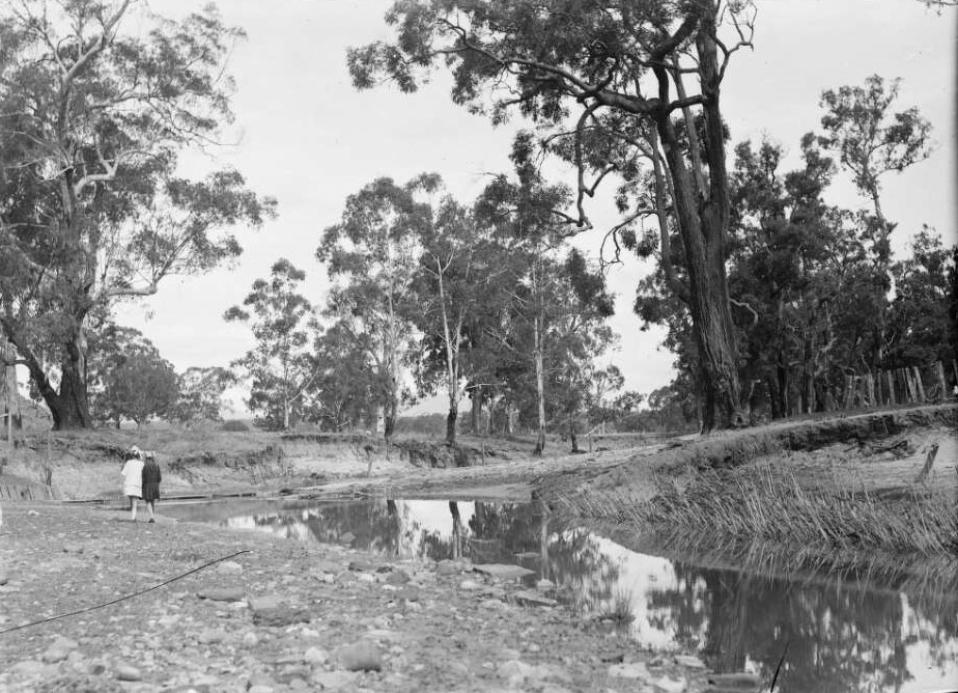
In terms of street names these suburbs of Pittwater have the least amount of honouring of family members among developers. The focus was more on what was there when they started their subdivisions, Powder Works Road for example, and the natural attributes of the place, shown in 'Waratah' street and others named for local flora, as well as an honouring of the original inhabitants - 'Taiyul' for example is the indigenous word for 'Hill' from the Kamilaroi language of New South Wales.
As with the sections of land sold with the coming of the tram tracks and then the tram itself to Narrabeen, transport making land accessible was key - anywhere anyone is placing a road increased development will follow.
This is why government bodies, in the instance of this railway plan, first opined those who had land alongside the proposed route should contribute to any costs incurred - just as they had when the building and maintenance of some roads were first shifted from state to local government - those with land in these areas were obviously going to see an increase in value and benefit thereby when the road made land sales and subdividing huge tracts of bush and paddocks more likely to have sales success and make development possible - not just alongside the route, but at its end.
NEW NORTH SHORE LINE.
A ROSEVILLE TO BARRENJOEY.
MINISTER TO VISIT PROPOSED. ROUTE. . ANOTHER RESIDENTIAL SUBURB.
There is a scheme on foot to open up an other residential suburb on the far side of Manly, centering somewhere about French's Forest. This scheme involves the building of another North Shore line— a branch of the existing North Shore line. It would turn off at Roseville, and run north-west, across the head of Middle Harbor and through French's Forest, along the heights at the back of Narrabeen lagoons. It would strike down to the coast at Rocklily; and then run on along the shore as far as Barrenjoey. There would be, probably, two connecting tramlines, one from the Spit to French's Forest, and another, an extension oft he Manly-Brookvale line, to Narrabeen. The Chief Railway Commissioner, Mr. V Johnson, is said to be in favor of the scheme; the member for the district, Dr, Arthur, strongly supports it; and the residents of French's Forest are to hold a meeting and arrange for the collection of evidence to submit to the Minister for Works. Mr.' Griffith is also understood to favor the scheme. Though, as he explained yesterday, it Is not a matter for the immediate future, still ho intends to take the next opportunity of going over the proposed route.
VALUE OF THE LINE.
In support of the scheme, it is claimed not only that a now residential area would be opened up, within a comparatively short distance of the city, but that there is fertile land in the hollows, while in many places fruit can be grown on the heights. For instance, there is good orchard land, it is said, between Roseville and Middle Harbor, and in patches through French's Forest. The line here would keep pretty well to the heights; a fairly level road runs along them now. Moreover, people on the North Shore, and even in the city would be given by this line access to the more distant beaches without having to go round through Manly. Finally, it is urged that the line would be most valuable for defence.
Dr. Arthur yesterday described the land through which the line would pass, and its probable route.
''There is a high tableland," he said, "lying on the north of Middle Harbor, which is at present practically a terra incognita to Sydney people. It is from 500 to 700 feet above sea level, and from it can be obtained magnificent views, both of the ocean and of the surrounding country. The fertility of the soil is proved by a number of orchards which have been planted there. It offers in many' ways an admirable position for a new suburb. Nine months ago, when Mr. Carmichael first mooted the idea of a working man's suburb, I pointed out to him that there was no other place within easy access of the city on which a model suburb could be placed so well."
A GARDEN CITY.
"The Government holds a large area of Crown lands in this district, and the rest of the land could be resumed at a few pounds an acre." There would therefore be every opportunity for laying out a garden city, which should receive-the dwellers in the overcrowded slums of Sydney. .The elevation is such that excellent drainage facilities are afforded, and during the summer, dwellings would be kept cool by the steady north-easter which blows with the regularity of a monsoon. Workmen could be given each a detached house, with sufficient ground for garden-purposes, and areas might be reserved for recreation grounds, and so on.
"From the head of Middle Harbor, as far as Bay View and Rocklily, extends a ridge, along which runs a tourist road now open to motor and other traffic. Settlement is possible all along this ridge, and up to the confines of Kur-ingai-Chase. But this highly desirable stretch of country -will remain unknown and unused until It is opened up by a railway. A line starting from Roseville or Linfield, on the North Shore line, and running either round the head of Middle Harbor, or crossing the western arm on a bridge, could be continued over the hill known as 'Tumbledown Dick,' on to Mona Vale, and thence to Newport and Barrenjoey. Such a line would allow for the expansion of Sydney during the next 50 years, and the Increment in value which the Government and resumed lands would obtain from it would easily pay the cost of construction.
VALUE FOR DEFENCE.
Such a line would also be of very great value from the defence point of view. In case a n enemy made a demonstration against Broken Bay, it might be necessary to hurry troops down to the mouth. This could not well be done by the tramline from Manly, because It runs' in many places along the open beach, and would therefore be exposed to shellfire from warships. I understand that the Chief Railway Commissioner is in favor of this line, and I am certain that once the Minister for Works has inspected the proposed route, his enthusiasm will be raised about it. I would suggest' that the land through which the railway would run should be resumed at once, before It falls into the hands of speculators."
Dr. Arthur has asked the residents of French's Forest to call a public meeting, in order to set about collecting data which may be of use in placing before the Minister for Works. NEW NORTH SHORE LINE. (1911, September 27). The Daily Telegraph (Sydney, NSW : 1883 - 1930), p. 11. Retrieved from http://nla.gov.au/nla.news-article238852024
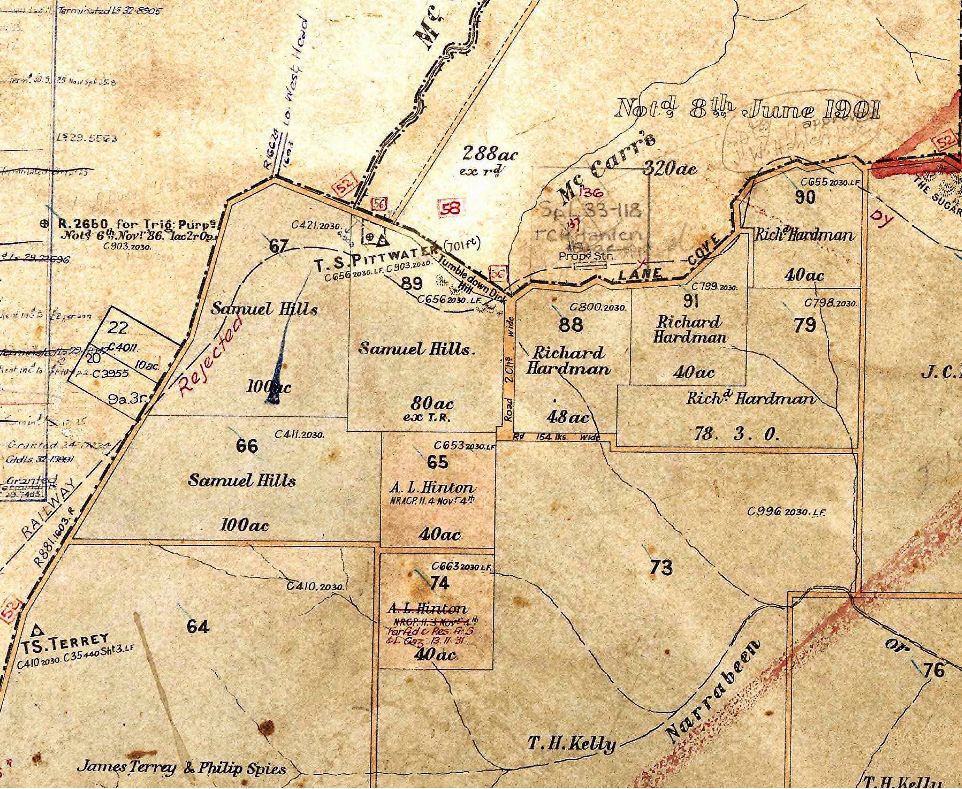
Photo: sections from 1905 Parish Map of Narrabeen showing railway dotted line - that was rejected - and 'The Sugarloaf
The tram extension from Brookvale to Collaroy and then on to Narrabeen was also another prime driver of land sales and subdivisions:
A CHARMING DRIVE.
MANLY TO BARRENJOEY.
BY BUSH AND SEA.
There are so many charming walks and drives around Sydney that it is almost impossible to say one exceeds the other in its attractions. But among the many there are few people who will dispute the claims of the country lying between Manly and Barrenjoey. A portion of this very picturesque neighborhood has recently been brought nearer the pleasure-seeking people by the tram extension to Collaroy Beach, which is within striking distance of Narrabeen. The running of a regular tram service to this point must help to popularise the district, and it is already in evidence that many more people visit this magnificent stretch of beach than was the case when only coaches provided the means of transit. The road from Manly northwards along the coast through Narrabeen, Rocklily, to Bayview, and Church Point, on the one hand, and to Newport and Barrenjoey on the other, is not so well known to the masses as it should be, although its charms are more widely enjoyed since the advent of the motor car. After leaving Manly, the tram at a distance of about three miles passes through Brook-vale along a pretty road, by sea and bush. It is an attractive little village, in fine surroundings, and in the distance may be discerned Beacon Hill, on the French's Forest-road, whence an extensive panoramic view is to be obtained. A mile and a half further on are the Oxford Falls, which find an outlet in the Narrabeen lakes. But the route proper is the Pittwater-road, and as we pass along we see the fine buildings erected and controlled by the Salvation Army, and that quiet stretch of placid water known as Deewhy Lagoon, whose surface is often covered with black swans.
Within seven miles of Manly is Narrabeen itself, whose lagoon winds for miles into French's Forest. This lagoon, however, is very shallow, and is not navigable with safety for any distance except to shallow draught boats which are available on the banks near the main road. On the ocean side is a fine beach considered safe for surf-bathers, but those who fear to venture into the open sea may fall back on the still waters of the lagoon. A number of fishermen are located here, and large quantities of fish are annually netted in the lagoon. Two miles further on we reach Rocklily, which boasts an hotel, recreation grounds, and a park, the entrance being guarded by a can-non which has done service in its day. Within the hotel itself is a fine collection of paintings, the work of a late proprietor.
After passing through Mona Vale — a picturesque settlement possessing several fine buildings, including elaborate club rooms and cottages — a branch of the road is passed which leads to Gordon and Pymble on the Milson's Point-Hornsby railway, and later the excursionist must choose his road, as one will take him to Bay View and Church Point, while the other will land him at Newport. The main road, however, continues to Newport and Barrenjoey Lighthouse. Bay View, eleven miles from Manly, and Church Point, three miles further on, are well worth a visit. From the head of the bay there is an extensive and beautiful view over the expanse of Pittwater, with Scotland Island in the mid-distance, and the hills of Kuring-gai Chase in the far distance. The roadway skirts the water to Church Point, whence the journey may be made to Newport to launch if so desired. From Church Point a view is obtained of some seven miles of water of Broken Bay and Barrenjoey, with Lion Island standing like a grim sentinel in the path. It is an ideal position for a quiet and picturesque home.
Newport — 12 miles from Manly — is also a most charming retreat, and possesses two good hotels. A short walk to the point where the road branches off to Barrenjoey, gives visitors a magnificent view, and within easy distance is Bushranger's Hill, which recalls a time when these lawbreakers, from which the elevated site takes its name, made their attacks upon the unsuspecting mailman. There is a fine sandy, ocean beach within a few minutes walk of the hotel, where surf-bathing is indulged in. Close by is the road leading to Barrenjoey Lighthouse, which occupies a picturesque and prominent position at the entrance to Bro-ken Bay, and so well-known to yachtsmen. All these places may be reached by coaches which meet the trams at Narrabeen, and it is safe to say that, once the beauties of the drive are known, and greater facilities provided for reaching them, this glorious coastline will be the most popular out of Sydney. A CHARMING DRIVE. (1912, December 19). Evening News (Sydney, NSW : 1869 - 1931), p. 12. Retrieved from http://nla.gov.au/nla.news-article113777520
The railway link did not go ahead and although mooted again in 1921, still does not exist:
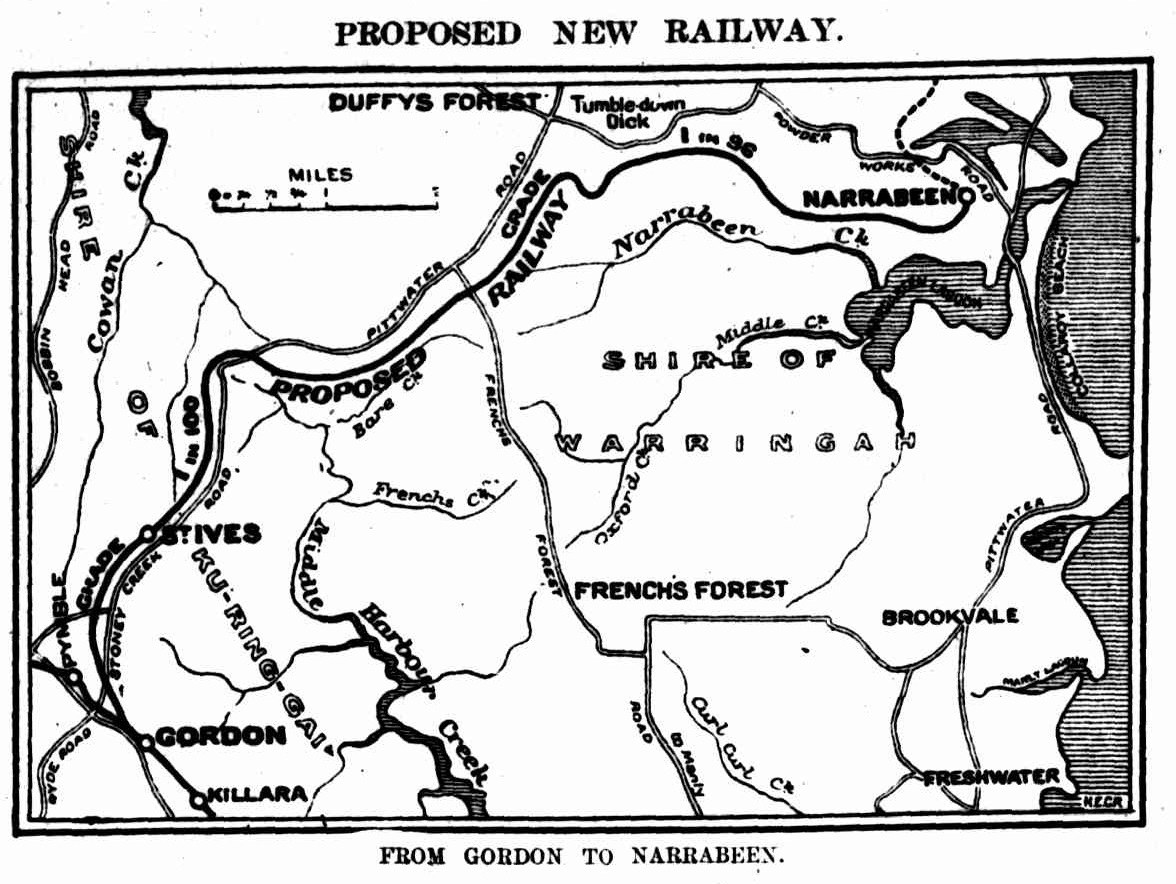
Green Hills
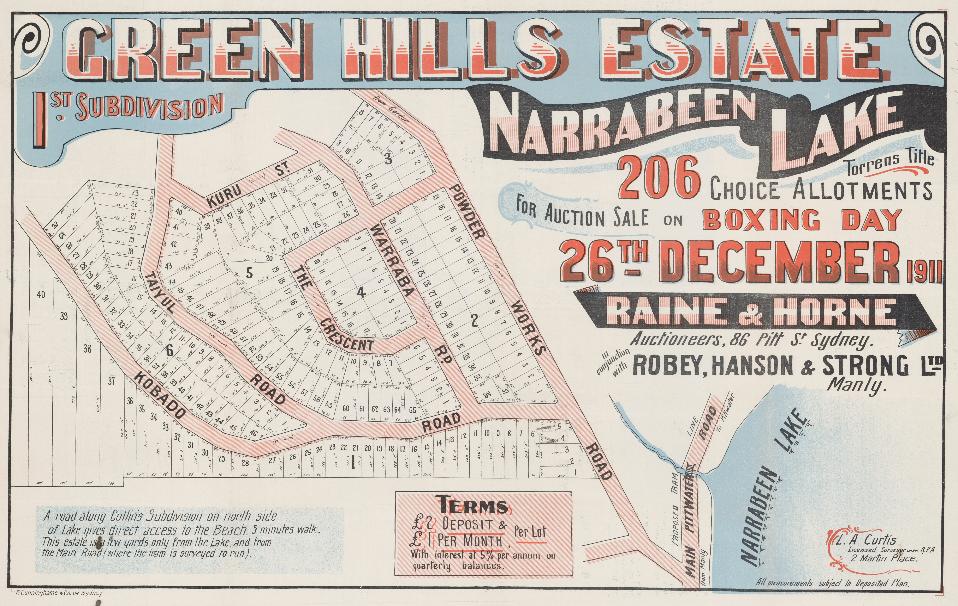
The first subdivision sale of the famous and much-sought-after Narrabeen land is at last announced. Many people who desire a seaside block have been waiting to see how the land at Narrabeen will sell, and in view of the success attained at Cronulla it is generally believed that Narrabeen will quite hold Its own with any of the ocean beach subdivisions. Boxing Day has been chosen for the first sale, when Messrs. Raine and Horne will submit the Greenhills Estate, a subdivision which contains elevated home sites with splendid ocean views. The survey has been completed, and plans are now in course of preparation.
In the same district, Messrs. Hardie and Gorman will on New Year's Day submit the Kyles of Bute Estate at Bayview, Pittwater. It is called after one of the most picturesque spots In Scotland, and the owner, who Is a "Scot," says this land, more commonly known as Baker's Orchard, always reminds him of the famous watering-place in his native heath, and this accounts for the name. There is only the road between the land and the beach.
Messrs. Richardson and Wrench have their usual two sales this afternoon. ...The Paragon Estate at Pymble is also to be offered by the firm. The land is on the heights above the station, and 12 minutes' walk from it. The proposed route of the Narrabeen railway passes the property. REAL ESTATE. NOTES OF THE WEEK. (1911, November 18). The Sydney Morning Herald (NSW : 1842 - 1954), p. 13. Retrieved from http://nla.gov.au/nla.news-article15289911
This brochure, with its wonderful photographs, lend an insight into how this area alongside Powderworks road and down to Narrabeen Lagoon looked then - we even get a view out over the Pittwater road of 1911:
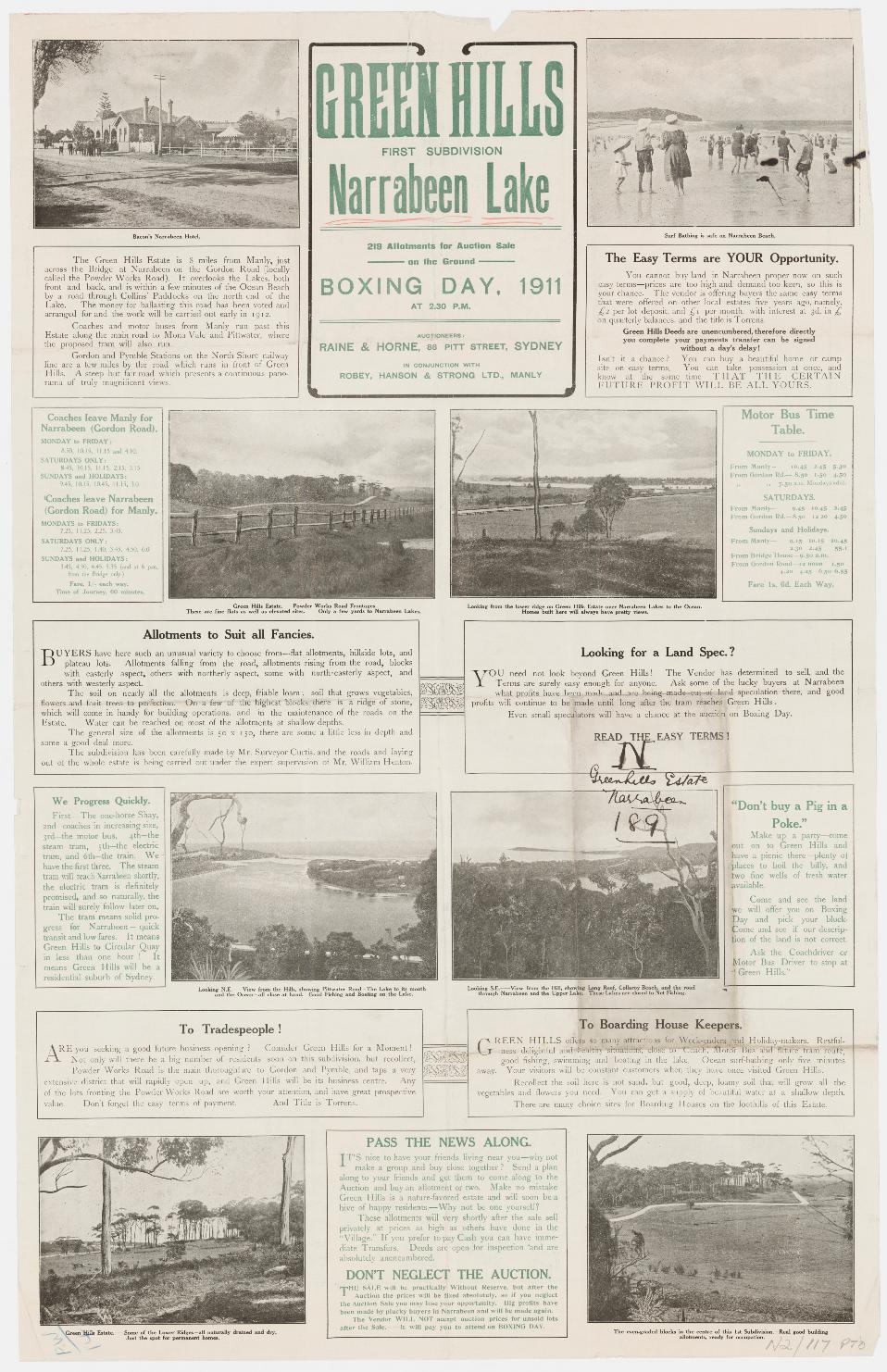
Green Hills Estate 1911 Brochure, Item No.: c050370042 from Narrabeen Subdivision Maps album, courtesy State Library of NSW - and enlarged sections from to show details in photographs
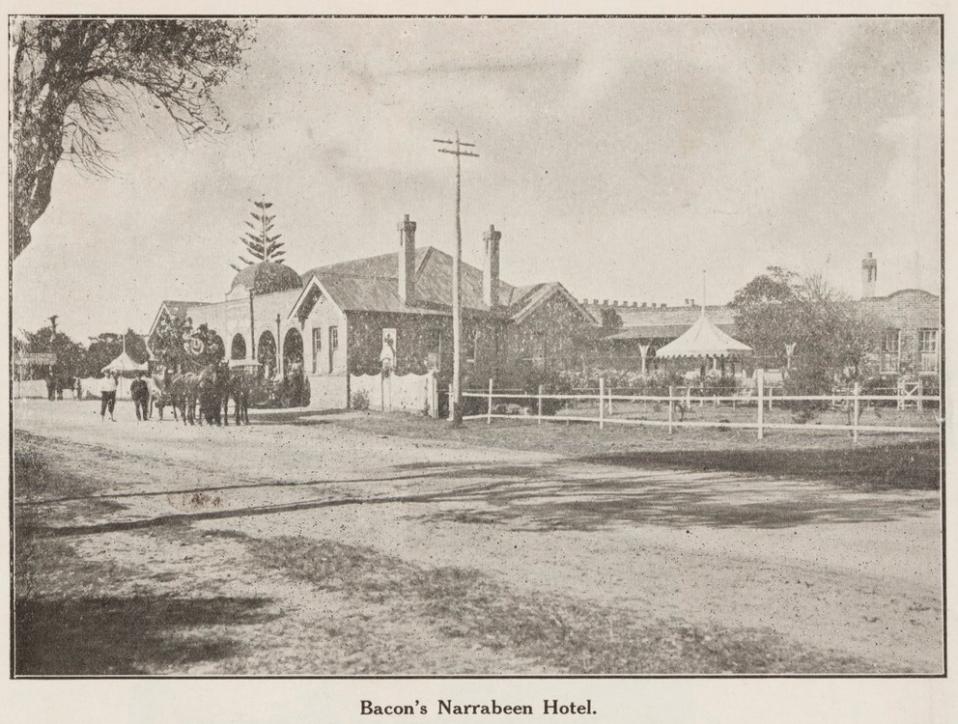
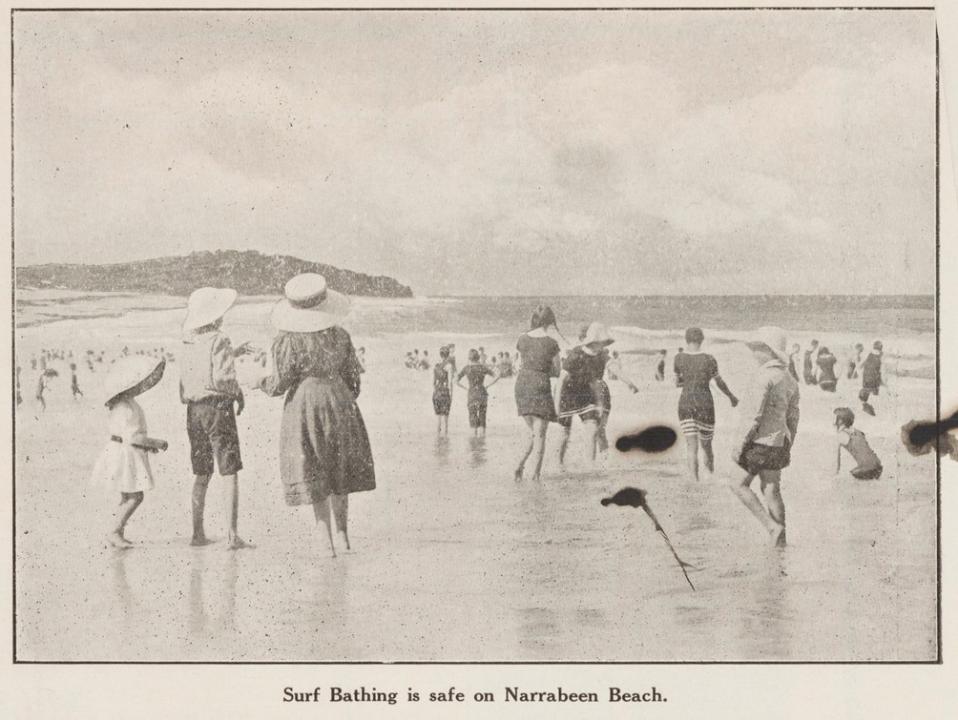
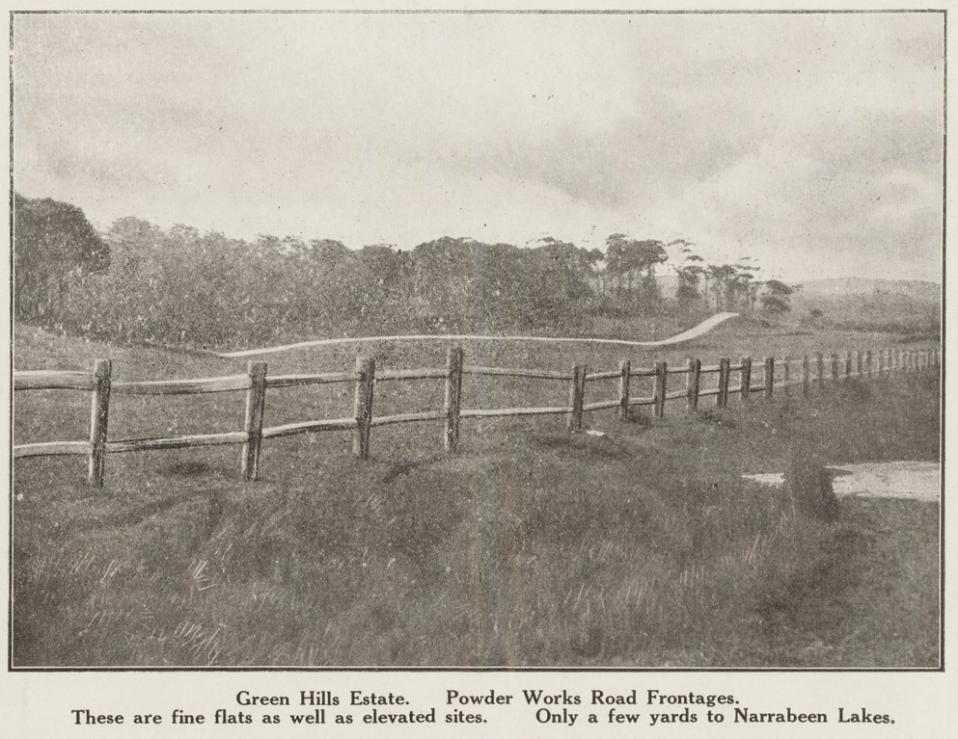
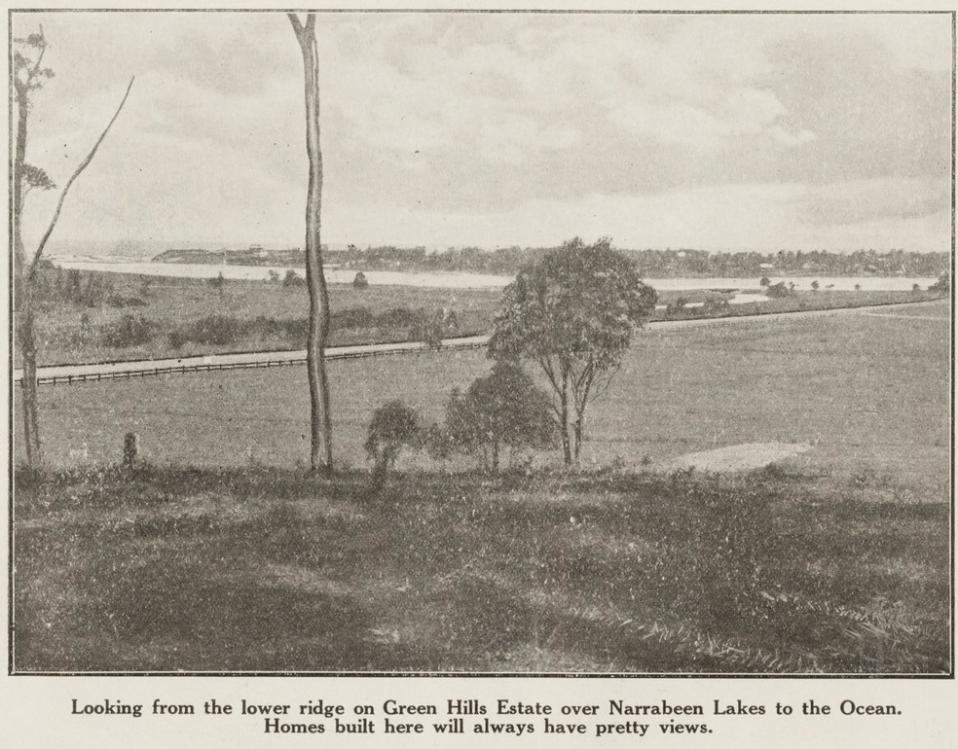
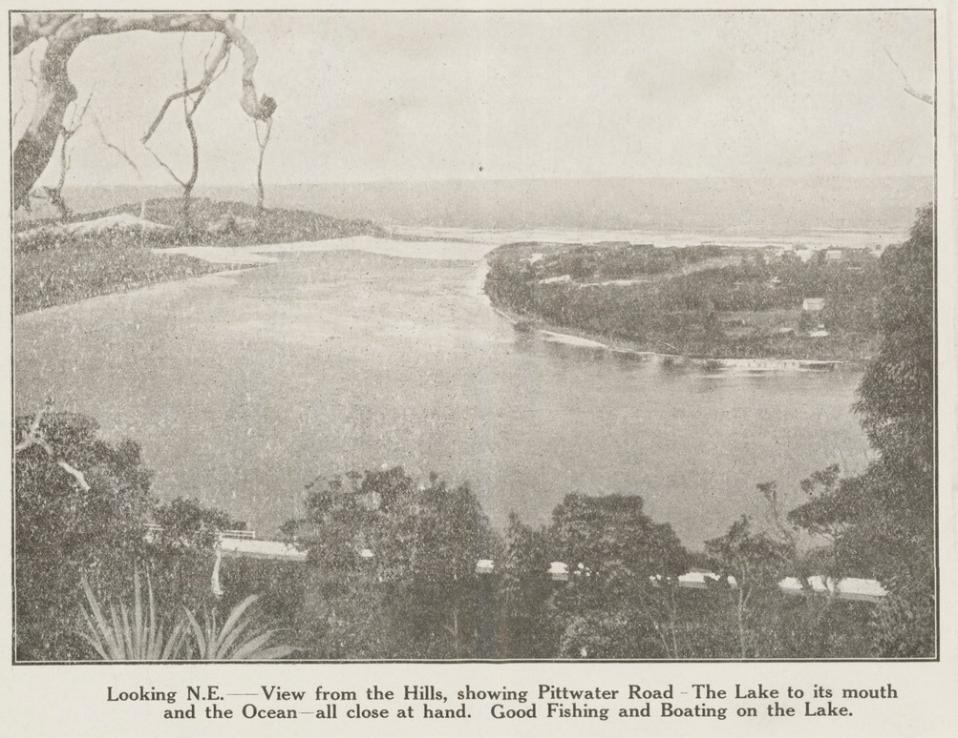
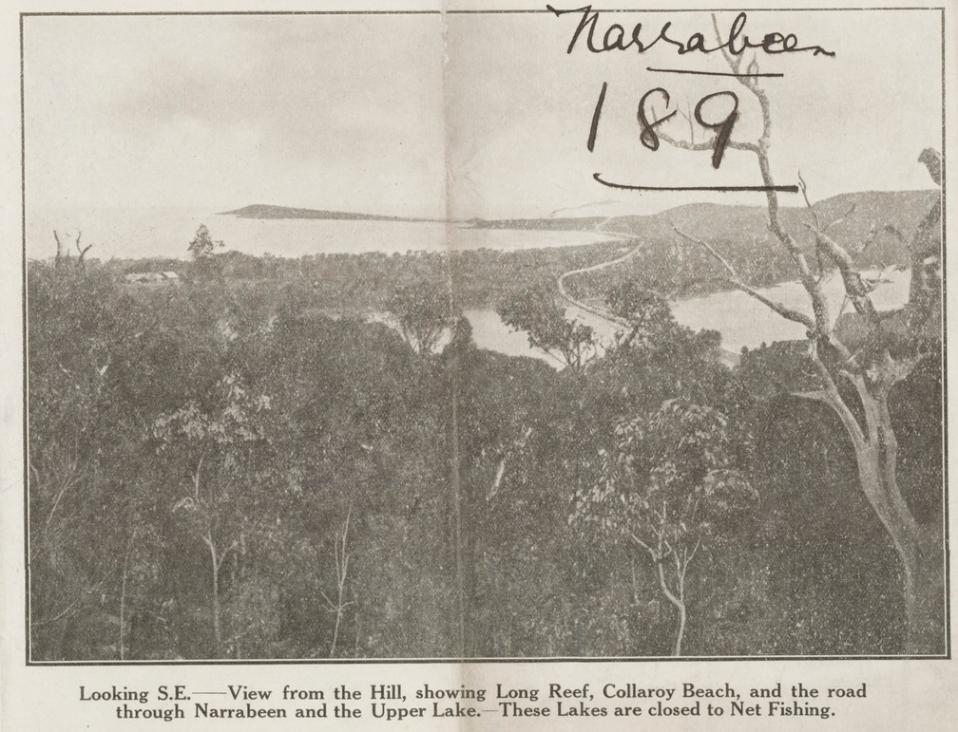
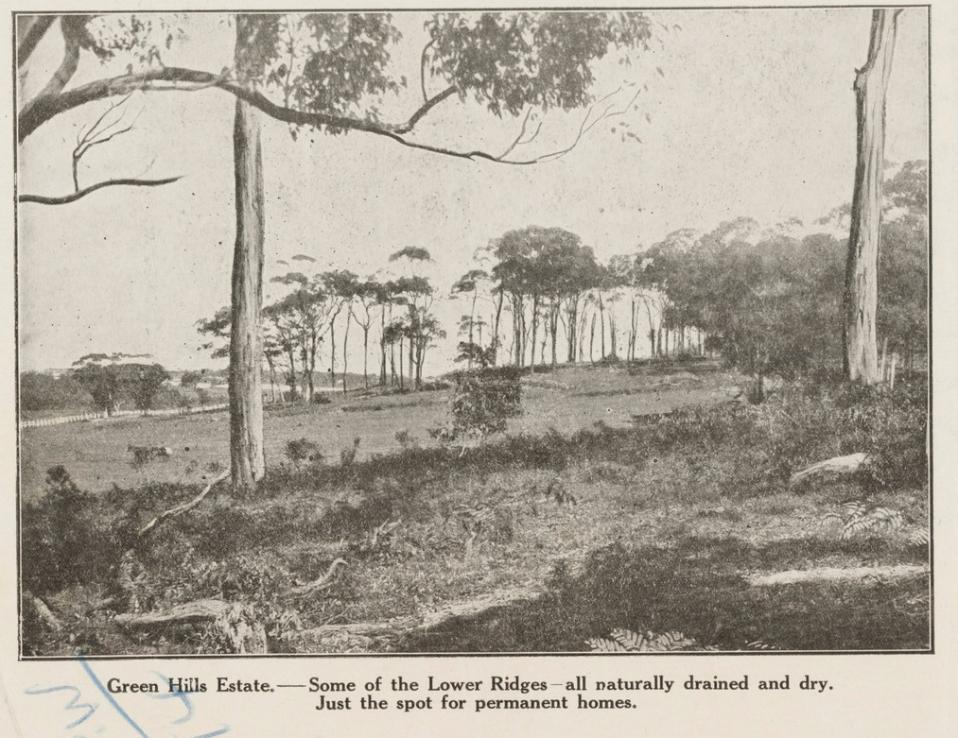
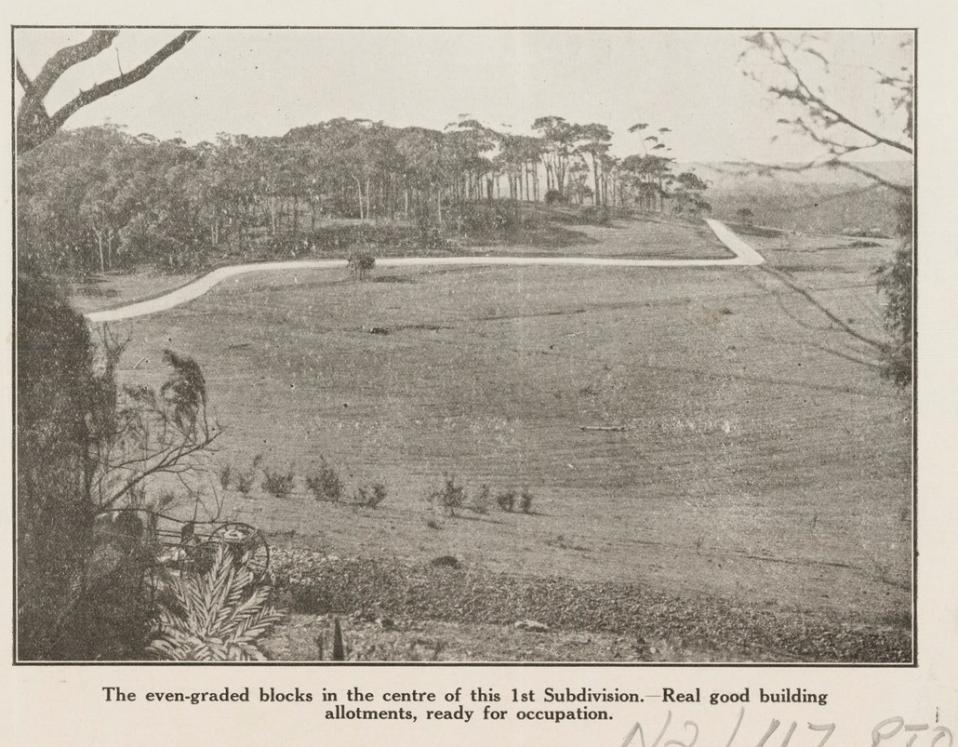
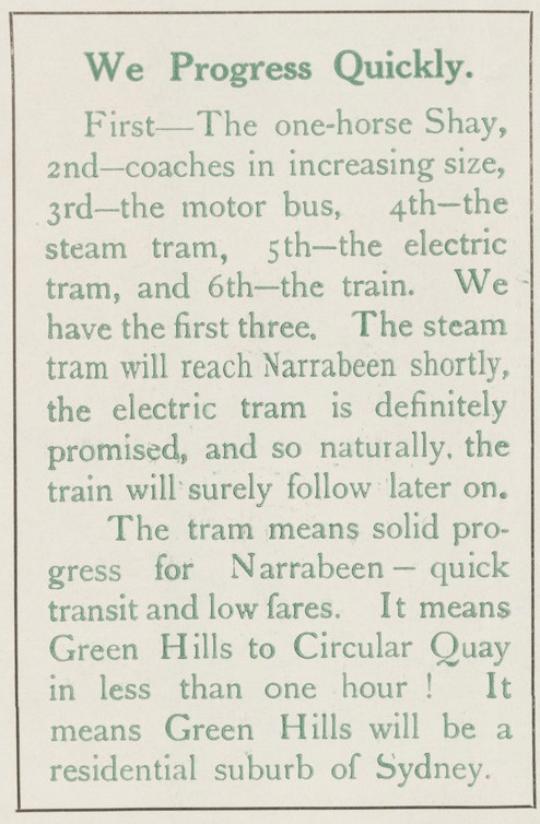
.jpg?timestamp=1561514007780)
.jpg?timestamp=1561514076490)
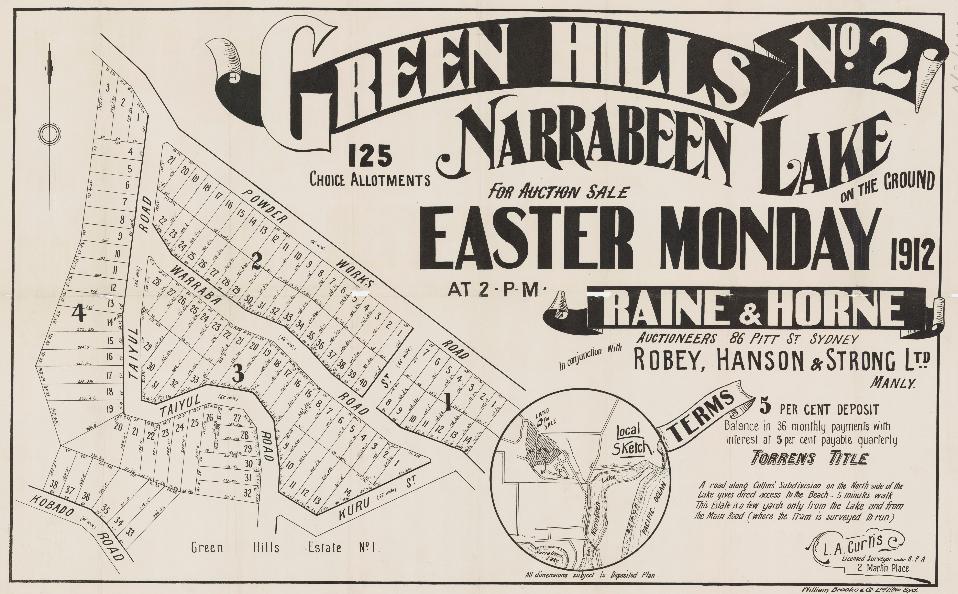
Green Hills No. 2 Easter sale, Item No.: c050370147, from Narrabeen Subdivision Maps album, courtesy State Library of NSW
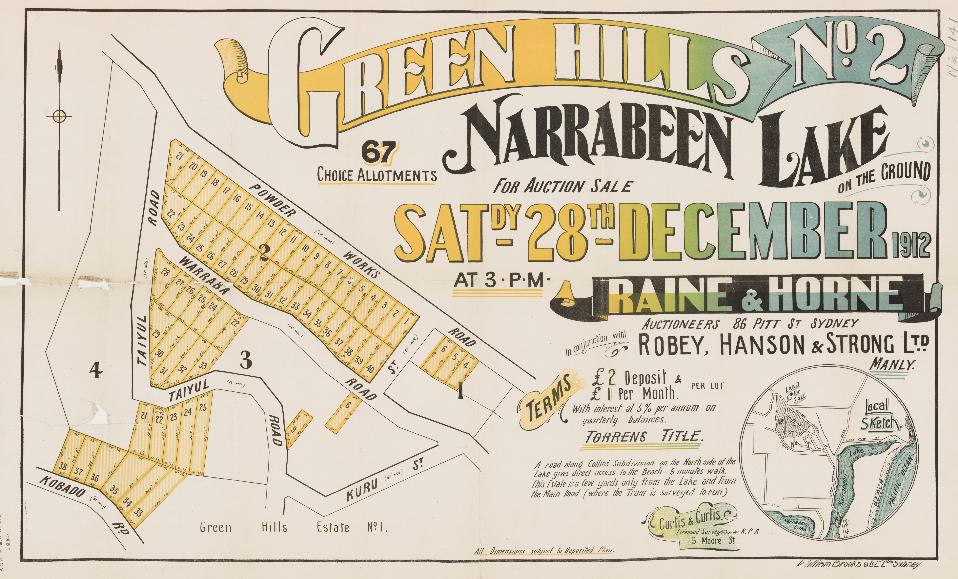
Green Hills No. 2 1912, Item No.: c050370146, from Narrabeen Subdivision Maps album, courtesy State Library of NSW
Kobado Road
Taiyul Road: indigenous word for 'Hill' from the Kamilaroi language of New South Wales.
Warraba Road: 'spear'
SHIRE OF WARRINGAH.
Proposed Special Loan of £32,000.
NOTICE is hereby given that it is the intention of the Warringah Shire Council to apply for authority, under section 180, Local Government Act, 1919, to borrow the amount of £32,000 for the purpose of constructing the undermentioned roads, and carry out the undermentioned work, within A Riding of the Shire, and for purposes incidental thereto: —
1. Barren joey-road, from Neptune-street, Newport to Beach-road, Palm Beach 21,100
2. Warriewood-road, from Pittwater-road to Vineyard-street — . 1,700
3. Powderworks-road (a) from Pittwater road to the E end of Kobado-road; (b) Kobado-road for its entire length, and (c) Powderworks-road from the W end of Kobado-road to the junction with, the Gordon-Mona Vale road '. 4.000
4. Gladstone-street, Newport 1,000
5. Drainage of Black Swamp, Mona Vale 1,900
6. Resumptions, surreys and contingencies 2,300
£32,000
(Included in the estimate of £21,100 for Barrenjoey-road is a sum of £4.000 for the formation, only, of proposed deviations of that road, which itsm is taken into consideration in fixing the differential rate referred to hereunder.)
The interest payable on such loan shall not exceed six sand a half (6\) per cent, per annum, and it is proposed to arrange the loan on terms which shall provide for the repayment of principal and the payment of interest, combined, in equal half-yearly instalments extending over a period of ten years. The approximate amount of each such instalment will be £2,200 18s. 6d.
To provide the sum necessary for such instalments it is proposed to levy a local loan rate of one and four-tenths penny (1 4/10ths d.) in the £ on the unimproved capital value of all ratable land within that portion of A Riding described in the subjoined Schedule, and nine-tenths of a penny (9/10ths. d.) in the £ on the unimproved capital value of all ratable lands in the remainder of the Riding, the extra impost on the lands described in the Schedule being to cover the instalments of so much of the principal (£4,000) of the loan as it is proposed to expend on the formation of the deviations of the Barrenjoey-road. Should these rates not provide sufficient for the purpose, the balance "will be paid from the General Fund of the Council. The total unimproved capital value of all ratable lands in the area described in the Schedule is £207,842, in the remainder of the Riding, £737,320, the total for the whole Riding being £1,005,162.
Plans, specifications and reports giving details of the proposal, may be inspected at the Shire Hall, Brookvale, at any time during office hours.
Within one month of the publication of this notice, any number not less than 25 per cent, of the ratepayers of A Riding may petition the Council to take a poll of ratepayers, either as to whether the ratepayers approve of the loan, or as to whether the loan rate shall be on the unimproved capital value or the improved capital value, or on both questions. The number of ratepayers enrolled for A Riding is 3,892.
Schedule.
All that land bounded on the north by the entrance to Broken Bay, on the east by the Pacific Ocean, on the west by Pittwater Bay, and on the south by the southern boundaries of Village Reserve 18,805, parish portion 21, block VI of the southern division of Pittwater Estate, and parish portion 31.
E. G. JAMIESON.
Shire Hall, Brookvale, Shire Clerk.
25th September, 1925.
1263 £4 4s. SHIRE OF WARRINGAH. (1925, October 2). Government Gazette of the State of New South Wales (Sydney, NSW : 1901 - 2001), p. 4246. Retrieved from http://nla.gov.au/nla.news-article220255392
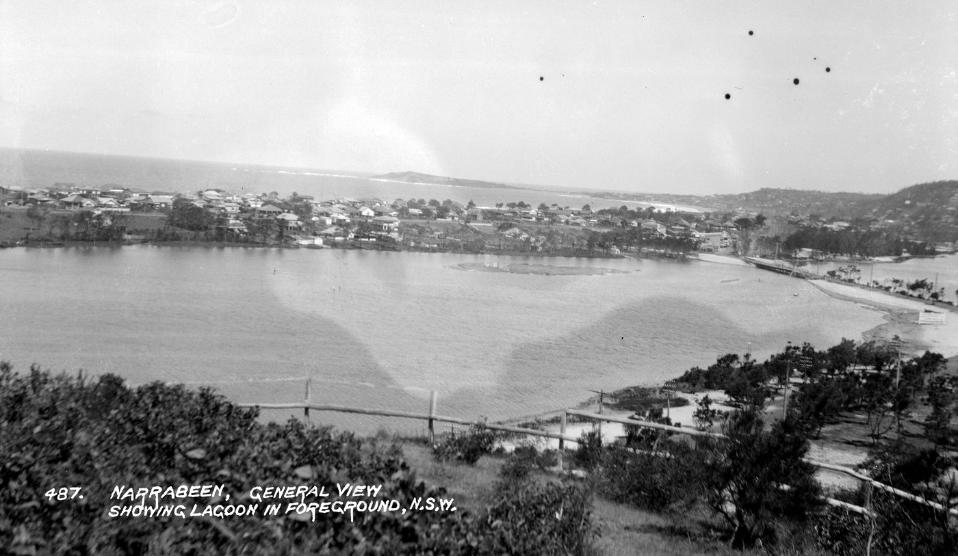
NARRABEEN FLATS FLOODED.
BOY SCOUTS' EXPERIENCES.
The heavy rain inundated all the low-lying portions of the district between Manly and Newport. All day yesterday anxiety prevailed at Narrabeen lest the lake should over-flow, for although a channel was opened out to the sea last week the heavy seas poured the water into the lake faster than it could escape. The creeks running into the lake, Deep Creek, Middle Creek, and South Creek were carrying great volumes of water, but when the tide receded the outgoing water was given a chance to escape into the ocean. Some cottages along the banks of the lake were slightly damaged, but no serious dam-age in that area was reported.
Many buildings in the Green Hills district at Narrabeen were flooded, and in the vicinity of Wetherill-street and Ramsay-street most of the homes were surrounded by water, and difficulty was experienced in keeping the water from getting inside the dwellings. A stable, owned by Mr. Arthur Larkin, in Wetherill-street, was washed away, and some of the gardens were four feet under water.
About 100 Boy Scouts camped at Deep Creek, Narrabeen, had an exciting experience during Friday night and Saturday morning, and they decided to strike camp on Saturday afternoon and return to their homes. During Friday night a tree fell near the scouts' tents, but fortunately none of the boys were injured.
The tramline between Manly and Brookvale was under water during Saturday morning, and traffic was held up for several hours. A channel about 30 yards wide and eight feet deep was made in the beach at North Steyne, Manly, by the flood waters from the Manly lagoon. The Manly golf links were under water, and several shops at Manly Vale,were flooded. NARRABEEN FLATS FLOODED. (1927, April 18). The Sydney Morning Herald (NSW : 1842 - 1954), p. 8. Retrieved from http://nla.gov.au/nla.news-article16370449
Department of Public Health,
Sydney, 7th January, 1930.
PUBLIC HEALTH ACT, 1902, SECTION 55.
Unhealthy building land, being part of Green Hills Estate, d.p. 6,462, fronting Powder Works road, Kobado-road, Warraba-road, and The Crescent, at Narrabeen, Warringah Shire.
THE Board of Health have reported that after due inquiry they are of opinion, that it would be prejudicial to health if certain land situated in the Shire of Warringah, and described in Schedules hereunder, were built upon in its present condition.
The Board of Health have further reported that in order to render such land fit to be built upon it is necessary that:—
(a) an efficient system of drainage be constructed to carry off all water passing over the land;
(b) the surface of the land described in Schedule be raised with clean soil or sand to a height of 7 feet above mean sea level;
(c) the surface of the land described in Schedule 2 be raised with clean soil or sand to the height of the adjoining land falling to a height of 7 feet above mean sea level at the south-western side of The Crescent;
(d) floors to be laid on joists, the undersides of which shall be not less than 18 inches above the surface of the land when raised;
(e) the work to be done to the satisfaction of the Board of Health.
Now, therefore, in pursuance of the power and authority vested in me by section 55 (1) of the Public Health Act, 1902, I hereby declare that such land shall not be built upon until the measures above referred to, which are also specified in a document deposited in the office of the Local Authority (the Council of the Shire of Warringah), and open to the inspection of any person, have, been complied with or until this notice has been revoked by me.
RICHARD ARTHUR,
Minister for Public Health.
Schedule No. 1.
All that land being part of the Green Hills Estate, d.p. (5,4(32, situated in the Warringah Shire, comprised within the following boundaries:—Commencing at the northernmost corner of lot 1, section 3, Green Hills Estate, d.p. 6,4(52; and bounded thence on the northwest b,y the northern-western boundary of lot 1 southwesterly to the westernmost corner of lot 1; thence by a line south-westerly to a point on the south-eastern side of lot 14, being 33 feet from the southernmost corner of lot 14; thence by a line south-westerly to the northernmost corner of lot 8, section 4; thence southwesterly by the northern and western boundaries of lot 8, and by the northern boundary of lot 12 to the westernmost corner of lot 12, section 4; thence by The Crescent south-easterly to the southernmost corner of lot 17, section 4; thence by a line and the south-western sides of lot <5 and lot 5, section 5, south-easterly to the southernmost corner of lot 5; thence by lines southeasterly to the following points in succession:—The easternmost corner of lot 3, section 5; the south --western corner of lot 36, section 2, being the northeastern intersection of Warraba-road and Kobado-road, the north-western corner of lot 5, section 1, and the easternmost corner of lot 4, section 1; thence by Powder Works road north-westerly, to the point of commencement.
Schedule No. 2.
All that land being part of the Green Hills Estate, d.p. 6,462, situated in the Warringah Shire, comprised within the following boundaries:—Commencing at the southernmost corner of lot 20, section 5, d.p. 6,462; and bounded thence on the north-east by The Crescent southeasterly to the northernmost corner of lot 12; thence by the boundaries of lot 13 south-westerly, north-westerly and north-easterly to a point being 50 feet rectangularly distant from the south-western side of The Crescent; thence by a line north-westerly, parallel to The Crescent, to a point on the southern boundary of lot 20; thence by that boundary south-easterly, to the point of commencement. PUBLIC HEALTH ACT, 1902, SECTION 55. (1930, January 10). Government Gazette of the State of New South Wales (Sydney, NSW : 1901 - 2001), p. 103. Retrieved from http://nla.gov.au/nla.news-article223072952
HOME DESTROYED BY NARRABEEN BUSHFIRE
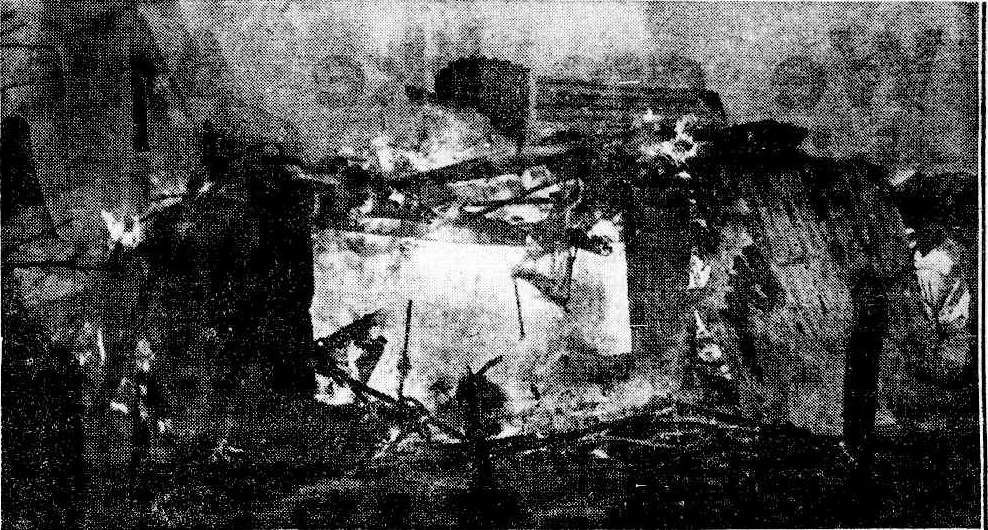
ONE OF TWELVE HOUSES destroyed by bushfires at the Green Hills Estate, Narrabeen, during the weekend. Hundreds of people fought the fires. HOME DESTROYED BY NARRABEEN BUSHFIRE (1944, December 25). The Daily Telegraph (Sydney, NSW : 1931 - 1954), p. 5. Retrieved from http://nla.gov.au/nla.news-article248072529
Elanora
Elanora is a word that appears throughout Australia, many holiday and boarding houses places being named 'Elanora' in Victoria and Queensland during the same era it emerged as a name for this place in Pittwater during land sales. There is a suburb in Queensland that is similarly named.
Eleanor as a name also has a place in Old French with variants stemming from the 12th century of 'Eleanora, Eleanore, Elenora, Elinor, Elnora' - in this context the name has a meaning of 'Light, Torch, Bright' - so people may also conjecture that the early history and associations of people who passed this way, including some of the Frenchmen such as Lix and Houreaux leaving echoes of their culture in their wake (see Yabbying in Warriewood's Creeks) - or even Von Bieren who may once have lit up the hills above the valley with light, or even a reference to the stunning light that does fill this place and its vista seawards, may also have inspired this naming.
There is no direct link to any language of the original aboriginal people who inhabited this particular place and the name given, few of those words survive and this isn't among them.
No. 17,037. APPLICANTS :—George Scales and David Lindesay Aitken, both Sydney. LAND : — County Cumberland, parish Manly Cove, shire Warringah, 96 acres 2 roods 7 1/4 acres, on Narrabeen Creek, near Narrabeen Lagoon,—land granted as 30 acres (portion 51 of parish), to James Wheeler, and 50 acres (portion 48 of parish), to John William Alexander White; adjoining property of estate late T. H. Kelly and Crown Land. NOTICE UNDER REAL PROPERTY ACT. (1912, April 10). Government Gazette of the State of New South Wales (Sydney, NSW : 1901 - 2001), p. 2230. Retrieved from http://nla.gov.au/nla.news-article227591158
In 1924:
LINGHAM & GILFORD MANLY'S Leading Real Estate Agents for sound investments .WE WISH. TO PLACE BEFORE. YOU ELANORA ESTATE (NARRABEEN) An Estate where large profits are certain. - Narrabeen- Is fast becoming another Manly . Further particulars from our AGENT who knows The Estate— W. J. THOMAS, Narrabri. Advertising. (1924, July 3). The North Western Courier(Narrabri, NSW : 1913 - 1955), p. 3. Retrieved from http://nla.gov.au/nla.news-article133467250
ELANORA ESTATE
We wish to draw attention to a notice in our business columns advertising the Elanora Estate, Narrabeen, near Manly. Land in this locality has proved itself to be far ahead of any other part of the metropolis for sound investment, and with the advent of the North Shore Bridge, the Spit Bridge, and the Gordon to Narrabeen railway, which will run right past the estate, will undoubtedly make Narrabeen, with its picturesque lake, good surfing beach, and panoramic scenery, one of the most popular and valuable suburbs of Sydney. Messrs Lingham and Gilford, land and estate agents, Manly, are the city agents. Mr F. H. Hewitt is the local agent. ELANORA ESTATE. (1924, August 5).Singleton Argus (NSW : 1880 - 1954) , p. 2. Retrieved from http://nla.gov.au/nla.news-article80954701
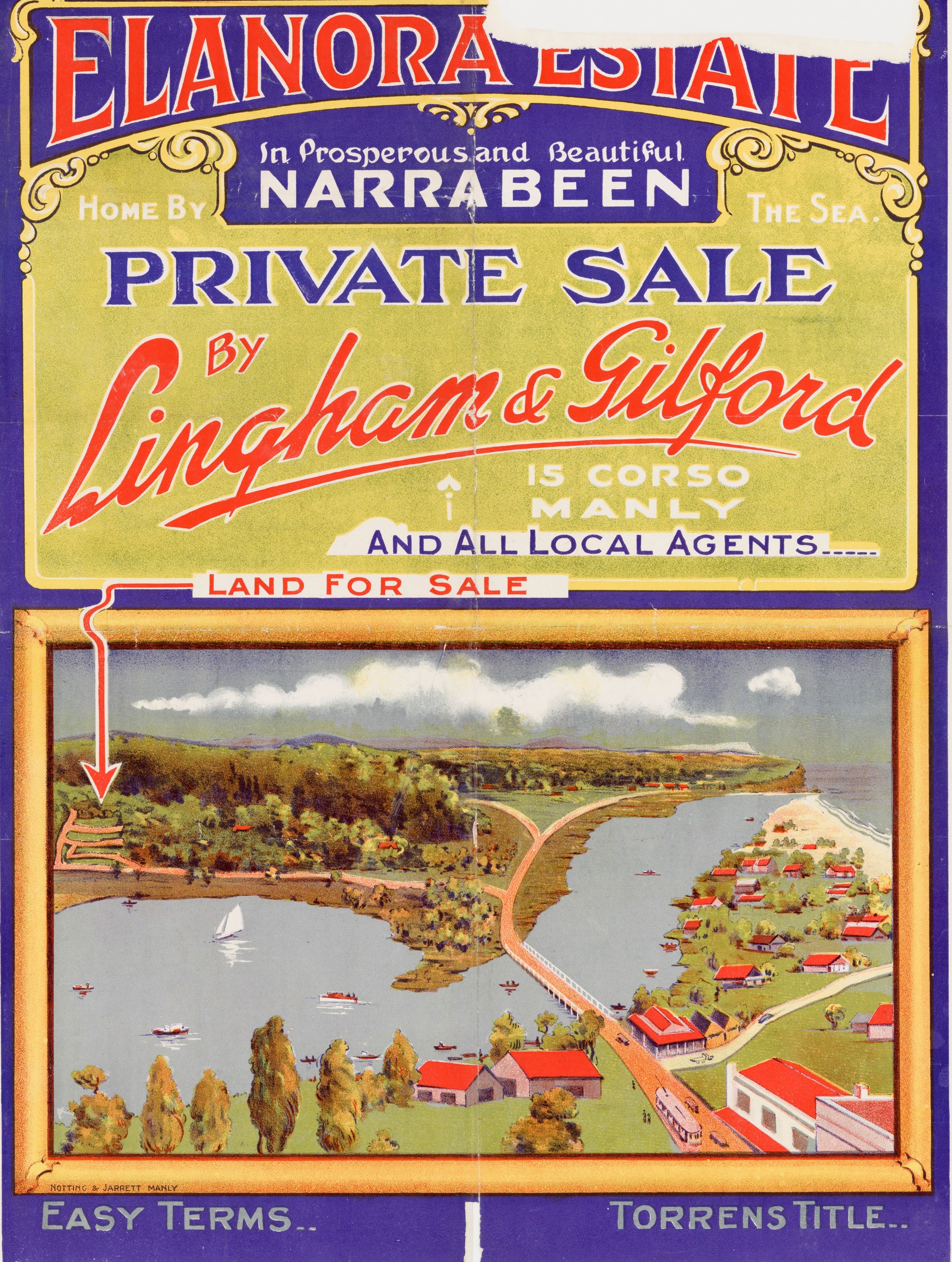
.jpg?timestamp=1561507889101)
Elanora Estate Brochure. Item No.: c050370110, pages Front and back outer - and enlarged sections from to show details, from Narrabeen Subdivision Maps album, courtesy State Library of NSW
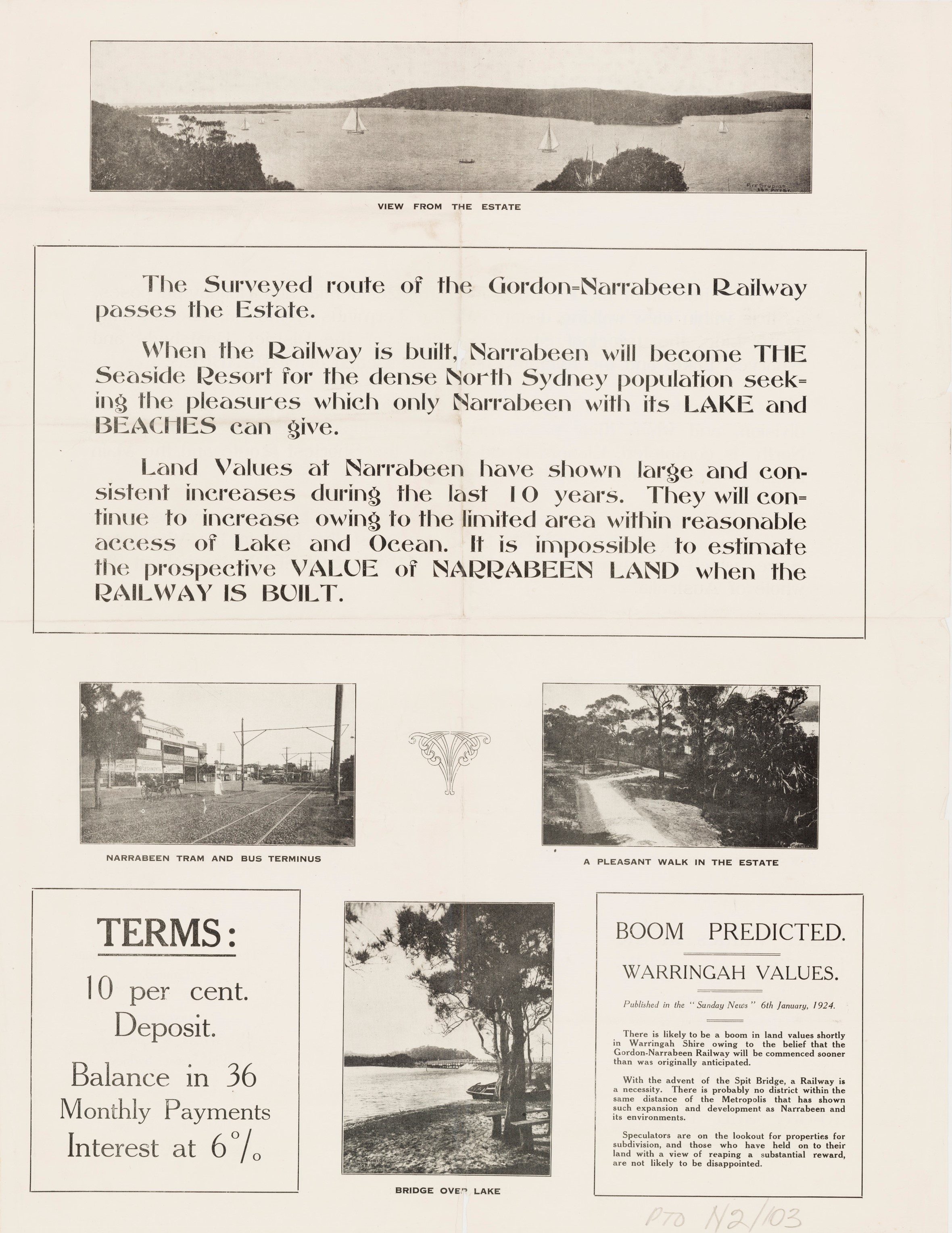
.jpg?timestamp=1561508067133)

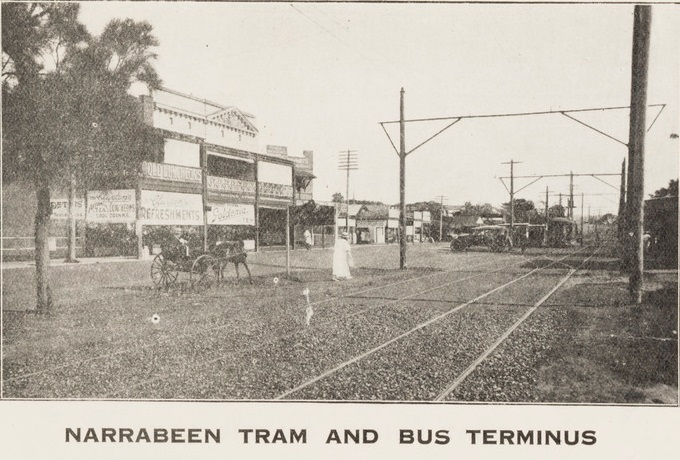
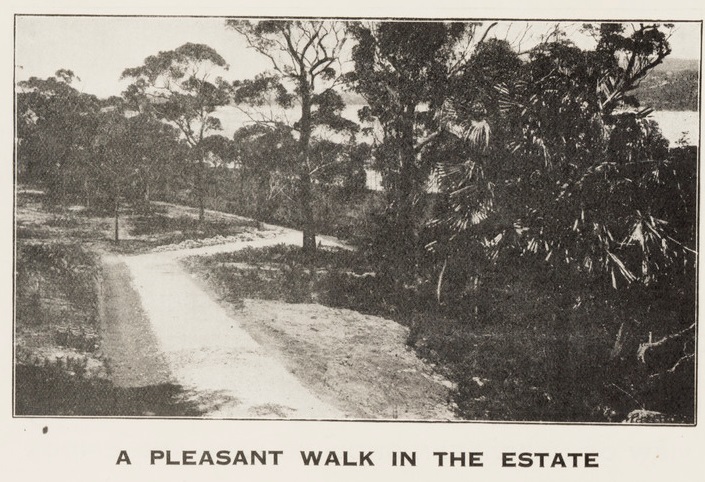
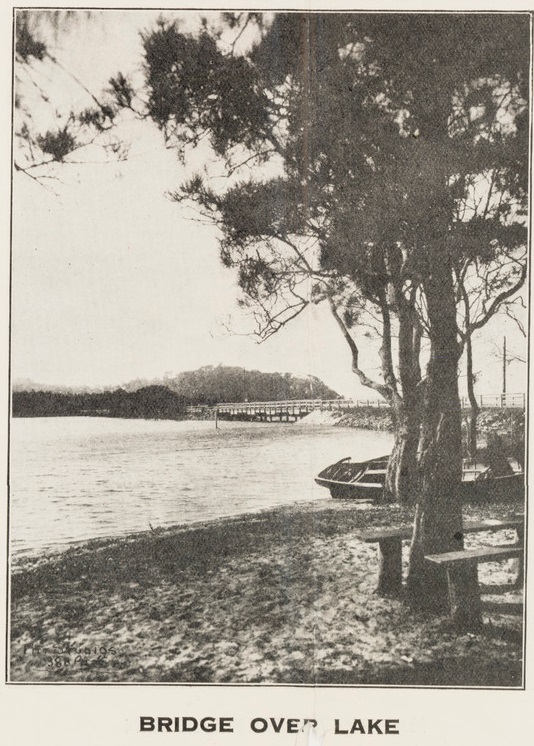
Elanora Estate Brochure. Item No.: c050370111, inner pages second and third - and enlarged sections from to show details, from Narrabeen Subdivision Maps album, courtesy State Library of NSW
The second subdivision:
ELANORA ESTATE - 300 Allotments for Sale
Elanora Estate, Narrabeen, is a portion of 640 acres purchased last year by a company composed of wealthy and mostly retired gentlemen for the purpose of subdividing into building allotments.
Last year the first subdivision was opened to the public for purchase. This subdivision contained 127 allotments, which were sold within six weeks of the date of opening. The prices ranged from £1 .to £3/3/ a' foot. The majority of purchasers are people living in and around this district, and every block sold was inspected before purchase. The company have now opened up a second subdivision, which contains about 300 allotments, the prices ranging from 25/- to 50/- a foot. An amount of approximately, £10,000 has been expended on the subdivisions, by way of clearing and road-making, surveying, etc. .
Every allotment has a frontage to a properly constructed 66ft. road, and' practically every allotment has permanent panoramic outlooks of lake and ocean.
FINE FRONTAGES.' The surveyors in laying-out this estate have taken great care not to repeat the mistakes which were made in the majority of our present-day suburbs; Every allotment has an area of over 5000 feet, and has a frontage of '50 feet. There are no narrow roads or laneways, and this should be an inducement to any person desirous, of becoming a land-owner. ELANORA ESTATE. (1925, February 1). Sunday Times(Sydney, NSW : 1895 - 1930), p. 7 Section: Social and Magazine Section. Retrieved from http://nla.gov.au/nla.news-article128164075
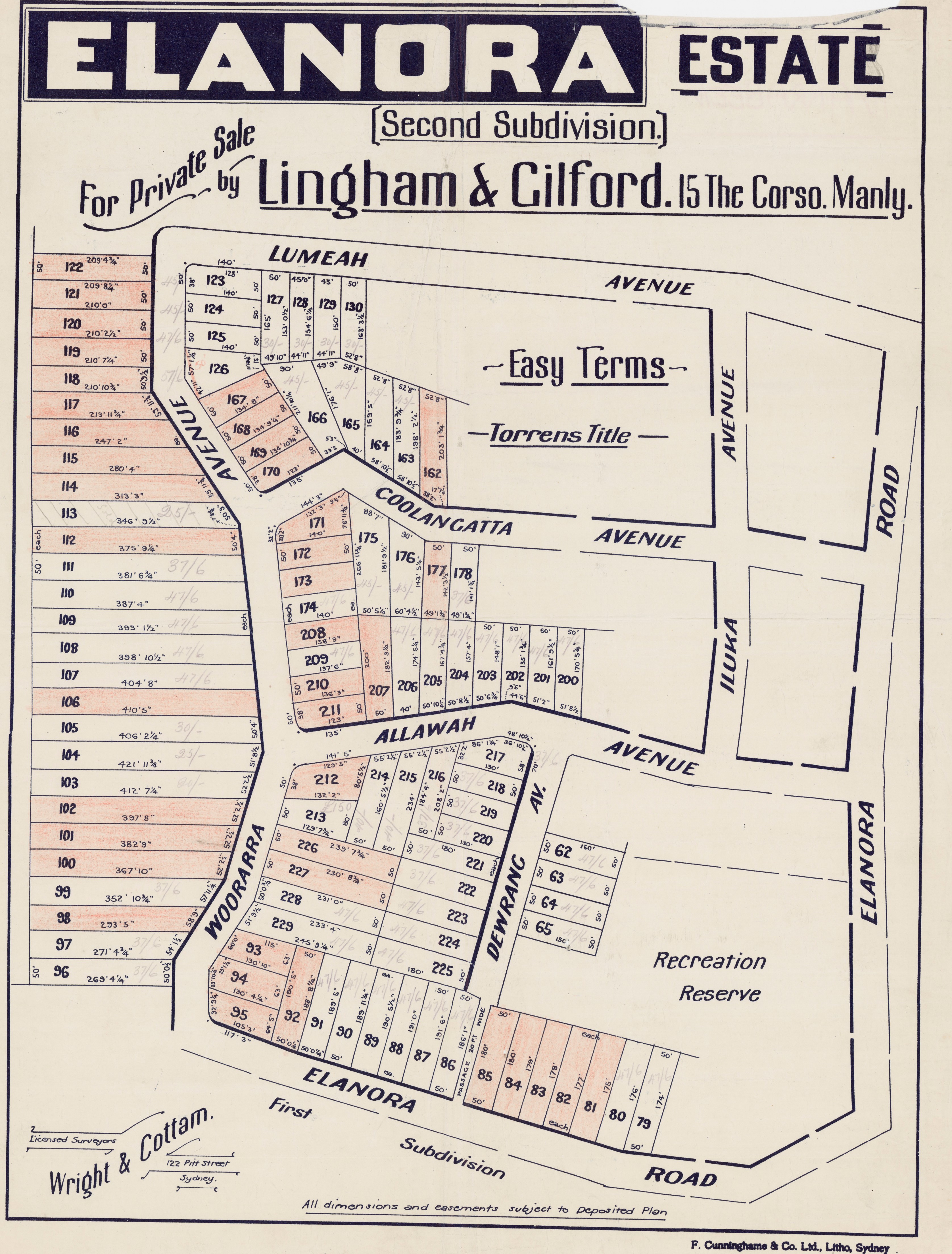
Elanora 2nd subdivision, Item No.: c050370118, from Narrabeen Subdivision Maps album, courtesy State Library of NSW
And an announcement of the making of 'Sydney's first Country Club':
ELANORA COUNTRY CLUB
One of the most interesting projects now afoot is that for the establishment of the Elanora Country Club, on the heights above the Narrabeen Lakes, on Sydney’s twelve-mile zone. Workmen are encamped on 200 acres of the ground, clearing it for the purposes of the club, and invitations to membership are about to be issued.
The clubhouse design, which has been drawn up be Messrs. Robertson and Marks, a Sydney firm of architects, is imposing and graceful. It will stand at approximately the same height as Pymble, yet will be within a few minutes car drive of the surf. Residential accommodation is to be provided at the clubhouse for both men and women members, and the membership will include a umber of well-known country people. Golf, polo, croquet, tennis and bowls are planned as features of the recreational life of the club, and there will be important social functions in the evenings. The club, it is considered, will be an ideal meeting place for city and country people, and the grounds will provide facilities for various sports fixtures, not only local but interstate and international in their character. ELANORA COUNTRY CLUB. (1927, August 15). Newcastle Morning Herald and Miners' Advocate (NSW : 1876 - 1954) , p. 3. Retrieved from http://nla.gov.au/nla.news-article135600749
The Elanora Country Club used a wooden house structure on the property originally, prior to the first clubhouse being built.
One article indicates this structure may once have been a convalescent home owned by a lady who also owned Bay View House, Cook's River - another hospital then called, using terms we wouldn't employ nowadays - a 'Private Lunatic Asylum' - more on that below.
BEAUTIFUL ELANORA HEIGHTS AT NARRABEEN
During the week a representative of the 'Sunday Times' was afforded the opportunity of seeing the beautiful Elanora Heights Estate, at Narrabeen. There can be little doubt that there is no other, land so ideally situated, within reasonable access of Sydney, which is so desirable.
The property has been purchased by Land Properties and Investments, Ltd. It consists of 518 acres of land, Torrens Title, and commands delightful views of the ocean and the lake. The company is offering £100,000 shares to the public, with a security of land valued to produce, on subdivision, £300.000.Here are some reasons why you should buy shares in Land Properties and Investments Ltd :
1. No promoters' shares have been or will be issued, and no cash paid to intermediary parties.
2. The company is already registered, and 25, 000 shares were underwritten before the prospectus was issued.
3. The company is already the possessor of a valuable property of 518 acres of land, Torrens Title, known as the Elanora Heights Estate. This was purchased for £70.000. and is independently valued to yield a net return of approximately £130,000.
4. The strength of the directorate lends increased value to the proposition. Not only does the value of the present property represent to the shareholder a tangible asset — land valued to return £230 for every £100 invested — but assurance is thus given that this first operation will be followed by other profitable operations, in all of which shareholders will benefit.
5. Each of the Directors has recently doubled his share holdings.'
6. A conservative estimate shows a net profit of at least £130,000.
7. On the property will be situated Sydney's first Country Club.
Mr. E. L. Walter, organising underwriter, will gladly give full particulars of this remarkably attractive investment to any reader of the 'Sunday Times' who calls at the office, National Mutual Building, 350 George street. If you live in the country, write for full descriptive literature of the Elanora Heights Estate. There is money in land such as this is. BEAUTIFUL ELANORA HEIGHTS AT NARRABEEN. (1927, November 27). Sunday Times (Sydney, NSW : 1895 - 1930), p. 10. Retrieved from http://nla.gov.au/nla.news-article128519218
One of the Directors of the above named Land Properties and Investments, Ltd was Thomas Alfred John Playfair (1890-1966), a committee-member of the Royal Sydney Golf Club, keen golfer, excellent horseman, who led the formation of the above proposed Elanora Country Club and was president 1928-65. Mr. Playfair, a Brigadier after serving in two world wars, had a weekend home built on the estate.
LAND PROPERTIES AND INVESTMENTS LTD.
An abridged prospectus of Land Properties and Investments Ltd., is published in our business columns. The capital Is £600,000 In shares of £1 each, and It Is proposed now to make an issue of 100,000 shares tor subscription at par. The company may proceed to allotment on 25,000 shares being applied for, and as 25,000 shares have been underwritten, it Is announced that tho company proceeds to allotment forthwith. The company has been formed for the purpose of carrying on tho business of buyers and sellers of land and property, and as an Investment trust and finance company. No promontory shares have been or will be created, and no cash has been paid to Intermediate parties.
No estimate of the cost of conducting the company is given. As a commencement of operations, tho company has secured a property for 170,000 and tho option for three years over 30,000 shares for cash at par. Estimates of the cost of subdivision and of probable profit on this property are given. The Investor, In deliberating about taking up shares, has to consider whether land values will hold In coming years, and whether prices obtained on subdivision, after paying costs of subdividing and making roads, will provide sufficient prout to make investment payable. Such an Investment is highly speculative. The directors are Mr. W. A. Freeman, Mr. J. Crockett, Colonel E. Campbell, and Colonel T. A. J. Playfair. LAND PROPERTIES AND INVESTMENTS LTD. (1927, June 22). The Sydney Morning Herald (NSW : 1842 - 1954), p. 17. Retrieved from http://nla.gov.au/nla.news-article16371194
A little about the Board members appears in the below article, as well as a photo of the newly made Elanora road:
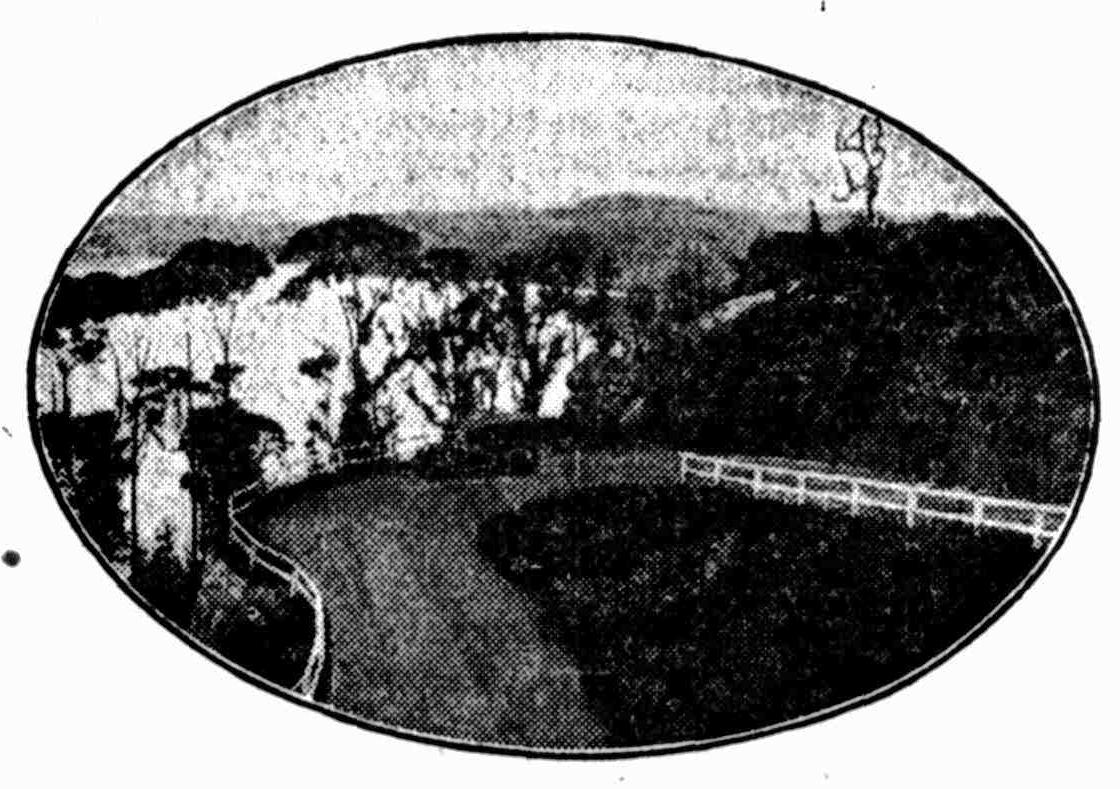
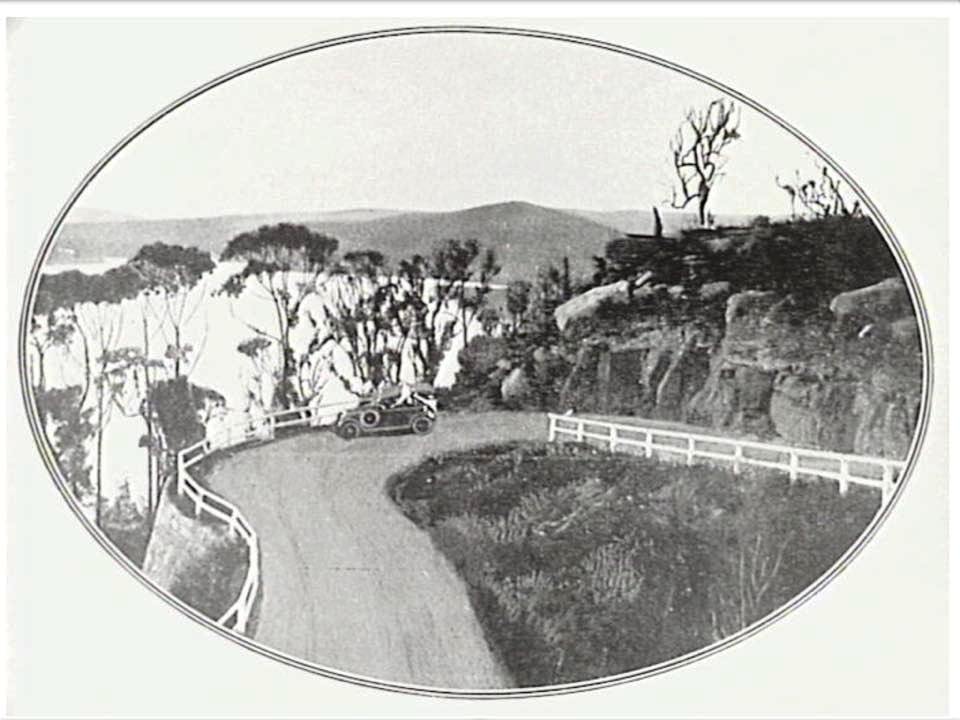
MAKING BIG PROFITS FROM ELANORA HEIGHTS SALES
Following the announcement of the plans of Land Properties and Investments, Limited, who own the Elanora Heights Estate of 518 acres above Narrabeen, the greater part of 1000 acres to the rear of this estate have been bought up by other interests preparatory to subdivision.
Seventy-seven acres of land to the rear of the Elanora Heights Estate changed hands this year at more than double what had been paid for it two months earlier.
REASONS WHY. The basis for all' this activity is the fact that population is rapidly flowing into the district — the effect which completion of the Sydney Harbor Bridge, and the concreting of the road from the Spit to Narrabeen will have — and further benefits anticipated from Dr. Bradfield's proposed new bridge, road, and railway line over Middle Harbor to Manly and Narrabeen, plus other improvements to communications in the district. Attention is being turned to Warringah Shire as 'Sydney's Second City,' for 'Sydney's Second Million,' and to Elanora Heights as 'The Bellevue Hill of Warringah.'
It certainly looks as though big profits are about to be made Land Properties and Investments, Limited, 350 George-street, are inviting the public to participate in them by subscribing to their share issue. The company is able to point to an absence of the risks associated, for instance, with industrial enterprises. The security — the land — is there for all time. No money will be tied up in plant and stocks. Labor costs and overhead expenses are negligible.
A commencement is to made on Boxing Day with the realisation of profits. Forty-four blocks in tho estate are to be offered for sale), and other sales will follow. In the meantime, some shareware still available. Purchasers of land sold by the company on terms will pay the usual interest. Shareholders will therefore benefit by this source of income, while it will be possible to use the same land as collateral security in other operations which the company will undertake from time to time on the shareholders' behalf. Security and profit go together in this move, and those interested may obtain all details from Mr. E. L. Walter, F.R.G.S., 350 George-street. MAKING BIG PROFITS FROM ELANORA HEIGHTS SALES. (1927, December 4). Sunday Times (Sydney, NSW : 1895 - 1930), p. 20. Retrieved from http://nla.gov.au/nla.news-article128524158
And at least one problem along the way:
Elanora Land Dispute
The suit is part heard of Hubert Clarence Paterson against Emma Franklin, in which plaintiff asks for a declaration that he be not bound by an agreement for the purchase of 20 allotments of Elanora Estate, Narrabeen Heights; that the contract be destroyed and his deposit of £500 returned to him.
Plaintiff alleged that he entered into negotiations with defendant's agent to buy said allotments at £110 each, with a deposit of £25 per allotment and balance payable in 5 years at 6 per cent he signed a form which had been filled in by the agent, leaving out the sum agreed upon, for the price of the .allotments, and he paid £500 deposit on April 5 last. Subsequently he received what purported to be a copy of the contract, in which the amount agreed upon was stated to be £4445. Plaintiff therefore repudiated the contract and demanded the return of his deposit. Defendent refused and by way of counter claim asked that the plaintiff be ordered to carry out his contract, which he had repudiated without justification, the price agreed upon being £4445. Elanora Land Dispute. (1927, December 14). Construction and Local Government Journal (Sydney, NSW : 1913 - 1930), p. 7. Retrieved from http://nla.gov.au/nla.news-article108990512
The first nine holes were opened on 29th May 1929 and the second nine in 1930. Further articles showing that the term 'beautiful' caught on with promoters of sales to the point where a comparison with 'Beautiful View' - or 'Bellevue' became the norm:
ELANORA Heights, Narrabeen - The Bellevue Hill of the North
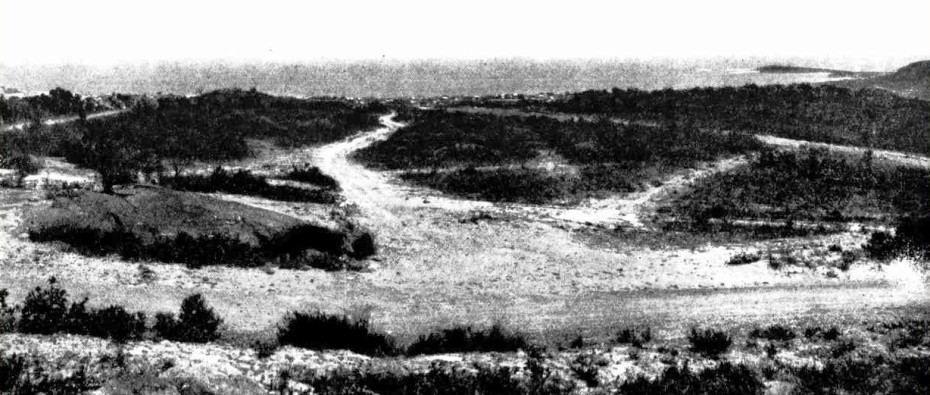
General View from Elanora-road, Overlooking Portion of Elanora to be Offered for Sale.
To the right is Long Reef and to the left Narrabeen Head. Township of Narrabeen is in centre foreshore.
The beautiful Elanora Heights, with an elevation varying between that of Killara and Pymble, and within two miles by good road to Narrabeen Beach, is to be laid out as a Model Suburb, upon the modern system of town .planning. It is aptly called the 'Bellevue Hill of the North,' but its residences will command finer views and outlook hardly excelled anywhere in the world. Special attention of prospective purchasers is drawn to the unique protection to be offered to home-seekers by the building covenant, protecting the class of building, area of blocks, and shopping centres, whilst the recreation areas are being taken over by the Warringah Shire Council, who have in mind their beautification and the building of cricket, tennis, and other sporting grounds. The new golf links of the Elanora Country Club adjoins the Estate, and experts predict that it will become the championship course of New South Wales.
THE town-planning of Elanora is being done with meticulous care. Domestic, services include electric lighting and power, whilst the Beacon Hill water scheme will make City water available on the Estate. The proposed railway service along the ocean front is now being surveyed. If will cross the City Bridge and bring the Estate within 15 miles of the General Post Office. It is interesting to note that motor transport and concrete and bitumen roads have brought this Bellevue Hill of the North closer to Sydney by time than Bellevue Hill and Edgecliff were little more than thirty years ago, when the only means of transport was horse-drawn vehicles, occupying 35 minutes from Edgecliff Post Office and substantially longer from Bellevue Hill to the city— and distance can only lie measured by lime.
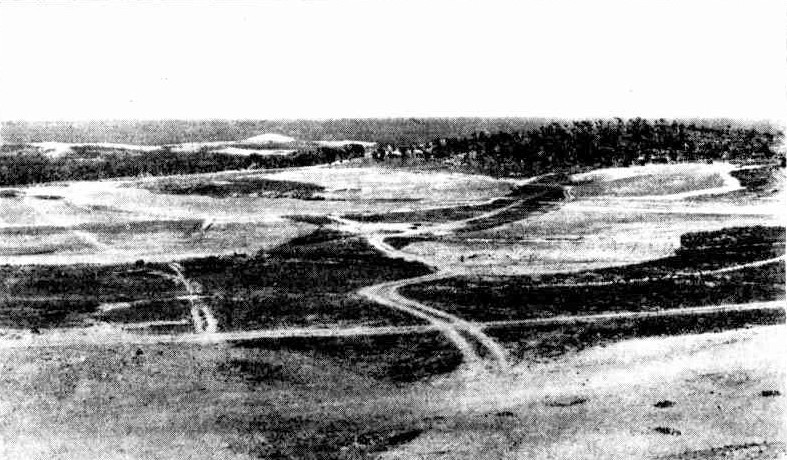
GENERAL VIEW OF THE NORTHERN NINE HOLES— NUMBERS 10 TO 18—Taken from the 18th Tee, Elanora Country Club Golf Course.
THE plateau, which is mostly sandy loam, has immense possibilities for modern bungalows and gardens in an ideal setting, and now these heights are opened up by well –constructed roads they make a delightful spot to view the panoramas of lakes and the irregular coast line from South Head to Broken Bay. The road access is good the whole way from North Sydney. Good motor bus and tram services are already established to Narrabeen, which is only one mile by an excellent road from the Estate, and less than two miles from the Golf Links.
The first subdivision of choice residential sites is to take place on the ground, Saturday 9th March, at 3p.m. Messrs Richardson and Wrench, Ltd., Sydney, and Robey, Hanson, and Strong. Ltd.. Manly, are the auctioneers in conjunction, from whom lithographs and further information may be obtained.
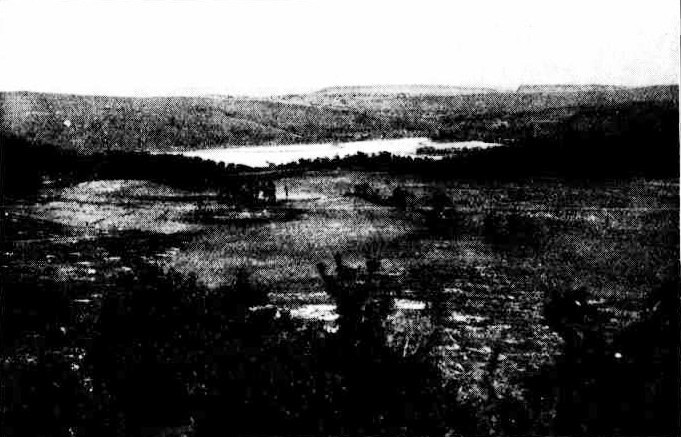
ELANORA COUNTRY CLUB GOLF LINKS.
General view of first nine holes in course of construction, showing land cleared and ploughed.
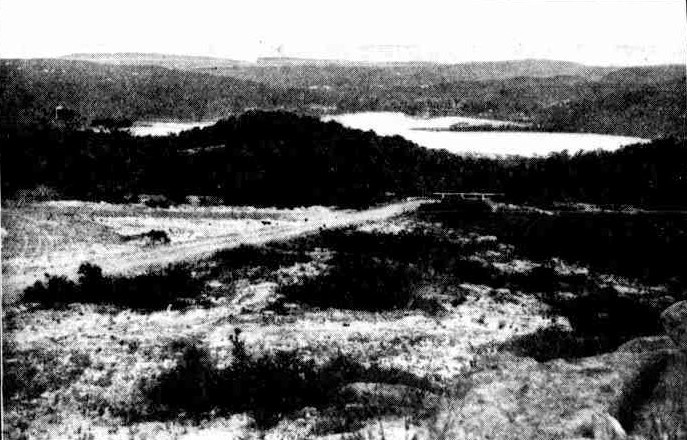
VIEW FROM THE ESTATE. SHOWING ELANORA-ROAD AND TURN-OF- TO THE FAIRWAY,
Overlooking Narrabeen Lakes and Sydney. South Head is in the centre-distance.
ELANORA Heights, Narrabeen. (1929, February 6). Sydney Mail (NSW : 1912 - 1938), p. 21. Retrieved from http://nla.gov.au/nla.news-article166259531
NARRABEEN
ELANORA HEIGHTS
THE BELLEVUE HILL OF THE NORTH
ADJOINING THE NEW GOLF LINKS of the ELANORA COUNTRY CLUB, which men competent to judge predict will become the CHAMPIONSHIP COURSE OF NEW SOUTH WALES.
FIRST SUBDIVISION of CHOICE RESIDENTIAL SITES, commanding magnificent and extensive views of the whole of the coastline from SOUTH HEAD to BARRENJOEY (BROKEN BAY).
The Land is situated a little over a mile from the NARRABEEN TRAM TERMINUS, and is approached by first-class, up-to-date roads, which bring the Estate within Fifty Minutes' Motor Run from the G.P.O.
The New Elanora Road, which runs through the Estate, is now open for traffic.
A SPECIAL LINE OF FREE MOTOR 'BUSES WILL BE AVAILABLE from the NARRABEEN TRAM TERMINUS, to the Estate on Saturdays and Sundays, tickets for which are obtainable from Auctioneers.
LIBERAL-SIZED ALLOTMENTS. EASY TERMS.
ASSISTANCE TO BUILD. TORRENS TITLE.
AUCTION SALE ON THE GROUND
SATURDAY, 9th MARCH, AT 3 P.M.
LITHOGRAPHS NOW AVAILABLE.
RICHARDSON AND WRENCH, LIMITED,
92 PITT STREET, SYDNEY.
ROBEY, HANSON, AND STRONG, LIMITED
The Corso, MANLY.
Auctioneers in conjunction.
(No. 88) Advertising (1929, March 2). The Daily Telegraph (Sydney, NSW : 1883 - 1930), p. 22. Retrieved June 26, 2019, from http://nla.gov.au/nla.news-article245634341
But wait, there's more!:
Elanora Heights, Narrabeen - The Bellevue Hill of the North
This unique sub-division overlooks the township of Narrabeen, the Lakes, and Lagoons, and from its elevated site commands an unsurpassed panoramic view of the Pacific and the glorious stretch of coastline from South Head to Broken Bay, which is - fast becoming the seaside playground of the City of Sydney. The first sub-division of Elanora Heights is being offered at auction sale, on the ground, on SATURDAY, 9th MARCH, by RICHARDSON AND WRENCH, LTD., Put-Street, Sydney, in conjunction with ROBEY, HANSON, & STRONG,LTD., The Corso, Manly.
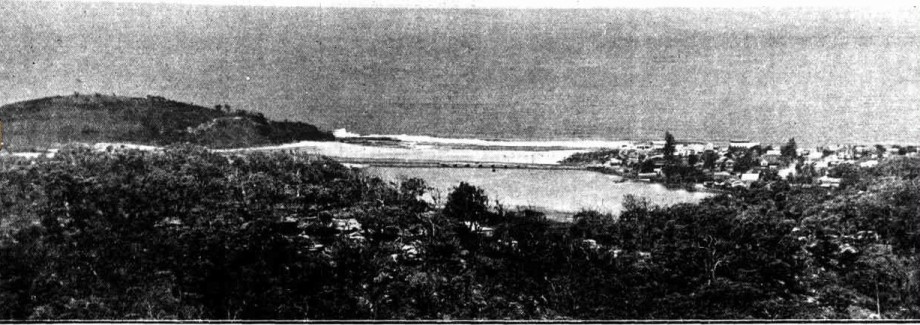
VIEW OF THE TOWNSHIP OF NARRABEEN AND LAGOON, AS SEEN FROM A PORTION OF THE ESTATE TO BE OFFERED FOR SALE.
ELANORA HEIGHTS subdivision is situated within a 12-mile radius of the G.P.O., with elevations corresponding with those of Killara and Pymble on the North Shore Line. It lies within two miles by good road of Narrabeen Beach, and possesses an easterly aspect, being protected from the bleak westerly winds of winter and the zeal of the afternoon sun in summer. It is confidently believed that in offering this properly for sale .an opportunity is presented similar lo Hint which was offered when, in I lie previous genera I ion. Darling Point. Edgecliff and Bellevue Hill were made available for residential purposes. Everyone knows how the subsequent development of these suburbs has converted them today into the exclusive residential areas of Sydney. Values have now reached a point when they are too high for most people to pay for residential purposes, and it is necessary to seek land with open spaces, which will provide healthy home sites for the people. The sites of the allotments have been designed to give each residence ample breathing space, and building covenants will protect home-builders from the erection of any undesirable buildings on the estate.
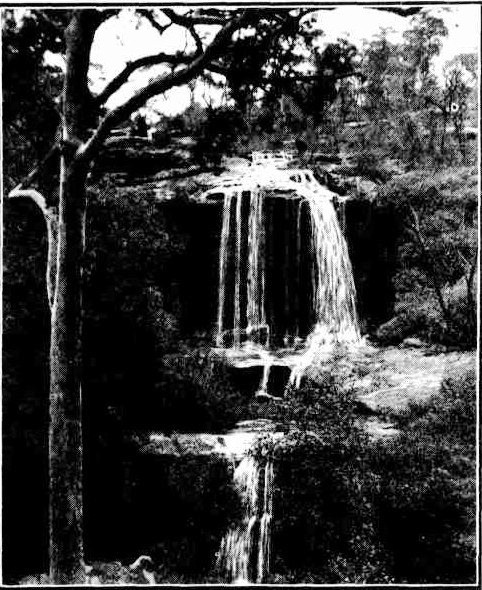
ELANORA CHINE.
One of the beauty spots on the Estate, which will form part of the Recreation Reserve to be set aside for the enjoyment of purchasers.
IN the Elanora Heights subdivision the foundations are therefore laid for the building up of a new garden suburb handy to the city, and endowed with all the natural beauties of which Sydney can boast. Further enhancing its attractions for those seeking to possess healthy home. sites is the establishment of the golf course by the Elanora Country Club, nine holes of which will be ready for play during April. The Water and Sewerage Board has under construction the Beacon Hill Reservoir scheme, which will be available for the use of residents of the Warringah district no! later than September next. This will ensure a permanent, and ample supply of water within the Warringah Shire boundaries. The electric light main is now being extended from Pittwater-road almost to the boundary of the estate, and the extension from that point will be taken in hand immediately it is required. The vendors are able lo render material assistance to build, particulars being available on application to the agents, who will gladly supply lithographs of the estate and any other information.
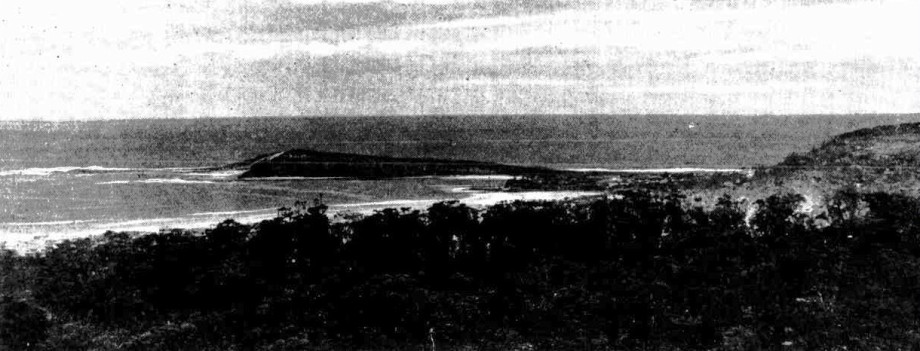
A STRIKING VIEW OF LONG REEF, TAKEN FROM THE JUNCTION OF THE APPIAN WAY, THE GREENWAY, AND THE FAIRWAY. (SEE LITHOGRAPHS.)
Elanora Heights, Narrabeen. (1929, February 20). Sydney Mail(NSW : 1912 - 1938), p. 44. Retrieved from http://nla.gov.au/nla.news-article166260523
A chine is a steep-sided river valley where the river flows to the sea through, typically, soft eroding coastal cliffs of sandstone or clays. The word chine originates from the Saxon "Cinan" meaning a gap or yawn.
The sales were successful and yet more were offered with perhaps a hint as to why Old Saxon words became part of sales literature as well as the continuance of that train story, only now, instead of or as well as, running beside the ocean, all the way, she's a'coming over the hills from Gordon to Narrabeen:
Elanora Heights - LOVELY VIEWS
Within the Elanora Heights area, £15,000 worth of land has been sold, and with the prospect' of the Gordon to Narrabeen railway being soon constructed, the demand is keen. The scenery of this fine region has already been enlarged upon in these columns. It need only be added that much of the charming bushland for which this district is famous still remains, and the surroundings are as attractive as any of those about the shores of Port Jackson. There are hills and valleys and rippling streams in this part of the coastal area, and the commanding position of the land in this estate facilitates home-making under the most delectable conditions.
Elanora Estate is situated within the 12 miles radius of the General Post Office. It is within two miles of the fine Narrabeen Beach, and commands a magnificent view of the whole of the coastline from the South Head Lighthouse to Barrenjoey, taking in the Narrabeen Lakes and estuary — one of the most charming of the beauty spots of a district that is rich in beauty. The estate occupies the eastern side of a high promontory, which juts out from the main line of the hills below Gordon-Pittwater-road, overlooking the sea.
The western half of the promontory will be occupied by the Elanora Country Club golf links and properties. The Elanora Heights Estate leans to the eastward and seaward side of the Country Club's properties, and comprises a substantial area of magnificent subdivisional land, which, from its highest point, 550 feet above sea level, slopes down towards the coast. When the harbor bridge has been completed, this estate will be brought within half-an-hour's journey of Sydney by motor car.
It has an eastern aspect, with northern and southern outlooks, and is well sheltered from the bleak westerlies of the Winter. The situation is healthful to the last degree, and commands some of the finest views to be met with in the coastal areas of N.S.W. The estate has been laid out in such a way that it should become a model suburb. It has been designed by Dobbie and Foxall, the well-known Sydney surveyors, and the greatest care has been taken to provide for convenience of access, shopping and building services, and the general comfort of home-makers. The building covenant provides for the subdivision of the residential blocks into substantial areas, with limitations as tore-subdivision — conditions designed to prevent the erection of an undesirable class of house. A limitation of shopping areas is also a provision that will serve the interests of home-makers within this area. This Dee Why-Collaroy-Narrabeen region is in constantly-increasing demand for land for home-making. Since the beauty and the convenience of the place, with its glorious beaches, fine roads, and delightful surroundings, have been discovered, week-end shacks have been steadily giving way to permanent homes, many of them on an elaborate scale, and hundreds of new buildings are erected every year.
Elanora Heights are in the centre of what is destined to be one of the finest and most popular suburbs of the metropolis, and, with the advent of the railway from Gordon to Narrabeen, values are bound to soar. All particulars may be obtained by intending purchasers from the South British Land and Investment Co., Kembla Buildings, Margaret-street, Sydney. Elanora Heights. (1929, March 24). Sunday Times (Sydney, NSW : 1895 - 1930), p. 10. Retrieved from http://nla.gov.au/nla.news-article131633716
The Elanora Country Club was opened in late May 1929 in the old rehabilitation home as part attraction to buy in this estate and probably due to the Board members all being keen golfers themselves. Although the adjacent land was sold under the name of 'Green Hills' this escarpment has always been and remains a bushfire zone.
Water was pumped from Powder Works Creek on the Club’s property to storage tanks and reticulated there to begin with. The construction of dams like the extension of Powder Works Dam (1946), 2nd green dam (1958), and 7th fairway dam (1971) all provided water along with the Clubhouse being connected to the Water Board in 1958. Since then a larger dam has been constructed to make certain the greens stay green, even during extended dry periods.
FOUR "BENNETT" CONCRETE TANKS of 10,000 gallons capacity each, built at the Elanora Country Club, Narrabeen, Sydney. 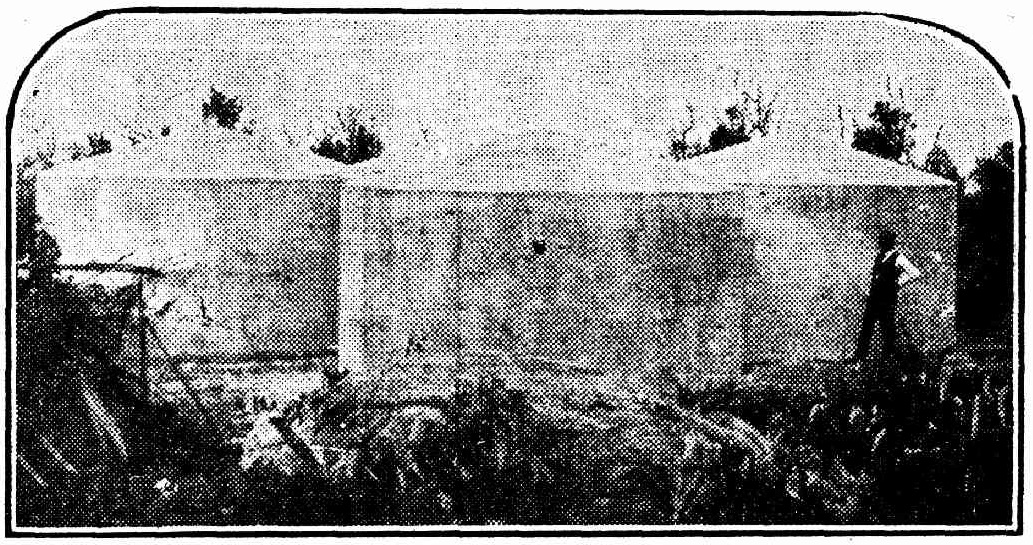
No title (1929, February 12). The Daily Telegraph (Sydney, NSW : 1883 - 1930), p. 17. Retrieved from http://nla.gov.au/nla.news-article245519016
ELANORA COUNTRY CLUB.
The official opening of the first nine holes of the Elanora Country Club golf links, at Elanora Heights, Narrabeen, and of the club's temporary club-house, will take place on Wednesday, May 29, at 2 p.m. The ceremony will be performed by the president (Colonel Playfair).
To mark the occasion a nine-hole stroke competition, open to members and visitors, will be played for the Elanora Cup. The cup has been donated by Mr. W. A. Freeman, and will be played for annually, on the anniversary of the opening of the club. The cup yyill remain the property of the club, a replica being given to the winner. The well-known Killara player I. K. Harrison has been appointed the first captain of the club. ELANORA COUNTRY CLUB. (1929, May 22). The Sydney Morning Herald (NSW : 1842 - 1954), p. 20. Retrieved from http://nla.gov.au/nla.news-article16558704
ELANORA COUNTRY CLUB.
The official opening of the Elanora Country Club will be held to-morrow. In view of the number of golfers who intend playing the committee has sanctioned a start being made at 12 o'clock Instead of 2 p.m.. as previously announced. The well-known Killara and Interstate player I. K. Harrison is the captain of the new club. ELANORA COUNTRY CLUB. (1929, May 28). The Sydney Morning Herald (NSW : 1842 - 1954), p. 15. Retrieved from http://nla.gov.au/nla.news-article28047742
As the green fields and bushland gave way to development, green remained the optimum colour for Reserves set aside the the placement of greens for playing golf on - all with breathtaking views. This picture looks like it has captured school girls in uniform, or...?:
PICTURESQUE GOLF LINKS.
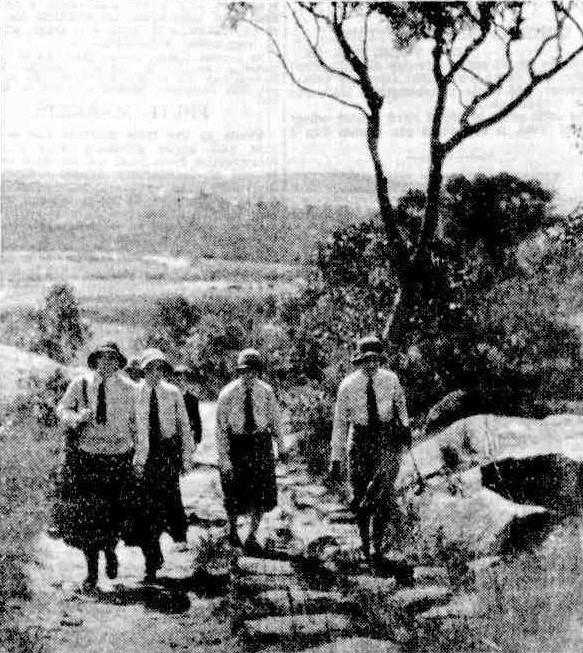
Women players climbing the hill to the fourth tee at the Elanora golf links. PICTURESQUE GOLF LINKS. (1932, September 15). The Sydney Morning Herald (NSW : 1842 - 1954), p. 12. Retrieved from http://nla.gov.au/nla.news-article16891967
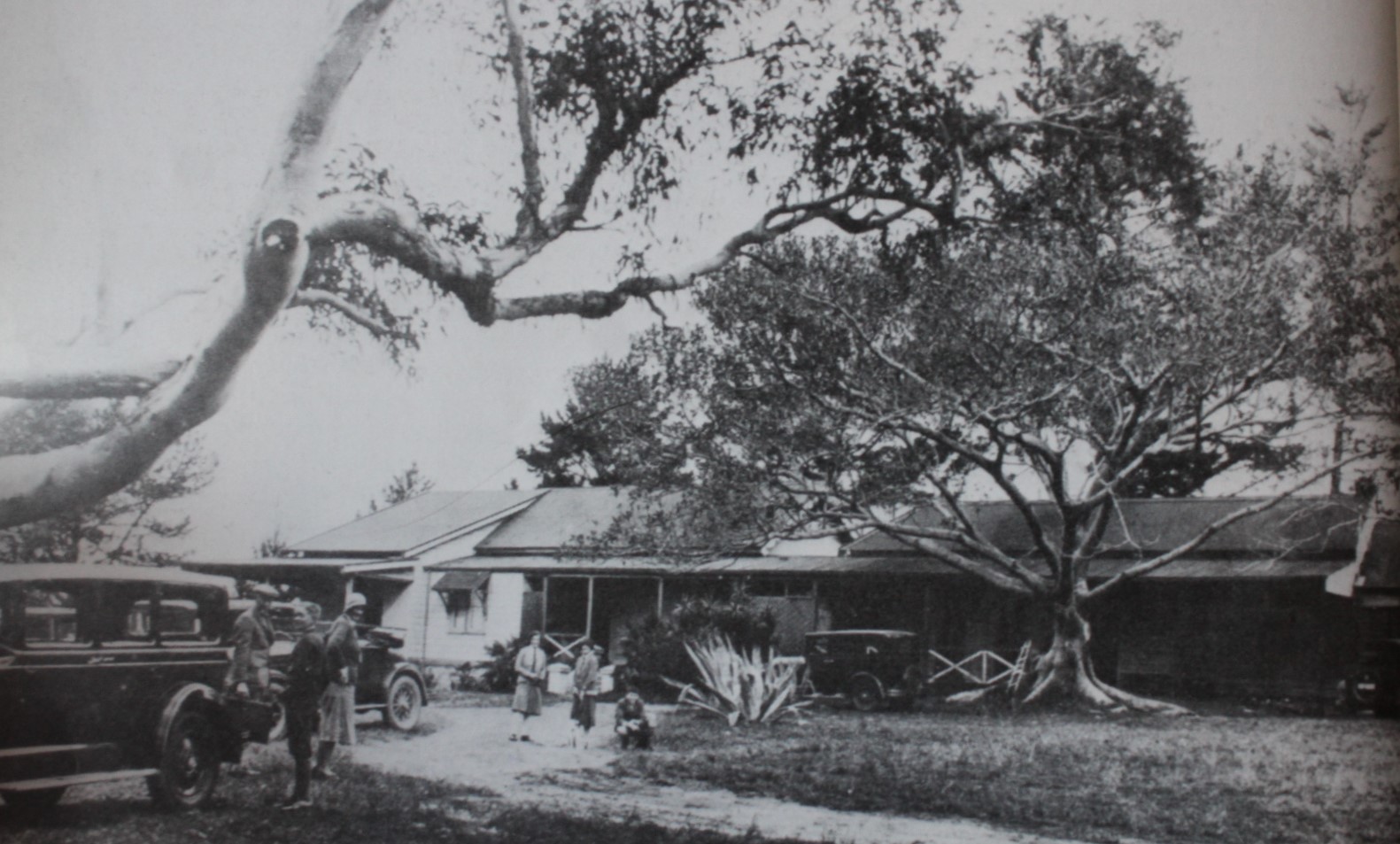
CLUBHOUSE BURNT. £6500 LOSS. ELANORA BLAZE.
The wooden clubhouse of the Elanora Country Club, Narrabeen, was destroyed by fire yesterday, and only the club records were saved. Trophies valued at about £500 were lost.
The total damage is estimated at £6500,and about 80 club members lost sets of golf sticks. It was thought that the fire originated in the boiler-room, which is used for the water heating system. It started at about 3.25p.m., and in five minutes the old wooden building was a mass of flames. Half an hour later the main building collapsed. Flames rose to a great height, and pine and Moreton Bay fig trees standing around it were set alight.
"I was sitting in the office doing some work," said Miss Joyce H. Bucknell, assistant secretary of the club, "when Mr. Collings, a steward, ran into the office and told me that the clubhouse was on fire. I immediately telephoned the police and fire brigade.
"I endeavoured to save everything in the office, I took out all the books and put them in the garden, and I took the money from the safe."
Miss Joan Oswald-Sealy, secretary of the club, said she arrived a few minutes after the fire began. About 14 members, who were playing on the course, abandoned their game and ran to the clubhouse, but they were unable to save anything. Motor cars standing near the clubhouse were blistered by the heat and some of the car windows were cracked.
The trophies which were lost included the Burdekin cup, Keith Harrison Memorial cups, Pioneer cup, Wylie cup, Searcy cup, the new Coronation cup, and the president's, captain’s, and hole-in-one cups. The building was valued at about £1000, and the fittings were worth about £5000.
When the fire brigades from the Deewhy and Narrabeen stations arrived, under District Officer W. G, White, of Crow's Nest, efforts had to be concentrated on cutting off the fire from the quarters occupied by the secretary and the assistant secretary.
WING SAVED.
The firemen brought the engines up to tanks alongside the blazing clubhouse, smashed in the tops of the tanks, and successfully saved this wing. In addition to the secretary and the assistant secretary, there were eight others on the clubhouse staff. Many of them, who were quartered in the main building, lost all their possessions.
The club has about 600 members—400 men and 200 women. About 90 per cent, of the members are also members of the Royal Sydney and the Australian clubs.
Although all the fittings of the clubhouse belonged to the club, the building, which was about 25 years old, and which formerly was a hospital, was owned by Mrs. G. E. Wilson, of Bayview House, Tempe.
During the fire concern was felt for three dogs and a kangaroo, which are pets of the secretary, but they suffered no harm.
Last night Miss Oswald-Sealy and Miss Bucknell were unable to occupy their quarters because of the damage done by water and debris. They found temporary accommodation in a small house near the clubhouse.
NEW BUILDING.
Colonel T. A. J. Playfair, M.L.C., president of the Elanora Country Club, said last night that an emergency meeting of the committee had been called for today, with a view to speeding up the building of a new clubhouse. Work would begin almost immediately.
He stated that the club had arranged an important associates' competition for today. This would be conducted, but it would be necessary for the associates to arrange for their own meals. (Pictures on page 18.) CLUBHOUSE BURNT. (1937, May 19). The Sydney Morning Herald (NSW : 1842 - 1954), p. 15. Retrieved from http://nla.gov.au/nla.news-article17369203
The Pictures from page 18 this same SMH Edition:
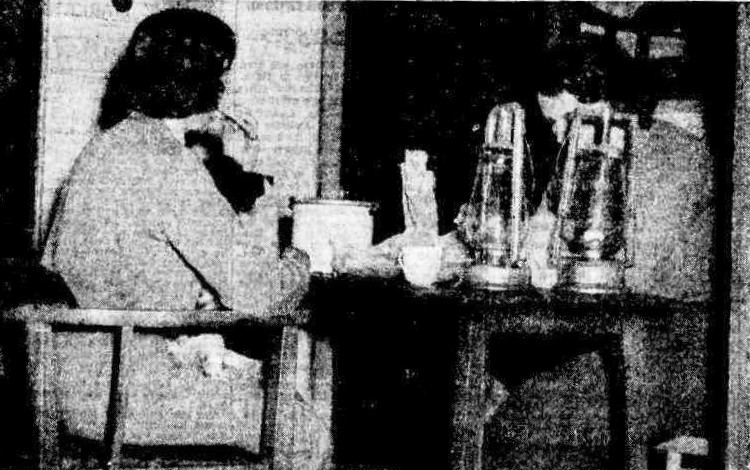
Important records and a considerable sum of money were saved by the assistant-secretary, Miss Joyce Bucknell (right)when a fire broke out at the Elanora Country Club yesterday afternoon. She and the secretary, Miss Oswald-Sealy, are shown sharing an impromptu meal after the fire.
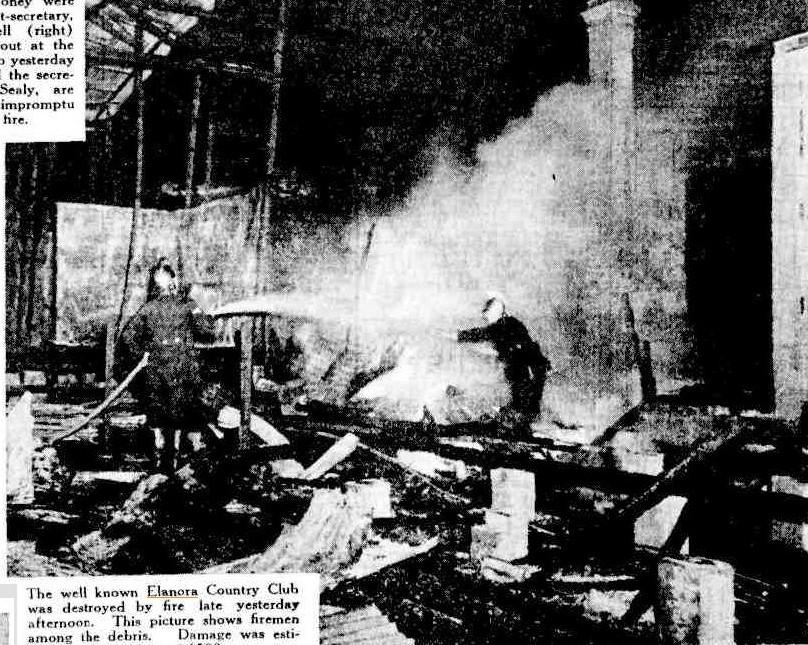
The well known Elanora Country Club was destroyed by fire late yesterday afternoon. This picture shows firemen among the debris. Damage was estimated at £6500. LONDON NEWS-PICTURES BY AIR MAIL—FIRE DESTROYS ELANORA COUNTRY CLUB —BROADBENT BREAKS RECORD. (1937, May 19). The Sydney Morning Herald (NSW : 1842 - 1954), p. 18. Retrieved from http://nla.gov.au/nla.news-article17369256
On Mr. Harrison, previously a member at Dobroyd and an excellent golfer on occasion who set a few club records in a few places:
AMATEURS partnered by professionals will pay tribute to the late Keith Harrison at Elanora Country Club on September 6. The occasion will be an open four ball v par competition for the Keith Harrison Memorial Cup. Keith was a former captain of the Killara and Elanora Clubs, a leading amateur and a great friend of the professionals. TALKING OF golf. (1947, August 18). The Sydney Morning Herald(NSW : 1842 - 1954), p. 10. Retrieved from http://nla.gov.au/nla.news-article18045963
The lady who owned the premises and land, and is named as a 'Matron' in other articles we found:
INTERESTS-IN MENTAL HOSPITAL; GIFT TO SUPERINTENDENT.
By originating summons the Court was asked to determine certain questions of construction which had arisen in administration of the estate of Mrs. Grace Edith Wilson, who, for many years, conducted Bay View House, a mental hospital at Tempe.
The material questions for the Court were in respect of the interests taken by Dr. W. R. Page, the medical superintendent of Bay View, under Mrs. Wilson's will. Determination of these interests became necessary so that those of the residuary legatees might be clarified.
Mrs. Wilson died in September 1939, leaving a considerable estate, including the hospital property and other assets at Tempe valued at £40,000, and land at Narrabeen valued at £6,000. The Narrabeen land is now occupied by the Elanora Golf Club, but had formerly been used in connection with a convalescent home for hospital patients.
After hearing considerable argument, his Honor held that in addition to the quarter share of the hospital property devised to him, Dr. Page took a quarter share in the assets of the business, less a quarter share of the mortgage on Bay View, and less a similar share of trade debts, the total liabilities under these two headings amounting to about £8,000. He was also entitled to one fourth of the profits of the hospital business from the time of the death of the testatrix to the dale of sale. His Honor also held that the mortgage on the Narrabeen lands had to be borne by the persons entitled to interests in the land under the will. EQUITY. (1946, May 4). The Sydney Morning Herald (NSW : 1842 - 1954), p. 5. Retrieved from http://nla.gov.au/nla.news-article17990545
The new clubhouse was opened by May 1938, just prior to the anniversary of the fire. One item of note in association with this clubhouse is that it was decorated by Palm Beach frequent visitor Marion Hall-Best (nee Burkitt). Most of the images in this article are too dark to see what they show
NEW COUNTRY CLUB AT ELANORA. COMFORT FOR GOLFERS. Furniture Designed by Woman.
SYDNEY'S. most luxurious country club, on the heights of Narrabeen, the Elanora Country Club, has been re-built following a fire, and on Saturday the long cream brick building, from which one may see South Head down the coastline on the right, to Barrenjoey on the left, will be officially opened.
A modern and almost nautical scheme of decoration has been followed In the club, where vivid furnishing schemes give contrast to the pastel shaded stone walls and the plain cream ceilings. All the furniture is of unstained wood, and the lighting is Indirect.
Furniture Designed by Woman.
MRS. J. V. HALL-BEST, who has been responsible for the furnishings, has relied on simplicity and colour for her effects, and she has designed the tables and chairs so that they harmonise with the fabrics.
Above: A CORNER of the verandah showing the extent of the view. The chairs seen are covered in turquoise blue linen patterned in white, and the tables have tops of coral pink rubber.
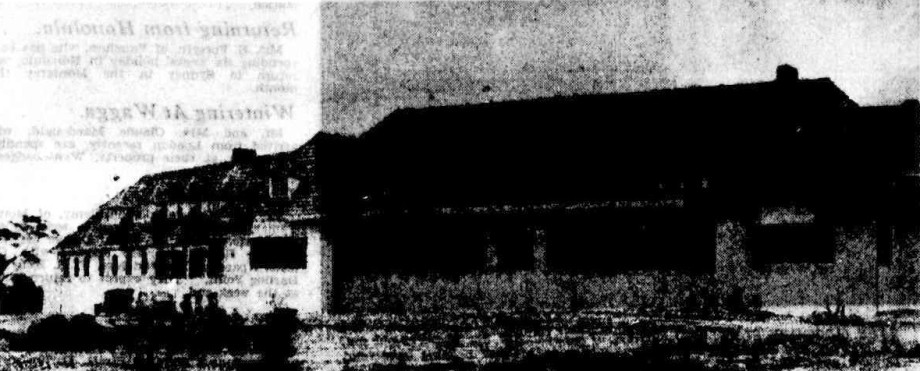
Left: THE front facade of the Elanora Country Club, which will be officially opened on Saturday. Note the generous windows from which a superb view of the coastline may be obtained.
Below: MRS. JACK CASSIDY, captain of the associates of the Elanora Country Club, photographed outside the entrance of the Club.
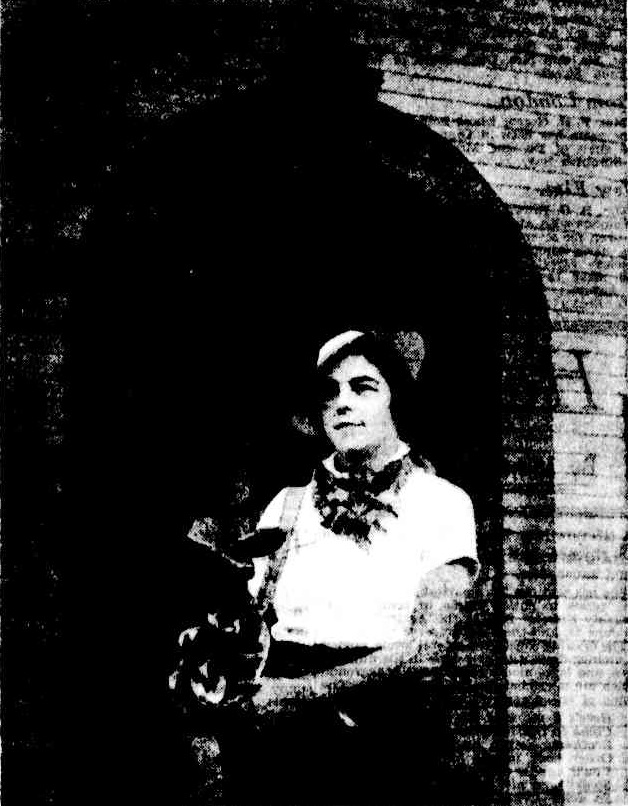
...joins OSWALD-SEALY, the assistant secretary of the Elanora Country Club, photographed in the main lounge room.
In the dining-room, which will seats 400 members, the chairs and tables are of unstained ash and scarlet leather and French blue linen are used for the Chair coverings. On the wide glassed-in verandah which overlooks the ocean, a marine effect has been achieved by the rough coral linen fabric which is used for some of the cane chairs. On those a large design of a fish blowing bubbles featured, and in contrast are the covering of Turquoise blue patterned in a design of white waves. The tops of the tables are covered In coral rubber, and have little rubber feet to prevent noise and scratching.
Table tops of Pink Rubber
WOMEN have equal rights with men in this club, and not only have they their own locker rooms, but their own verandah, patio, cocktail bar, and lounge. The lounge, one of the most attractive rooms in the club, has comfortable blue sofas and untist'ial chairs of natural beechwood, marie with wooden backs, and padded seats covered by roughly woven coral pink linen, patterned in white. Coral pink Venetian blinds and fables topped in pink rubber complete the scheme.
In the women's locker-room, a scarlet ...
THE main lounge-room, for all members, contains the illuminated trophy cupboard, which Colonel T. A. Playfair will officially open on Saturday. As there is no foundation stone to be laid, this will serve as the opening ceremony of the club. Chairs in this room are coloured in brown linen patterned In white. The huge brick fireplace, panelled in dark brown wood, matches the fireplace at the end of the dining-room, which is separated from the main lounge by wide glass doors. When all the doors are open a huge dancing space is available. The men also have their own lounge-room, furnished in green, and their cocktail bar. Upstairs there is accommodation for 20 members, and the soundproof ceilings will be a great advantage. Highlights of the large and airy kitchen are the two built-in refrigerators, the electric washing-up machine, and the giant-sized griller. NEW COUNTRY CLUB AT ELANORA. (1938, May 5).The Sydney Morning Herald (NSW : 1842 - 1954), p. 22. Retrieved from http://nla.gov.au/nla.news-article27979930
As it turns out, the members of the Elanora Country Club celebrated the opening of the new clubhouse by playing golf prior to a cocktail or two - :
CLUBHOUSE OPENED. Cocktail Party at Elanora
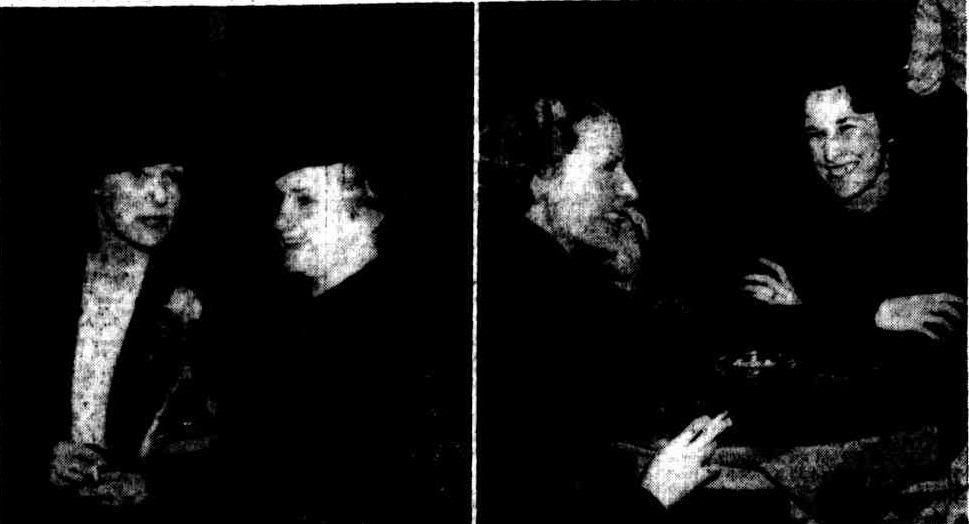
Photo: PARTY IN SPACIOUS RECEPTION ROOMS OF NEW CLUB. Left: MRS. T. A. J. PLAYFAIR, wife of the president, and MRS. T. G. MURRAY, MRS. GEOFFREY GREGORY, and MRS ALAN COPELAND, who were guests at the opening of the Elanora Country Club on Saturday afternoon
The spacious verandahs and reception rooms of the new Elanora Country Club, overlooking the Narrabeen Lakes and a wide expanse of coastline, were crowded with members and their friends on Saturday afternoon, when a cocktail party was held to mark the official opening of the club-house. The party followed the playing of the mixed foursomes competition, and many of the guests took part In the play and came straight In to enjoy cocktails The majority wore tweeds in the gay and large checks which are so popular this season, or tailored spoiling frocks, with knitted cardigans...
Over the open fireplace were arranged big bowls of tawny tinted zinnias and gladioli varying from white to scarlet colourings Similar flowers were used to decorate the long buffet table in the banquet hall, where miniature hot pies were served....
Colonel T. A. J. Playfair, the president of the club, and Mrs. Playfair had a busy time receiving the large number of guests Mrs. Playfair's Highland tweed suit in brown tailings featured lapels bound with leather, and she added a sporty blown felt hat...
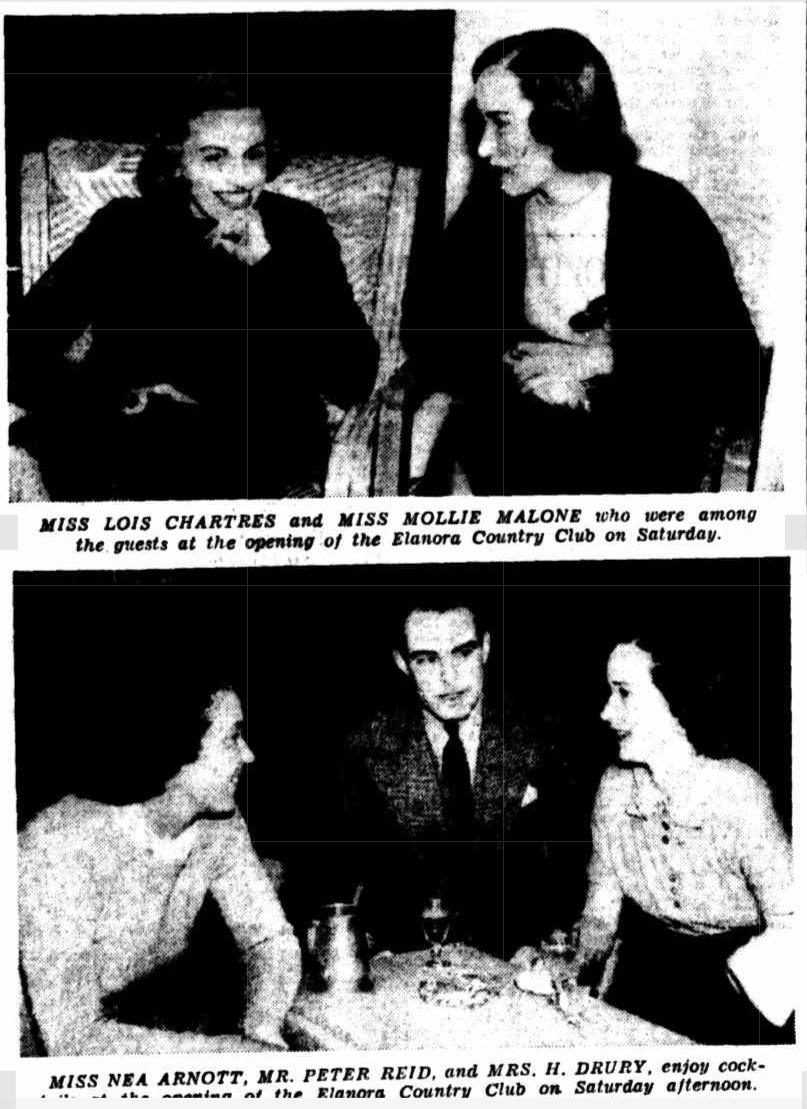
.FOR WOMEN PARTY IN SPACIOUS RECEPTION ROOMS OF NEW CLUB. (1938, May 9). The Sydney Morning Herald (NSW : 1842 - 1954), p. 5. Retrieved from http://nla.gov.au/nla.news-article17463598
The Elanora Country Club, on Elaora road, became and remains a home away from home' for many and has among its membership state and Australian golf champions.
THE Quarter Deck — the Neil Buchanans week-ender at Avalon—is half-way house on New Year's Eve. Everyone drops in for cocktails on their way to Elanora, Palm Beach, and other parties. Guests of honor are Betty Munro and Tim Osborne. Sheila and John Goodall, Betty and Tom Peters, June and Clive Ogilvy, Ralph and Barbara Huntley, Sheila and Geoff Plater, Ruth Wilson, Moya and Laurie Barnes, Betty Sidaway among guests. Jottings of the Week (1940, January 6). The Australian Women's Weekly (1933 - 1982), p. 31. Retrieved from http://nla.gov.au/nla.news-article46935439
This isn't the only green space set aside for those who like golf. Situated on the same 'green hills' and just above the Elanora Golf Club, is the home of the Monash Country Club, on Powderworks road.
The Club, named after Lieutenant General Sir John Monash, one of Australia's greatest soldiers, started out as a Jewish Social Golf Club in 1931. The original members played their events on a number of different golf courses, such as, Ashlar at Blacktown, Bonnie Doon, Kogarah, Moore Park, Eastlakes, New Brighton and St Michael's. At St Michael's a small temporary clubhouse was provided in 1938.
During WWII the Army took over St Michael’s golf course, and because so many of the Monash members were enlisting in the forces it was decided to close down for the duration.
After cessation of hostilities many of the Monash golfers decided they would like to join golf clubs in Sydney but found that they were denied entry solely on the grounds that they were Jewish. A meeting was called to discuss a remedy to this problem and it was decided to build a new golf course where there would be no discrimination on the basis of colour, creed, race or religion.
A company called Monash Holding Limited was formed to find, and buy, a property on which a championship golf course could be built. The money for this venture was raised from the Jewish community of Sydney by the issue of shares in Monash Holdings Limited. Many applicants for shares never thought of this as an investment and most were not golfers. But they saw it as a way to overcome discrimination against Jews or other minorities.
Land was finally found and purchased at Narrabeen Heights, above Elanora Country Club. The construction of the course took place between 1948 and 1952. The first nine holes were opened in 1950. The clubhouse was opened in 1952.
In December 1957 a bush fire completely gutted the Clubhouse, as had happened at Elanora in 1937 and the loss of houses at 'Green Hills' in 1944. The Club was also suffering from one of the worst droughts in history. New plans were drawn up, and a much bigger and more luxurious Clubhouse was built in 1959, and the Club was then raised to Group 1 status by the New South Wales Golf Association.
Since that time various improvements have been made to the Clubhouse, which culminated in the completion of major extensions in February 1992.
To ensure what members had experienced elsewhere and prompted the vouchsafing of access for all for all time, a long-term lease was drawn between the landowner, Monash Holdings Limited and Monash Country Club. The terms of this lease, which has been extended from time to time, set out the basis for the structure and formalised the relationship that the founders saw for the future of the Monash Golf Club. During the terms of the lease the rental for the property was to be a peppercorn rental, sufficient only to cover the administration costs of Monash Holdings Limited. The “quid pro quo” for this low rental was that the members of the General Committee should always contain a majority of Monash Holdings members, elected from the membership by ballot in the normal way. This was designed to ensure that golf will be played on this land for the duration of the lease and, that the qualification for members shall never be based on race, creed, colour or religion, but solely on an individuals self worth, character and good standing.
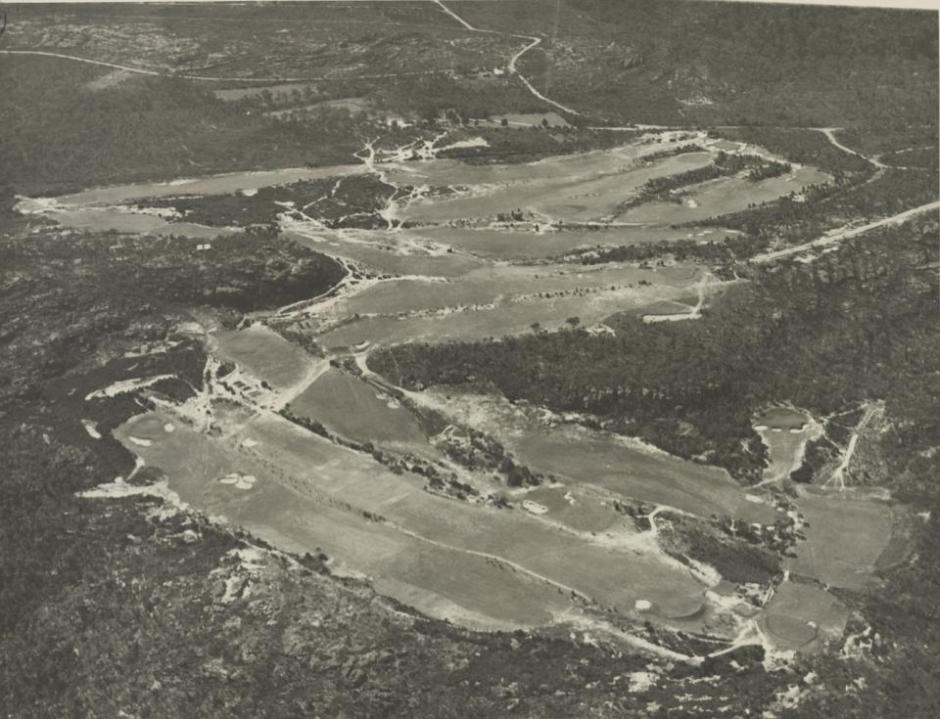
Above and Below: 54 aerial views of Sydney golf courses] / Hall & Co., ca. 193-? [Contents] Numbers 21-22. Ellanora [i.e. Elanora] Images No.: a2802022h and a2802021h courtesy State Library of NSW
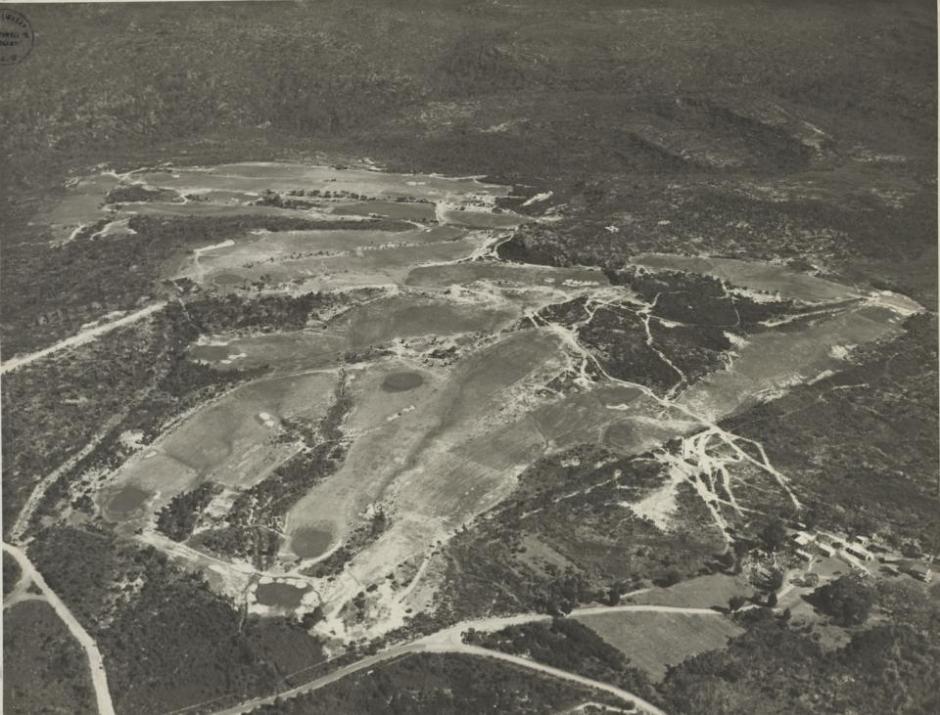
Narrabeen North - Two Bungalows
VACANT POSSESSION
(1) Lot 164 cnr POWDERWORKS and ELEANORA Rds
BRAND NEW CREAM MAHOGANY BUNGALOW near Eleanora Golf Course with pleasant PANORAMIC RURAL VIEWS ACCOM Sundeck Vestibule Large Lounge Dining rm opening by glass doors to sunroom 2 Bedrms tiled Bathroom (S Recess and Toilet) Large Kitchen (S Steel Sink and gas sink heater) Laundry Sentie Sewerage LAND 93ft frontage (Splay 50ft to Powderworks Rd) x 124ft TORRENS
(2) Lot 165 adj cnr Powderworks and Eleanora Rd BRAND NEW BLUE CYPRESS PINE BUNGALOW adjoining above cottage ACCOM Sundeck Hall Large Lounge Dining room opening by glass doors to side sunroom and open rear verandah 2 Bedrms (1 coloured pink and the other blue -with built In wardrobes) Tiled Bathroom (S Recess) Separate tiled Toilet Kitchen (S Steel Sink and gas sink heater) Laundry Septic Sewerage
LAND 81ft /10-ft X 124ft/12R ft TORRENS solicitors E H TEBBUTT & SONS Advertising (1953, May 9). The Sydney Morning Herald(NSW : 1842 - 1954), p. 24. Retrieved from http://nla.gov.au/nla.news-article18377074
List Of Streets In Elanora Heights
Allawah Avenue
Allington Crescent
Amaroo Avenue
Anana Road
Bolwarra Road
Bungoona Avenue
Caladenia Close
Canungra Place
Coolangatta Avenue
Cooleena Road
Dendrobium Crescent
Dewrang Avenue
Elanora Road
Epworth Place
Eungai Place
Foxall Street
Georgina Avenue
Gondola Road
Iluka Avenue
Inala Place
Indura Road
Irrawong Road
Kalang Road
Koorangi Avenue
Kundibah Road
Kuttabul Place
Kywong Road
Lesley Close
Lumeah Avenue
Maralinga Avenue
Marinna Road
Merridong Road
Mirbelia Parade
Mirrool Street
Morandoo Road
Nareen Parade
Powder Works Road
Rickard Road
St Andrews Gate
Tatiara Crescent
The Fairway
The Greenway
Totala Place
Wakehurst Parkway
Wakooka Avenue
Weeroona Avenue
Wesley Street
Wilga Street
Wongala Avenue
Woorarra Avenue
Wyanga Road
Ingleside
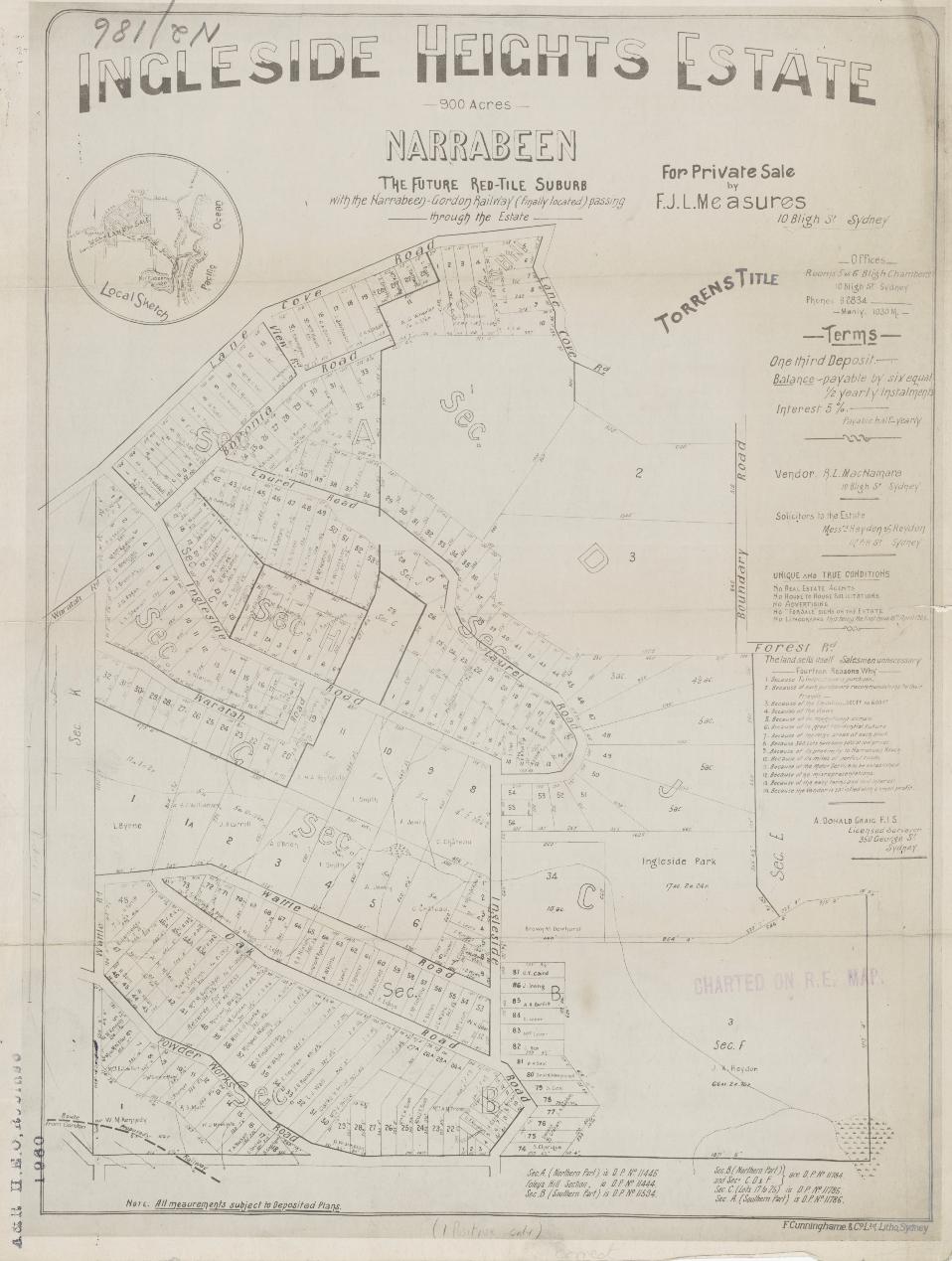
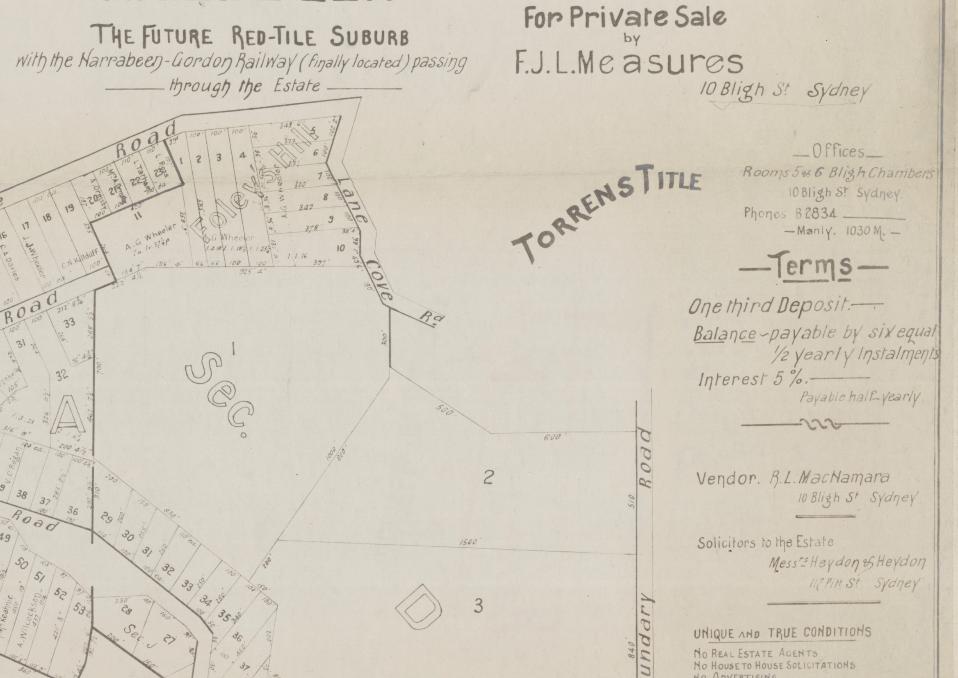
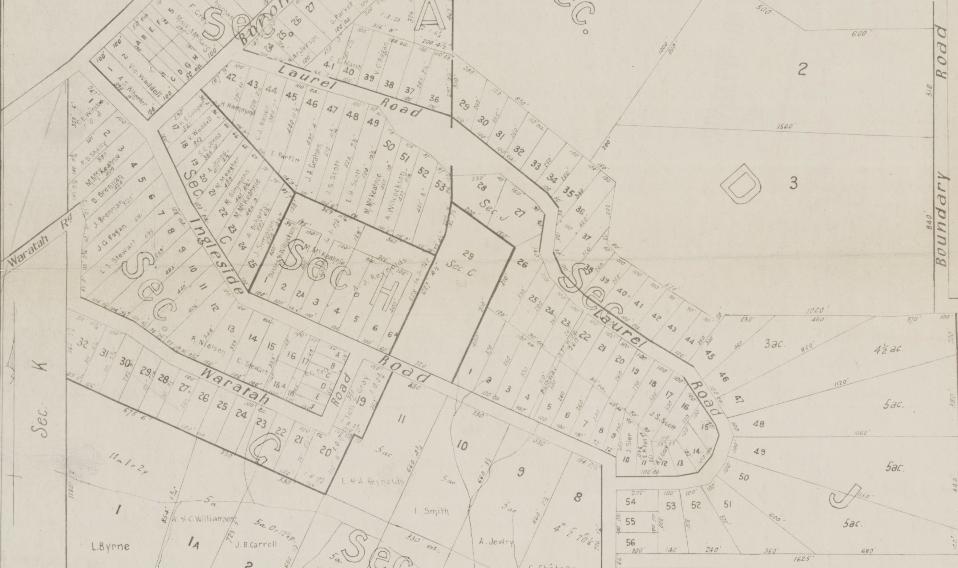
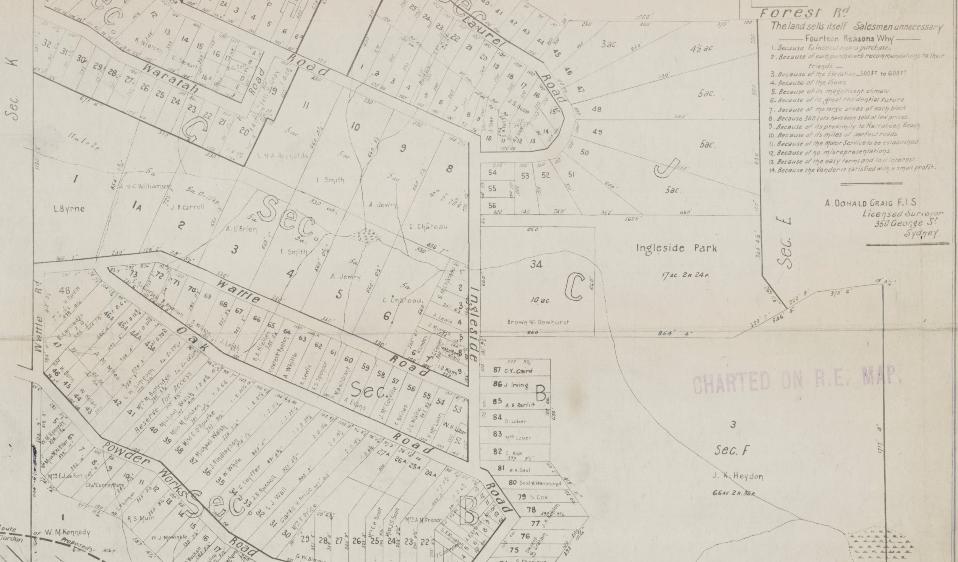
Land within the suburb of Ingleside was granted between 1867 and 1886 as farm lots of between 40 and 640 acres. Mona Vale Road (originally called 'Lane Cove Road') is already shown on an 1867 parish map while Pittwater Road was established by 1870 with a bridge later replacing the ford crossing over Narrabeen Lagoon, allowing for further accessibility and urban expansion.
Early Development of Ingleside
By the 1880s, Sydney’s population growth had caused the price of Sydney land to increase. This encouraged land acquisition outside of Sydney, including areas such as Pittwater. All the land within the suburb of Ingleside had been granted by 1886 but the area was sparsely settled.
Prominent landholders within the study area included Gustave Lix, whose 640 acre property (portion 63 of the parish) included the land on the eastern side of Mona Vale Road north of Powderworks Road; and James Jones, who was granted several portions of land on the northern side of Mona Vale Road.
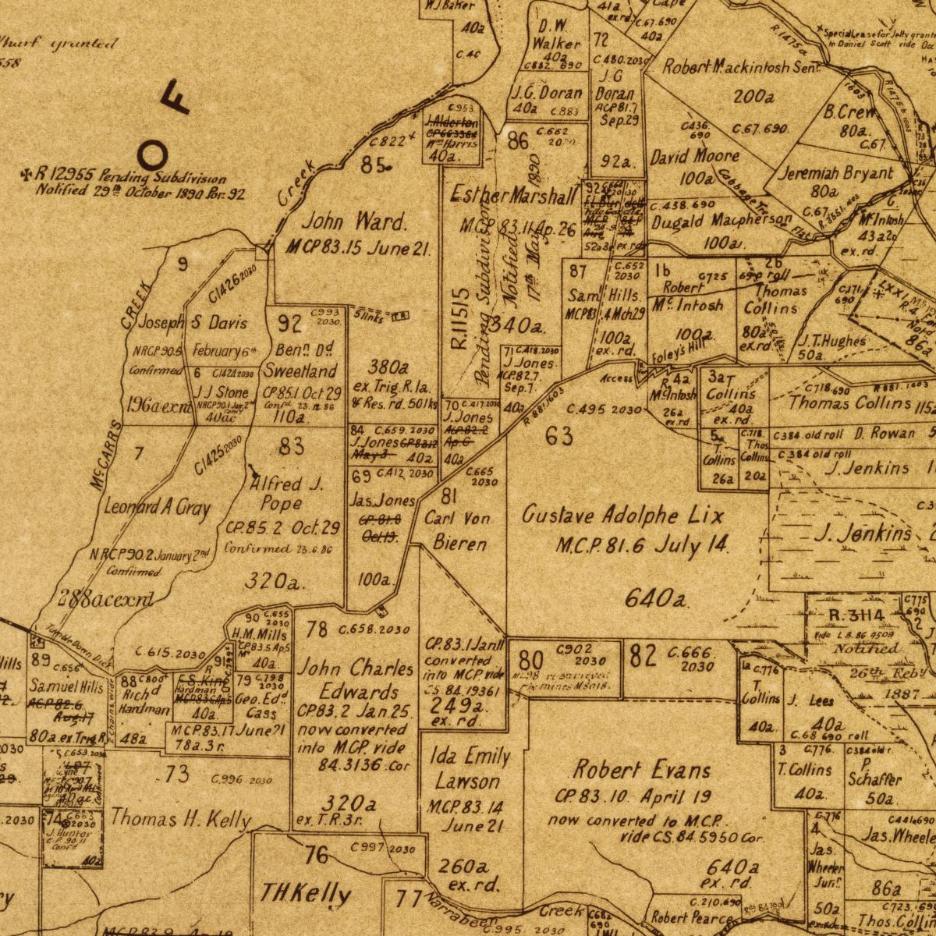
Above: New South Wales. Department of Lands. Parish of Narrabeen, County of Cumberland [cartographic material] : Metropolitan Land District, Eastern Division N.S.W.1886. MAP G8971.G46 svar (Copy 1).
Ingleside House and the Powderworks Factory
Most famous of the Ingleside's early landholders was Carl von Bieren, a Dutch American chemist who arrived in Sydney in 1882. On January 11th, 1883, he selected 320 acres at Narrabeen as a conditional purchase for the construction of a powder works factory. This land was Portion 81 of the parish and later measured at 249 acres.
Accounts of von Bieren’s background vary and sometimes he used the Dutch surname Van Buren, suggesting a connection with the prestigious Van Buren family of New York. Most accounts, however, indicate that he graduated as a chemist from Heidelberg University and was formerly proprietor of the Philadelphia power mills, Pennsylvania. There was also an association with San Francisco where the word 'Ingleside', after which he named his home, may have originated from. That city certainly has a long and still celebrated history of its 'Ingleside Terrace Houses'.
During 1883–1884 von Bieren cleared over five acres of dense vegetation and built the home name Ingleside House and from which. the suburb of Ingleside was named.
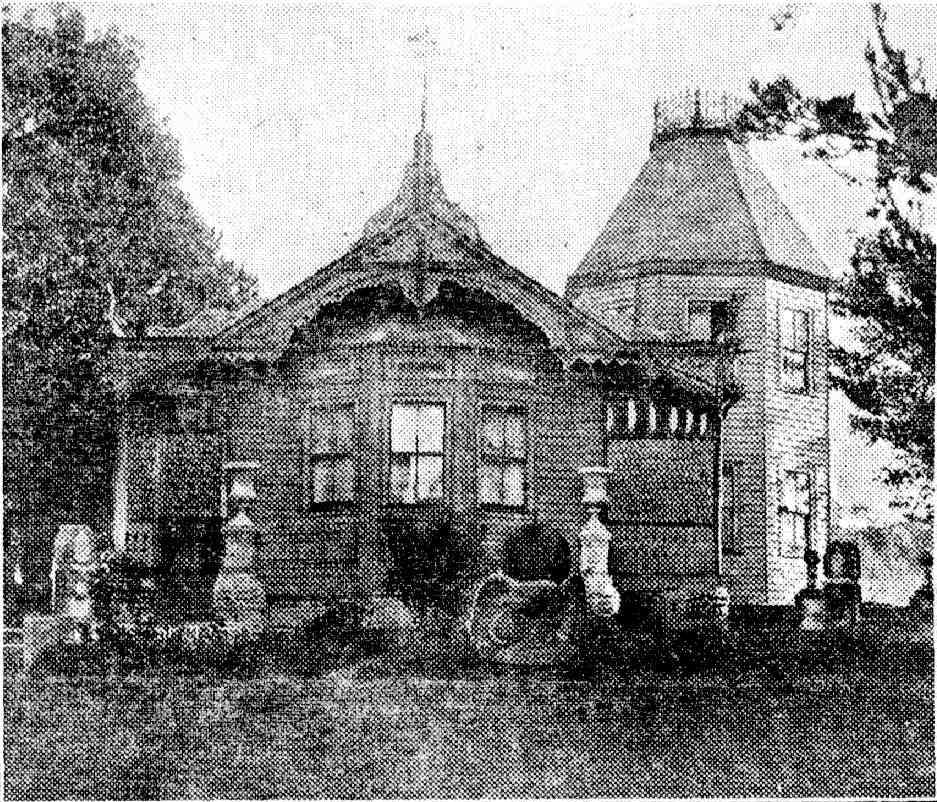
The house located adjacent to Mona Vale Road was of timber construction adorned with elaborate stonework, roofed with dull red tiles, and had an octagonal tower.
Surrounding this home, von Bieren constructed various outbuildings including men’s quarters for the workers, stables, saltpetre and a cow shed. A daughter was born to Carl and his wife Annie Scott on February 16th, 1884. The birth certificate records the place of birth as ‘Ingleside Powder Works, Narrabeen’.
Von Bieren had purchased the land at Ingleside with the plan of constructing an explosives factory and on the March 6th, 1884 the following notice appeared in the Sydney Morning Herald:
An important industry is about to be established at Narrabeen, where the necessary structures are being erected for the manufacture of gunpowder and blasting powder of various kinds. The proprietor of the works is Mr C Van Buran, formerly proprietor of a large powder mill in Pennsylvania, who has been fortunate enough to secure a site which is exceedingly well adapted for powder mills, and at the same time at a sufficient distance from the city, and so isolated, as to leave no room for apprehension of danger in the event of an explosion taking place. It is hoped that the works will be sufficiently advanced in six weeks’ time to enable the proprietor to commence the manufacture of black powder.
Von Bieren claimed that he had been given permission by the Government of NSW in February 1883 to manufacture explosives and was hoping to supply gun powder to the Australian market. He registered his business called the ‘Australian Powder & Explosive Manufacturing Company’.
On August 16th, 1884, the Town and Country Journal wrote a further article on the factory entitled ‘Gunpowder in NSW’, where the merits of von Bieren’s enterprise were highly praised. This article stated that the:
factory at Ingleside is likely to prove the model for similar establishments which the requirements of the near future may call into existence, .. the enterprise will not only supply a want long felt by both the Government and the community generally, but will give this colony great advantages over the sister colonies in mining operations and the construction of railroads and other public works, and will, as has been aptly observed by the Hon. W.B. Dalley in a speech he recently delivered at Ingleside, add greatly to the security of the colony in the event of its independence being threatened.
The Powder Company's Works, near Manly, N. S. Wales.
1. The Manager's Residence. . 2. Rocks split by Experimental Blast. 3. The Powder Works.
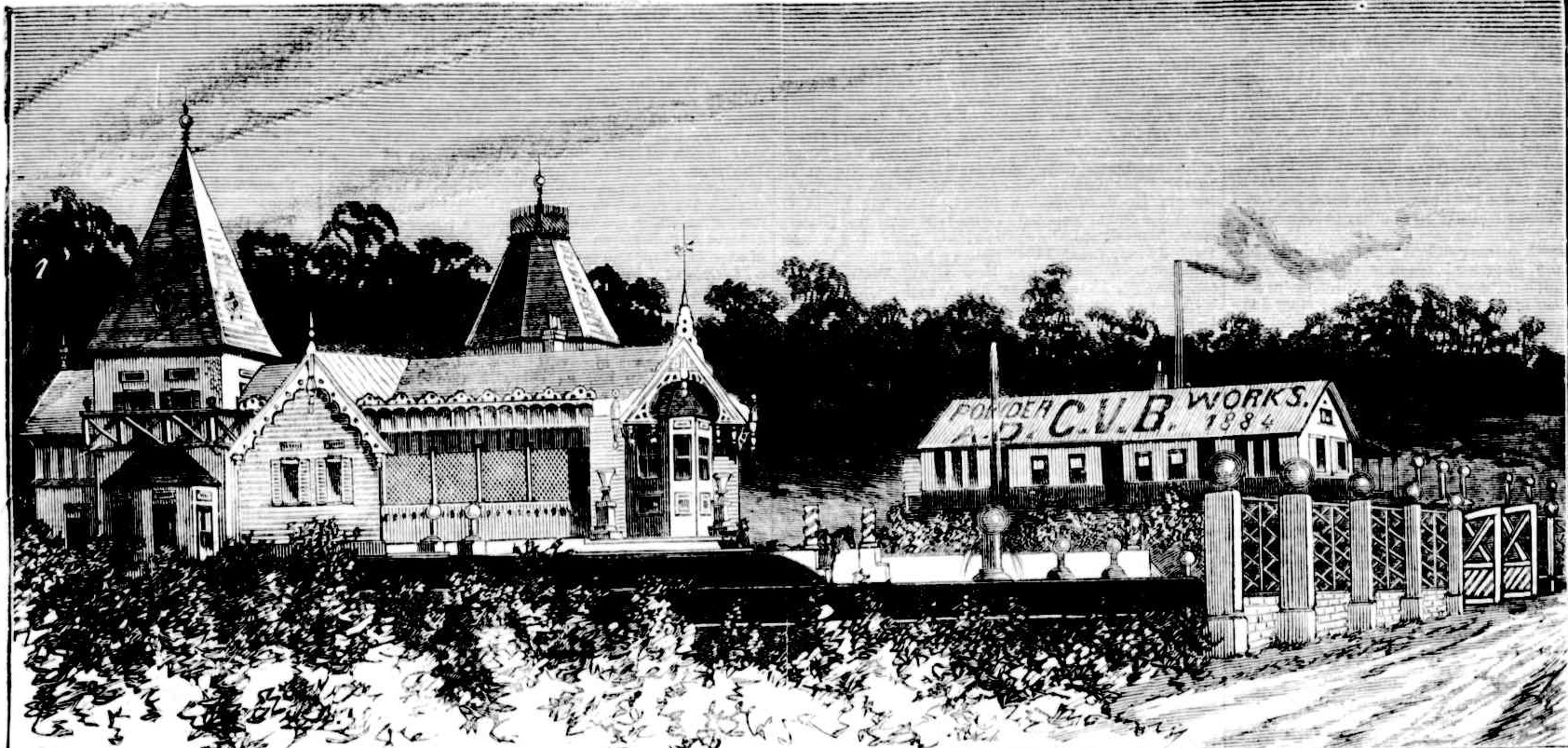
.jpg?timestamp=1561437809362)
.jpg?timestamp=1561437843903)
The Powder Company's Works, near Manly, N. S. Wales. (1884, August 16). Australian Town and Country Journal (Sydney, NSW : 1870 - 1907), p. 26. Retrieved from http://nla.gov.au/nla.news-article71016034
Writing in 1885 Francis Myers described Ingleside House as follows:
… Mr Von Bieren most courteously entertains all visitors in his charming little home. Those who roam in search of the beautiful will not be concerned with the powder works, but they will certainly halt before this chalet, as in sight of Narrabeen Waterfall or Manly Cove. It is like an actual shrine to some deity of the flowers of the land, and quite unlike any other house in or about Sydney, or Manly, or any other Australian town. You might imagine it imported as it stands, from the Tyrol, built under the inspiration of peaked mountains and tapering pines, and the grace and colour which the humanity of that high fair land loves to display. It is a little house that contains a lot of accommodation, long and lofty rooms, approached beneath peaked and gabled verandahs, or by quaintly carved flights of stone stairs, with a little octagon tower in the centre, containing boudoir below, study above, and over all a little gallery, beneath a steeple roof.
Roof of a deep dull red, that suits the landscape as well as do the old red tiles, the tiles that Ruskin loves to praise, the village scenes of England. All this beauty M. Von Bieren designed for himself, as also the carved stone fountain, fed from a reservoir excavated in the hill above, and the terraces, parterres, and elaborate surroundings of the garden. It is indeed a marvel in the bush, and it is, in a certain sense, instructive to contrast these fair and adequate provisions for all the requirements of a cultured and refined humanity with the arrangements we are more usually familiar with in our bush; the uncouthness, the rudeness, the lack of any consideration for the higher, better life, which characterises, not the Australian pioneers only, but the wealthy settler of the second or third generation. It is to be hoped that Mr Von Bieren’s chalet, as his powder, will work in the land, to the shattering of many crude old notions, and parsimonious prejudices, that he may aid in the blowing away of that still old English notion of a house, which bars the way to a full development of the architecture natural to and worthy of our land.
An access road to the house and works was constructed from Mona Vale Road and became known as 'Powderworks Road'. It was officially surveyed in 1885.
Most of the Ingleside Powder Works story has been collected in a page named for this Pittwater Field of Dreams, including the various reasons the venture failed. Rain, poor access due to the condition of the roads, its isolated position and the high cost of labour caused delay in the construction of the Powderworks and von Bieren was forced to float his company to raise more capital. Despie the progress of the construction of the Powderworks being reported favourably Mr. Von Bieren was getting deeper into debt.
At a meeting of the shareholders on July 30th, 1885, it was stated that they were expecting to begin production in six weeks’ time. On August 15th, 1885, a large party of gentlemen, at the invitation of the Mayor of Manly, paid a visit to the Powderworks at Narrabeen and inspected the whole of the works. Mention was made of the magnitude and substantial character of the buildings; and the fact that all the latest improvements in machinery had been introduced and £35,000 already spent on the works. It was estimated that the average output of gunpowder would be ten tons per day.
While this was the public image of development of the Powderworks, the reality was far different. On top of the growing debt, and workers who had not been paid for months, as later court reports showed, John Taylor (alderman from Manly Council) who had been contracted to build a second group of buildings at the works, had made the building of iron rather than copper and the buildings had been condemned.
In early October 1885, before any gun powder had actually been made at the factory, von Bieren fled the country. His wife and child had left a few months earlier for Philadelphia:
The many friends of Mrs. Van Bieren, wife of the worthy manager of the Ingleside powder works, will learn with interest that she is about to take a six months' holiday in the States to recruit her health. BREVITIES. (1885, July 15). Evening News (Sydney, NSW : 1869 - 1931), p. 5. Retrieved from http://nla.gov.au/nla.news-article111009968
Von Bieren was arrested on his arrival in London, charged with fraudulent insolvency, and returned to Australia where he was tried for this crime. He was found guilty but with a strong recommendation to mercy. Many witnesses had testified to his previous good character. Von Bieren spent two years in Goulburn Gaol and then returned to New York in January 1889, never to return to his Powderworks factory.
In May 1889 the Narrabeen Powderworks was put up for sale by the shareholders. In an advertisement for the sale in the Sydney Morning Herald, the following detailed account of the assets were given:
Ingleside House site
l. Ingleside – A well-built and well-arranged W.B. Dwelling-house, containing 11 rooms and the necessary offices, surrounded by a garden of about 2 acres in extent. This would make a Charming Country Residence. The detached buildings, also of W.B., comprise storeroom, buggy-house, and stabling for 2 horses, and carpenter's and blacksmith's shop at rear, constructed of corrugated iron.
2. Large Brick Buildings roofed with shingles, 50 x 28, formerly used as saltpetre-house, with 3 coppers and furnaces set in brick, with chimney stack; also, brick storeroom 18 x 25.
3. Large W.B. building, formerly used for offices dining-rooms - size 70 x 20, with W.B. kitchen adjoining 35 x 15. These Buildings are on the elevated table land close to the house; they are well-built and finished, and quite new.
At the rear, on the hill above, is a large tank, partly excavated in the solid rock, capable of containing nearly 400,000 gallons of water, from which pipes are laid conveying the water to the house, and the whole of the buildings, thus affording an abundant water supply.
Powderworks Site
A Large Stone Store and Offices, containing on first floor two rooms, each 18 x 16, and on basement also two rooms of same size, and three storerooms, each 10 x 36; stone tower for lift, fitted with all necessary appliances. One Corrugated iron Building 18 x 21. One ditto, 50 x 82, and small Engine -room with Engine and Boiler. Also, Large Corrugated iron Building, 30 x 100, and about 60ft. in height, comprising four floors, each partly lined and fitted shafting for every floor. Attached to the top floor is an enclosed covered way to an Engine-room, 40 x25, which has [a] Cornish boiler set in brick, also three furnaces and six retorts; the whole is in excellent order and quite new.
The 249 acre property was sold several times over the next few years and then subdivided in 1923.
The buildings of the Powderworks remained on the site unused and gradually falling into ruin. These ruins are still on the land and have been photographed over the years in various stages of deterioration.
Ingleside House after von Bieren
Isaac and Florence Larkin became the caretakers of Ingleside House after Von Bieren’s departure.
The 249 acre property was sold several times between 1895 and 1923 before it was purchased by Rosa MacNamara and the land subdivided as DP12115 into 125 mostly residential allotments.
The Ingleside House site was retained on 5 acres (Lot 42); however, from as early as 1924 images and then newspaper articles record that the house was in ruins. When members of the Manly Warringah and Pittwater Historical Society visited the site in August 1927, they stated that ‘only a few stones of the old house remain’.
In July 1939, Ingleside House was described as follows.
It must have been a grand old structure in its day, but now, after the passing of a mere half a century, how little of it remains. The stone work of the circular drive that once knew the scraping of carriage wheels as they drove in past the fountain [can still be traced]. Of the building itself there is little to see except a few tiers of crumbling masonry–a column or two bearing the inscription ‘Advance Australia’ and a raised carving of a gunpowder keg: from the stonework the letters ‘Ingleside House 1884’ still stand out forlornly.
Rosa MacNamara sold Ingleside House on 5 acres to George Ingram-Pearson (a Methodist minister from Manly) and his wife Margaret in 1937. It would appear they were responsible for the construction of the new Ingleside House (constructed on the site of the old house) as most references give its date of construction as 1939. However, as can be seen from the above SMH article, there was no sign of a new house being constructed in July 1939.
The new house was a different design from the original house and was made of sandstone thought to have been quarried from a site opposite. The original gates and gardens of the first Ingleside House were retained. Sadly in 1940 George Ingram-Pearson died; and in 1942 Margaret sold the 5 acre property to Joseph and Ethel Cook.
The property exchanged hands frequently over the next few years until purchased by long-term owners James and Evelyn Coustin in 1954. The c1939 Ingleside House remains on a reduced site today with much of its original 1884 garden remaining.
James Jones
In the 1880s James Jones, described in land titles documents as a 'farmer from Narrabeen', purchased four portions of land on the northern side of Mona Vale Road—in the area now known as Ingleside— amounting to 240 acres. On his largest grant, Portion 69 of the parish which contained 100 acres, Jones cleared a portion of the land opposite Powderworks Road and constructed a house for himself. This house is shown on a Crown Plan of the site labelled ‘Jones House’.
On August 1st, 1899, Jones sold his house on eight acres to Isaac Larkin who had been caretaking Ingleside House since the departure of Von Bieren. On the same day he sold a further three acres adjoining this site to the north to John Van Houten.
No other portions of land from Portion 69 were sold or developed and Jones owned the remainder of this land until 1924.
Waratah Farm, the Larkin Family and the Monterey Pines
Isaac Larkin and his family moved to James Jones former property in 1899. They called their land ‘Waratah Farm’. It is not clear if the Larkin’s occupied Jones’ former house or constructed a new house but it seems more likely that they built a new house as the location of the Larkin’s home is shown on aerial photographs closer to Mona Vale Road and further north than Jones’ cottage. At Waratah Farm, Larkin cleared the land and planted an orchard. It was here that he propagated the Narrabeen Plum, a variety that was registered with the Department of Agriculture and remains popular to this day.
Visit: Waratah Farm: Ingleside - The Narrabeen Plum

.jpg?timestamp=1570144050514)
.jpg?timestamp=1570144077512)
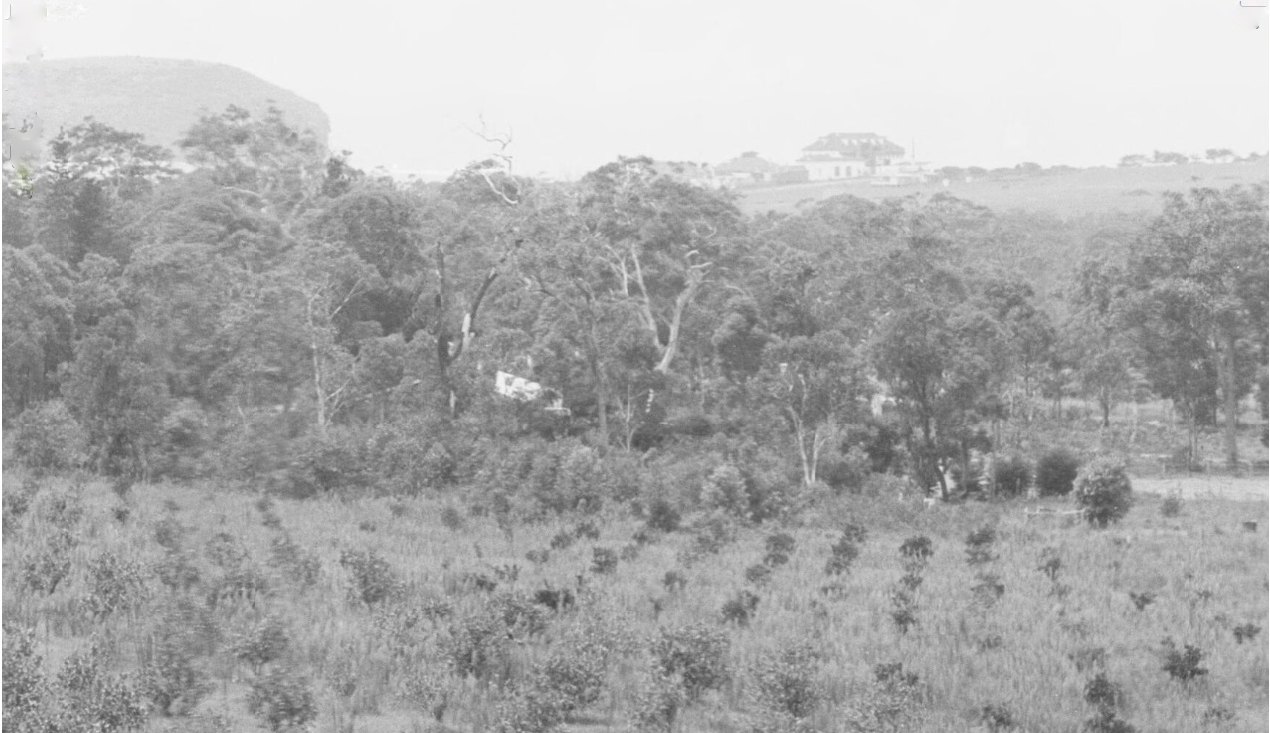
.jpg?timestamp=1570144130410)
.jpg?timestamp=1570144155794)
The goods from this farm were transported by horse and dray to Manly Wharf, where they were consigned by an agent to Sydney markets and taken over by ferry. The Larkin family has had a very long association with the Ingleside-Narrabeen area. The four eldest Larkin children attended Narrabeen Public School, travelling there on foot, and the three youngest went to Mona Vale Public School when it first opened. Robert, the eldest of the Larkin sons lost a leg during World War I and on his return to Waratah Farm, started a hire car business, which was very "new" in those days. Another son, Arthur, set himself up as a general contractor with a horse and dray. His tasks were varied. Among these were the first bridge across Narrabeen Lakes at Ocean Beach, the first roads in the Warriewood area, the Collaroy Heights roads for the Salvation Army and the Collaroy and Narrabeen rock pools for Warringah Shire Council. He also built most of the early jetties and wharves around the Pittwater foreshores.
The Larkin’s home, later known as ‘the Pines’ is shown on historical aerial photographs of the site up until the 1980s.
Waratah Farm and the adjoining 3 acres were purchased by the Crown in 1920 as a settlement purchase under the provision of the Closer Settlement Act, but aerial photographs from 1930, 1947 and 1961 show that the properties continued to operate as orchards and market gardens.
In 1951 the majority of the two farms were in the ownership of the CBC Bank and sold to Lawford Burns, poultry farmer, in 1953.34 The land was then converted for use as a poultry farm and agriculture ceased. A 1970 aerial photograph shows the land no longer under cultivation but containing several rows of sheds.
The land was again resumed by the Crown in 1971 as a possible site for the construction of Ingleside High School —a proposal that never eventuated. The land has been re-subdivided in recent years and remains as small acreage allotments with a plant nursery and several new buildings constructed on the site. The site of the original Larkins home is now occupied by a tennis court with a modern residence behind.
It has previously been stated that a group of Monterey Pines from the former Waratah Farm (planted c1900 by the Larkins family) remain. These pines are shown in early photographs of the site as small trees. These pines are not shown on a 1930 aerial photograph of the site indicating that the existing pines were not planted c1900.
1920s Subdivision
During the 1920s, subdivision began of some of the large landholdings at Ingleside, beginning with several subdivisions of Gustave Lix’s land in 1922 and 1923 and a subdivision of Baron von Bieren’s original grant (DP 12115) in 1923.
These subdivisions contained mostly small acre farm blocks of between 4 and 20 aces, but also included some residential allotments. Land along the Mona Vale Road frontage of Portion 69 (James Jones’ original land grant) and along the western side on Chiltern Road was subdivided in 1926 into 33 residential allotments (DP13953). This land did not sell except for a one acre lot which was purchased by Dr Henry Percy Pickerill, a Macquarie Street doctor, in 1929. This land later became known as Klerk’s Garden, or Klerk’s Nursery.
NARRABEEN HEIGHTS.— VARIOUS ALLOT
MENTS In INGLESIDE HEIGHTS ESTATE,
having frontages to GORDON and MAIN
PITTWATER ROADS. (Mortgagee Sale.)
...
Richardson & Wrench Ltd.,
AUCTIONEERS. Advertising (1927, August 5). The Daily Telegraph (Sydney, NSW : 1883 - 1930), p. 27. Retrieved from http://nla.gov.au/nla.news-article246403724
Cicada Glen Nursery
Lots 21 to 24 of the 1926 subdivision DP 13953 (part of James Jones’ 100 acres) were re-subdivided and part of this land was purchased by Dr Henry Pickerill in 1929. This one acre property he called ‘Caradoc’ and here Pickerill constructed a fibro cottage for use as a weekender. Each weekend he rode up the ridge from Narrabeen by horse and cart to his property.
Dr. Pickerill later married Cecily Clarkson and the property was transferred into her name in 1931. Most of the older plantings on the site including the Hoop Pine, English Oak, Pine Oak, Japanese Maple, Canadian Maple and Liquid Amber, as well as the fish pond, were installed during Mr Pickerill’s ownership (Figures 2.30 to 2.31 show the land during Pickerill’s ownership).
The property was sold to Herbert Bearse and his partner Carman Sedgers, market gardeners, in 1950; and they grew cut flowers for the Sydney Market.
In 1965 Theodorsus Klerk, nurseryman, and his wife Jacoba purchased the property and commenced operations as Klerk’s Nursery, an enterprise they continued until 1999. The Klerks had arrived in Australia from Holland in 1951, living first in Elanora Heights before purchasing the Ingleside property.
They moved into Pickerill’s cottage in 1965, enlarging the bedroom and later constructing an office adjoining the house on the site of Pickerill’s old garage. When the Klerks purchased the site, the property already contained seven sheds including a bush house, tool shed and a chook yard towards the rear of the property, plus two water tanks.
Mr Tao Klerk and his wife Kobe (as they were commonly known) were responsible for the planting of the mature palms, tree ferns and bamboos, as well as the Fiddlewood, Brushbox, Golden Cypress and Fir on the site. These later ornamental plantings and the sandstone lining of the dam and watercourse (Cicada Creek) were installed by Mr Klerk during his occupation of the property.
The current owners purchased the property in 2002 and operate a retail/wholesale nursery and sandstone sculpture business from the site which they call ‘Cicada Glen’. Pickerill’s cottage remains on the site and is being used as a residence and the office for the existing business.
Prior to the 1950s only limited development took place at Ingleside, especially on the northern side of Mona Vale Road.
From the late 1920s until the 1970s, the Warriewood Valley and small parts of Ingleside were transformed as Sydney’s major tomato growing area. Glass houses filled with tomatoes became a prominent feature of this area. This industry was made feasible because of improved access roads and the construction of the Spit and Roseville Bridges. The market gardeners were predominantly Yugoslav (Serbs and Croat) migrants. By the 1980s this industry was in severe decline and the land in the Warriewood Valley began to be developed for residential and light industrial use. Ingleside retained its rural character as in 1951 the state government restricted subdivision and building on any lots less than 2 acres.
Ingleside - Later Twentieth-Century Development
The remainder of the land at Ingleside was not subdivided until the 1950s and 1960s, and again this was into small farm lots. The subdivision with its semi-rural feel attracted a mixture of people from animal lovers wanting small farm holdings; migrant families who often used their land for market gardens; and wealthy individuals who constructed large scale dwellings within a semi-secluded small holding. There were also church groups, specialised schools, animal welfare groups and nurseries who took advantage of the lower prices.
A problem with the area was the lack of infrastructure as water and sewer mains were slow to be implemented. From 1951 onwards, the state government also began to purchase lots within Ingleside to stall the need to provide these services. The land affected was mainly located within the former landholdings of Lix and on the portion of Von Bieren’s land located on the northern side of Powderworks Road.
This government landholding became known as the Blue Hatched Area and approximately 70% of it became government owned. A building freeze was placed on the remaining privately owned properties less than two hectares in size. While the building freeze stalled urban expansion in Ingleside, the area attracted other uses.
List Of Streets In Ingleside
Addison Road
Bloodwood Road
Boronia Road
Boundary Street
Bungendore Street
Cabbage Tree Road
Caladenia Close
Chiltern Road
Cicada Glen Road
Emma Street - See Warriewood Roads, named for wife of earliest subdivider
Emmaus Road
Forest Road
Harvey Road
Ingleside Road
Kimbriki Road
King Road
Lane Cove Road
Laurel West Road
Laurel East Road
Manor Road
Mccowen Road
Mclean Street
Minkara Road
Mirbelia Parade
Mona Vale Road
Powder Works Road - named for powder works factory
Tumburra Street
View Road
Walter Road
Waratah Road
Wattle Road
Wilga Street
Wilson Avenue
Wirreanda Road
Wirreanda North Road
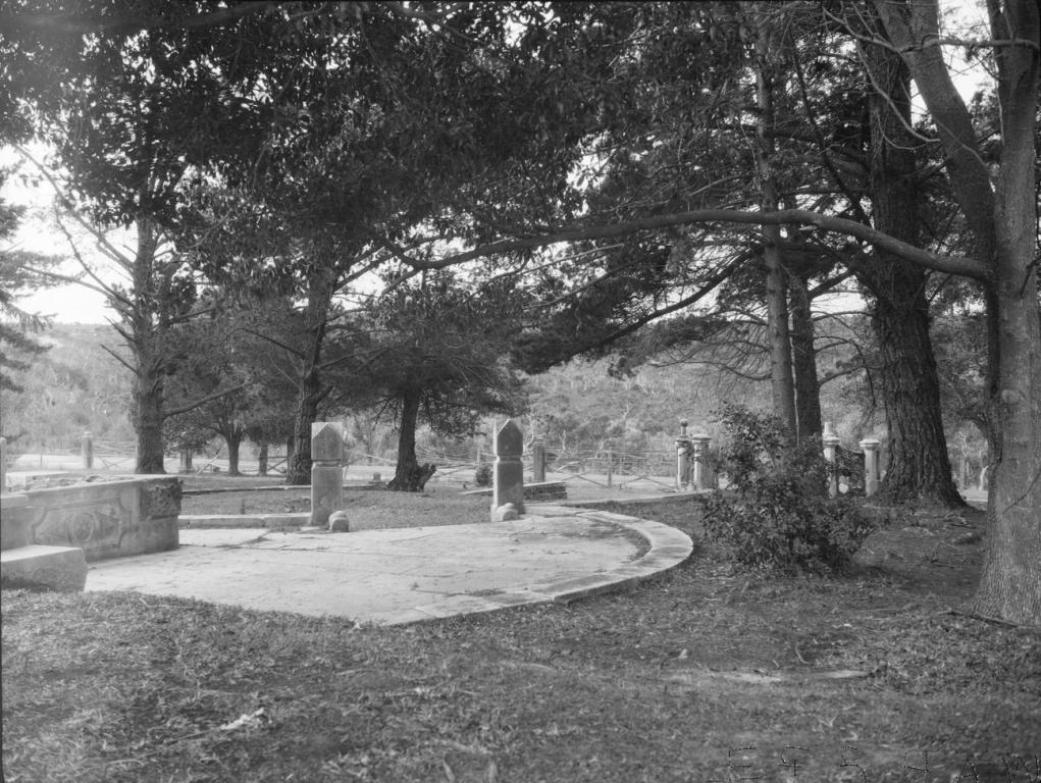
Some Of The People Behind The Street Names
George Scales worked as a stonemason. Married twice, he had three children by his first wife and three with his second. Although he was a rich man when he passed away, his earnings seem to have come through sheer hard work and living on next to nothing - as a court case brought by his wife, seemingly unnecessarily, reveals.
No. 17,0.58. APPLICANT:—George Scales, Manly. LAND:—County Cumberland, parish Manly Cove, shire Warringah, 1 acre 3 roods 33 perches, in Ocean street, Narrabeen,—lots 2 to 7, section 24. Mount Ramsay Estate, and part 410 acres (portion 1,217 of parish) granted to John Ramsay; adjoining property of Mrs. M. Thompson. NOTICE UNDER REAL PROPERTY ACT. (1911, June 28). Government Gazette of the State of New South Wales (Sydney, NSW : 1901 - 2001), p. 3480. Retrieved from http://nla.gov.au/nla.news-article226774250
No. 17,037. APPLICANTS :—George Scales and David Lindesay Aitken, both Sydney. LAND : — County Cumberland, parish Manly Cove, shire Warringah, 96 acres 2 roods 7 1/4 acres, on Narrabeen Creek, near Narrabeen Lagoon,—land granted as 30 acres (portion 51 of parish), to James Wheeler, and 50 acres (portion 48 of parish), to John William Alexander White; adjoining property of estate late T. H. Kelly and Crown Land. NOTICE UNDER REAL PROPERTY ACT. (1912, April 10). Government Gazette of the State of New South Wales (Sydney, NSW : 1901 - 2001), p. 2230. Retrieved from http://nla.gov.au/nla.news-article227591158
Mr. George Scales' Will
Paddington Man Leaves £44,745
Probate has been granted of the will of George Scales, of Paddington, freeholder, who died on July 20 last. The estate was valued at £44,745, of which £32,381 was represented in realty. Mr. Scales bequeathed his two sons by his first wife, Leonard and Ernest Scales, £200 each. The residue of his estate he left upon trust. Out of the Income he directed that there should be paid £2 10s a week to each of his daughters, Marie Garatia, and Elsie Annie during the life-time of his widow, and that the residue of the income should be paid to his widow. After the death of his widow, the trust estate is to be distributed for the benefit of his children. Mr. Scales appointed David Lindsay Aitkin, of Sydney, solicitor, and Joseph Reuben Wolstenholme Battye, of Sydney, accountant, the trustees and executors of his will. Mr. George Scales' Will (1920, December 13). Evening News (Sydney, NSW : 1869 - 1931), p. 1. Retrieved from http://nla.gov.au/nla.news-article117300519
WEDDINGS
RAITH— SCALES.
At the Presbyterian Church, Globe Point, on Saturday, Miss Elsie Scales, eldest daughter of Mrs. Scales and the late Mr. George Scales, of Paddington, was married to Mr. J. Lauder Raith, eldest son of Mr. and Mrs. C. Raith, of Glebe Point. Rev. Clifford Button officiating. The bride, given away by her brother-in-law. Mr. Wrobel, wore a smart frock of ivory crepe-meteor and silk lace, embroidered with a spray of hand-made flowers, and the long train of silver tissue was lined with shell-pink and lemon georgette. Her embroidered net veil was held in place by a wreath of orange buds, and she carried a bouquet of choice white flowers. Miss Jessie and Miss Isobel Raith, as bridesmaids, wore frocks of pink taffeta over Georgette. Little Mary Wrobel was train-bearer, and looked nice in a pink georgette frock. Master J. Wrobel, the little page, was In a white satin suit. Mr. Bruce Raith was best man, arid Mr. Norman M'Queen groomsman The bride's mother received the guests at Sargent's. Market Street. The honeymoon Is being spent on the Mountains, the bride's travelling dress being a grey gabardine costume and a grey hat with a lace brim. WEDDINGS (1921, December 5). The Daily Telegraph (Sydney, NSW : 1883 - 1930), p. 3. Retrieved from http://nla.gov.au/nla.news-article239714756
SCALES WILL CASE
A DUAL OCCUPATION.
MELBOURNE, Thursday. — In the Scales will case to-day Winifred Campbell, the eldest daughter of the late George Scales by his former wife, said that in 1896 her stepmother did washing for the navy, her father being a stonemason. Mrs Scales carried on the Parisian Toilet Company in the Arcade, and Mr. Scales made up some, of the toilet requisites, but when there was washing for the navy to be done she divided her time between the two occupations. In 1897 Mrs. Scales commenced seances and circles and healing at the Arcade. Witness had never heard of any money being dug up out of the backyard, nor had her father sat up the whole of one night, counting his fortune. The case stands part heard. SCALES WILL CASE (1922, August 4). Daily Telegraph (Launceston, Tas. : 1883 - 1928), p. 4. Retrieved from http://nla.gov.au/nla.news-article153351237
Scales v Aitken and another.
Further evidence was given in the Equity Court on Wednesday in the suit in which Mary Scales, widow of George Scales, asked, among other things, for a declaration that the defendants, David Lindsay Aitken and Joseph Reuben \Wolstenholme Battye, as executors and trustees of her late husband's estate, had acquired as trustees for her, all property the legal or equitable title to which stood in the name of, or was otherwise vested in, her husband at the date of his death. His Honor (Mr. Acting Justice Owen) allowed the matter to stand over generally pending the result of the Evidence Bill now before Parliament.' His Honor strongly advised the plaintiff, who had been conducting her own case, to, in the meantime, employ a reputable solicitor and barrister, with whom the defendant's counsel could confer with a view to a settlement of the suit, plaintiff having stated that her sole object for instituting the proceedings was in order to protect the rights of her children and grandchildren. His Honor added that the plaintiff was doing herself a grave injustice in attempting to conduct her own case. Scales v Aitken and another. (1922, August 10). Goulburn Evening Penny Post (NSW : 1881 - 1940), p. 2 (EVENING). Retrieved from http://nla.gov.au/nla.news-article99205503
'PSYCHIC' MRS. SCALES.
HER TALE OF BURIED TREASURE THE WASHTUB AND THE £12,000.
QUESTIONS ABOUT SECOND SIGHT AND TRANCES
The litigation over the will of the late George Scales, the stonemason, whose head, as far as money-making was concerned, was screwed on right, was advanced another stage during the week. The widow. Scales' second wife, Mary Scales, who for years past has been a well-known clairvoyant and moneygetter, is asking the Equity Court to declare that all the property which Scales had in his own name was really hers, claiming that it all had been purchased with her own earnings.
The case is being heard before Judge Owen, and while the plaintiff is conducting her own case in person, the two executors under the will, David Lindsay Aitkin, solicitor, and Joseph Reuben Battye, accountant, are represented by Mr. Innes. K.C., and Mr. Little.
Briefly stated, the will of George Scales, made on July 19, 1920, the day before his death, at his home, 120 Dowling-street, Paddington, was witnessed by F. Lambert, of Surry-street. and Dr. G.- A. Smith, M.B., Cb.M./of Macquarie-street.
Scales had six children alive, and one dead, three by his first wife and two girls and a boy being by his second wife, the plaintiff In the suit. After appointing Aitkin and Battye the executors, it bequeathed to his two sons by his first wife, Leonard and Ernest Scales, £200 each, and nothing to the daughter by his first wife, because she was married. The whole of the real estate was left to the trustees on trust for his wife during her lifetime.; with the exception of 50s per week each left to their two daughters. Mary Galatea and Elsie Annie, during his wife's lifetime.
After the DEATH OF MRS. SCALES, the trustees were to turn the estate into money and pay one-fourth to Mary Galatea, one-fourth to Elsie Annie, one-fourth to Alfred Daniel, daughters and son of tho ' plaintiff;1 with one-eighth to his daughter Winifred Campbell, and one eighth to the children of his dead daughter, Winifred Elizabeth Wroebel.
The will, said. 'My reason for leaving only £200 each to Leonard and Ernest is that I acknowledge that whatever property I am at present possessed of is the result of moneys earned and saved by my present wife, which she has given me'.
When the hearing was resumed on Tuesday, Mrs. Scales took her usual position, standing ever at the bar table, resting on a black walking-stick, and in answer to his Honor's question, said she was ready to go on. Throughout the day she remained almost motionless, most of the .time eyeing Mr. Innes, who was appearing for tho other side. Mr. Innes remarked that his task would have been easier had Mrs. Scales been represented by counsel.
Mr. Aitkin produced a statement showing in detail the properties which Scales hid bought in his own name 'during the years Aitkin had acted for him with the sum purchased, and in many instances the sum sold. Most related to suburban allotments of smallish value, the whole of the properties being estimated at C.270, and being situated in districts so wide apart as Gordon and Merrylands, Pennant Hills and Manly, Lane Cove-road and Fairy Bower.
A second statement showed in detail properties which Scales had bought in his wife's name, the total value of these being estimated at over £40.000.
Solicitor Aitkin, after giving evidence regarding these properties, said that Mrs. Scales, after her husband's death, complained that her husband's WILL WAS UNJUST, saying he had no right to leave any money away from her. She informed him that once, as she was passing the Hotel Australia, she recognised the mysterious stranger who had brought her some thousands incognito, by his voice, and said she knew the man recognised her, because he immediately rushed away.
She asked him (Aitkin) to transfer the house properties standing in her husband's name to her, but he told her that it could not be done.
In January. 1902, said Aitken, he arranged a moderate loan of £75 for Scales who had just .bought some land, and wanted the money to make up the balance. Scales told him many a time that his wife had lent him various sums of money.
Mrs. Scales; I want to know where all the money went to. He bought all this land, and where did the money -go? —If he received any money from me, I wouldn't know what he did with it. That rested with him.
To his Honor, the witness said that sometimes Scales, instead of receiving the money, asked that It be paid into his wife's account. Mr..: Innes complained that the manner in which Mrs. Scales asked the question and Its wording, were suggestive.
Joseph Reuben Battye, the other executor. gave brief evidence concerning the conversations he had with Mrs. Scales about her affairs, and said that at her request, money had been paid away on her behalf.
Mrs. Scales: I asked you for money, and you said you couldn't let me have any until it was settled up. You said you would see Aitken, and have the rates and taxes and income-tax paid for me? — Yes. | You said you would do all you could for me. but Aitken would not give me any more
His Honor: I don't wish to stop you, I Mrs. Scales, but In what way do you think this will help you? If it will help you, I DON'T WANT TO STOP YOU. But I have only to decide whether the property in your husband's hands belonged to him, or belonged to you.
The next witness was Leonard Scales, the £200 legatee, and son of Scales by his first wife, who lived at Enfield. He was forty, and remembered his father working as a stonemason: and when the family conducted a laundry.
Some of the boys and his stepmother would I bring home the washing from Woolloomooloo and his father and brothers and sisters did the washing. But his step-mother never handled any of it. Indeed, it took her all her time to collect the washing and afterwards collect the money for doing it. It comprised hammocks, blankets, and ducks. Then his stepmother — he called her mother always used to go out washing and selling honey, and private people's, washing came into the house, and we boys delivered it from Ashfield to Summer Hill'. He never saw his stepmother digging In the garden at any time.
They Washed for the Navy two or three Years off and on, whenever the ships were in port.
After his father died, his stepmother talked of the will, saying she had wanted his father to leave him a house and a pound a week only, seeing that he had no children, and the house was to go back to the family after his death. She also, said she wanted his father to leave his brother enough to educate his children.
Mr. Innes: Were you told about the money dug up in the backyard?— No, sir; I never heard of it before this case. Leonard said his sister Winifred, now Mrs Campbell, worked ever since she was nine years old, and reared all the second 'family. She ' USED TO DO THE WASHING for two people by herself.
Mrs. Scales: When used she to do so? — When you were out working by the day 'and selling honey. My father helped my sister sometimes. -The cottage in which the family resided then, said Leonard, consisted of three rooms, and there was a shed built out of packing cases in which plateglass had come.
Mrs. Scales: How many tins of honey did you sell a week? — I said that you sold the honey, but I pushed the pram for you all around Ashfield. 'Didn't you take the roof off the top and steal the honey?' asked Mrs. Scales, raising laughter, in which she joined in.
Ernest Scales, of Concord, an engineer employed by the Gas Co., the other £200 distant legatee, said he was born in 1878, and lived at home until 1900. He remembered his father's last job as a journeyman stonemason was at the Summer Hill post-office in 1899 and at this time his stepmother was going, to people's places doing washing and selling honey.
Regarding the washing for the Navy, he used to go down with his father, and they would pull over to the ship in a boat. His mother would go on board and get the washing, and they would take it home. They used to stamp the blankets in a tub of hot suds, and his father helped in that work, too. They would work all night long, and take the washing back next day. Their house was built of brick on stone, old bricks which came from the demolished portions of the railway stations. His father bought the old bricks when the stations were being altered. No, he never saw any bricks that his stepmother bought, and never heard of any. His father did the stonework, and a neighbor bricklayer, named Woods, laid the bricks. No, he never saw his stepmother working as a laborer on the building, nor had he ever seen her DIGGING IN THE GARDEN. She would sell about two tins of honey in the week, sixty-pound tins. The honey was put up in bottles, and first for a while she carried a dozen in a basket, hut later on she got a pram. He had often bottled the honey.
'After father died', continued Ernest, 'I met mother — I always called her mother — and she asked me to sit dawn in the park with her. We did. She said, 'The girls have left me', and then the will cropped up. She said that father hadn't treated us boys right, and said something about her having wanted htm to leave us a house each and something to my children to be educated with, saying they hadn't done any harm to her. She said she was not asking for the land, but only for the houses. I walked down to Sydney I with her. We stayed a good while,! and mother was crying most of the time. She talked for a little while, and cried for a little while' Leonard added that prior to this Mrs. Seal s had a conversation with him at the Burwood waiting-room. He heard a call, and on looking round,, saw her and went back.- 'Mother had the will with her', he went on, 'and said she was going to fight it, and that father had said the property and everything was hers'. I said, 'It won't matter much to me; I'm only getting a couple of hundred pounds'. Soon after this mother turned around, and said, 'I don't intend you boys to have ANYTHING AT ALL'.
The witness continued, 'One Sunday when I came back from work, Mrs. Scales was in my house talking to my wife saying she had intended that we boys should get a house and some money every week under the will and that my' children should have enough money to; educate them. She said my children! had done her no harm, and she didn't] see why they should have been left out'.!
His Honor: What was it that led her to make two different statements? — I don't know, I'm sure. My wife was doing most of the talking. I said little. I was a bit wild at mother being there, because I wanted to get some sleep, and I took as little part in it as I could,
Mr. Innes: Did you ever hear about £12,000 being dug up In the garden? — The first I heard of that was Mr. Aitken mentioning it. . Alfred Daniel Scales, the son of plaintiff, who was left one-fourth shore of the residue after his mother's death, and is a railway employee, living at Ashfield, told of tr»e part he took in carting home the washing when a boy.
Asked who did the work he replied, 'Oh, the family'. He was in the Sydney Arcade with his mother for a couple of years, before he left home to strike out for himself. Alfred recalled conversations between his mother and father respecting the property now in dispute. At the meal table he had heard his mother say to his father, when they were discussing repairs to the houses, 'Is that your property, George, or is it mine'.
Mr. Innes: Did you ever hear your father say that all the property belonged to your mother?- — Never.
His Honor: Did she say, 'Is that property in your name or mine'? — No, that was not it, but 'Is that your property, George, or mine?' You knew that some of the properties were in your father's name, and that some were in her own name?— Yes, but they were the correct words she used, I think, 'Is that your property, George, or mine?'
Continuing his evidence on Wednesday, Alfred Daniel Scales told of a meeting of the family, at which his mother complained that she was penniless, and said all the money should be hers; but he responded, 'I think you are well provided for, mother, as we get nothing until you die'.
During the fortnight following his father's, death he visited his mother every day, when the so-called unjust will formed the theme of her constant conversation. Telling more of this, interview, which he thought was about three months after his father, died, he said he told his mother that he couldn't believe that his father dug up £12,000 in the backyard without telling the children anything afterwards. He asked which backyard it happened in, his mother saying it was at Ashfield, and near a tree. He told her that it was very strange that they knew nothing about it, and inquired the date.
When she said it occurred in 1902, he remarked that it was the very year he left home, and the family were not in good circumstances at that time*. ''So well, I handed it to him, anyhow', asserted his mother, adding that the hoard consisted of sovereigns stacked in baking-powder tins, and that she and father stayed' up all night I counting the money.
'How did you get it, mother?' he asked. 'I earned it at the washtub', she said, whereupon he rejoined that IT WAS IMPOSSIBLE for anybody to earn such a sum at the washtub. She said it was dug up tn the night time. !
His Honor: I want you to be very I careful, if you can think carefully and put your memory back. When your mother spoke of handing large sums of money to your father, did she say anything at all as to tho reason why she handed them to him?- — I don't remember her saying anything. His mother asked him and others to sign it back to her, went on the witness, promising that he and the children would be well provided for, and saying that as her stepchildren were not provided for, she would provide for them, too. She further said that if he would not sign It back to her, she would fight him for it, and he wouldn't get anything then. Still, he refused to sign anything.
All she wanted back then was the house property, and the vacant land she didn't care about, saying she knew that belonged to his father. She also spoke of taking the money over to Melbourne, and giving it to her mother's people over there. At this time she did not speak too well of his father.
Mrs. Scales: How old were you when the washing was going on? — Nine or ten.
How long did it last? — About two years.
'Twas after you visited your mother in Tasmania. Dad and I followed on, and we all came back together .-Was it before Elsie was born? — Yes.
'Did Mrs. .Scales do washing before Elsie was born?' asked Mrs. Scales of her eldest son. 'She did no washing. She collected the washing and the money', eanic the answer Scales: Who did the washing? — My father. How long did Mary Nolan live In the house? — Perhaps a fortnight or a month. And Mrs. Kelly? — Never a Mrs. Kelly. And Miss McDonald? — She lived in Ashfield, and didn't work for us. I stayed at the FOOT OF THE GANGWAY while you collected the washing. Sometimes you collected from eight, ten or twenty. How could you tell if you stayed at the foot of the gangway? — I watched the clothes to prevent any going missing.
How did the money come in then? — You collected It, but father did the work to earn it.
'Who kept the house? Did your father give me money? — I know father gave you all his money that he earned working on the Summer Hill Post Office.
When you came back from India In 1911, what happened then? — 'What do you mean? I painted a terrible lot of properties, working on them continually for twelve months, possibly two years. Did your father tell you whose were the houses? — He didn't say whether they were yours or his, but Just told me what work to do on them. Who paid the men? — Father always did. Where did he get the money? — Out of his pocket. (Laughter.) Who gave him the money? — I don't know.
The witness, who served in the Imperial Army In India, and with the Imperial Army through the big war, further said that as soon as his father died, and he helped to carry the body downstairs, his mother took the key of the safe. Asked how he knew, he said that Elsie and Mary, his sisters, both told him.
His Honor: You mustn't say what others told you.
Mrs. Scales. At the meeting I said everything in the house was mine, and I would TAKE IT TO COURT. I said I wanted my step-grandchildren, who had been left nothing — I wanted them to have a good public school education, and three years at college, and afterwards I would give them £500. each. 'I can't recollect you saying anything about £500, but you said something like the rest', said witness. His Honor advised Mrs, Scales to ask questions rather than make speeches.
Mrs. Scales: I wanted his grandchildren to share and share alike with my grandchildren? — Possibly that was said, but I don't remember it. Your father was not going to leave you anything but £500? — No; it was you who said you would not leave me anything. I said all the money would go to the grandchildren, so that no wife or husband could get It? — Yes; you said the grandchildren would be well provided for. I said I couldn't understand why a fresh will should be made twelve hours before he died? — Yes; you said something like that, But you said, 'if you don't sign it back to me, the lawyers will get it all'. Didn't I say I would go to the Equity Court, as I wanted the will altered. I didn't want a penny of the money. Didn't I say, 'You are my child. You are not a loafer. You are my child, and I am fighting for you and my daughters'?-— You did say you wanted to protect the girls.
And afterwards, If my girls had no children, and all were to die, it was to go to ray poor relations? — You said something like that, and that you didn't want outsiders to get it.
Minnie Scales, the wife of the previous witness, gave brief evidence. Her mother-in-law said THE PREVIOUS WILL left everything to her, and this will should do the same. Mrs. Scales entered the witness-stand again, and stated that at the family meeting, which she said took place about the first of August, she told the assemblage that an arrangement existed under which everything was to be her husband a if she died first, -and hers if he died first. Elsie said she would do the same as the others. Witness told them, 'I don't want any money at all out of this. I only want the will altered, and to leave the children houses. No loafers to get anything'. I meant 1 didn't want any outsiders to have anything.
To his Honor: I never said to my husband, 'Is this your property, George,' or mine?' Alfred-Daniel has been away a good deal, but I have always been on good terms with him.
His Honor; You said that at different times you handed very large sums of money to your husband— you said three large sums. Was anything said about what was to be done with the money?— Yes. When my husband wanted money he would come and ask me. I carried it around my, waist. He built houses, and I kept him going with money. He told me it was all my own money-
Mr. Innes: Your daughter Mary Galatea is now married in Queensland?— I don't know where she is, Elsie Annie is married, and is expecting to be laid aside immediately? — Not for two months. To Mr. Innes: I was told that everything was left away from me. I can't say who told me. I didn't know that everything was left to me during my lifetime. I am quite clear of that. Mr. Innes; Was not the meeting held after you saw Mr. Aitkin on August 3? — No; the meeting was BEFORE I SAW AITKIN. You are quite clear that several of the family had copies of the will then? — Yes. Don't you know that Mr. Aitkin never gave a copy of the will to anybody until August 3? — No.
In advising your husband whether he should go into these speculations, did you employ your abnormal powers of second sight? — Yes. How, by trance? — I don't know. He used to sit in a circle, and I used to be under a semi-influence. He would get hold of my hand, and I was not myself. He used to tell me afterwards. Did you know what was said when he asked your advice? — No. And you didn't remember afterwards when you came to? — No. Did he consult you as an ordinary woman as well? — Oh, I am always partly under semi-influence, and I'm partly under it now. You remember now what you are saying?— Yes. You told me just now that you didn't remember', said Mr. Innes. 'Well, if you give me your hand now I'll show you', said Mrs. Scales.
SCALES.
'Oh, I haven't the fee'. 'Never mind, I'll show you for nothing'.
His Honor smilingly said, 'We will finish the case first'.
Mr. Innes (to Mrs. Scales): When were you in a trance last? — Not since 1920. Why? — I was always in trouble. I have had nothing but trouble and worry all the time through one matter or another, and I'm told everywhere I go that I am UNDER A DELUSION. So you have not been in a trance since? — No; but I'm willing to try. Were you not in a trance the other day when you walked out of court? — I ? ? Were you trying to bewilder Mrs. Adams in the witness-box? — No. You remember telling me you would like to 'leave the court? — I remember putting my hands on you, but I don't remember anything else. I didn't know until after I went out there. I was perfectly unconscious until I came to outside the court-room. I could feel myself going, and I tried to prevent myself from going.'
His Honor intimated that he considered the proper course was to adjourn the matter until the Evidence Bill had been dealt with by the House.
Mr. Innes: Plaintiff has said that her object In fighting the will was to protect her children. There are three alternatives — to lose the suit, or win it altogether; or to have the matter Inquired Into at the Master's office. But if her object' in fighting the will Is to protect her children, and put It out of the power of others to deplete the .property, I will do everything, to arrange that matter.
If it is her real desire. It should be settled on these terms.
His Honor: Another object has been stated to-day, that she wished to make provision for her step-grandchildren.
Mr. Innes: I can't talk to the lady at all, because she has no legal adviser. Still, if her desire is to protect her family, I will discuss It in your Honor's presence.
His Honor: Mrs. Scales, on that point let me say this: I feel most strongly that you are doing yourself VERY GREAT INJUSTICE when you are not represented by a solicitor and barrister. It is quite impossible — I am only saying this for your own good — for any person, no matter how able he may be, to satisfactorily conduct your case. You cannot do it, and you throw the burden upon the Judge. It is worth your while to employ a solicitor and barrister to give you the best advice you can get. You make a fatal mistake by trying to go on by yourself. I intended to say this in any case. You will have an opportunity of doing that before the argument takes place. It is very difficult for any Judge to deal with your argument when he hears only one side. Really, you can't argue your case. You are not capable of it.
Mr. Innes: If she wishes to come to a certain settlement I am perfectly willing to discuss one in your Honor's presence, but I cannot ask her to my chambers.
His Honor: I realise your Idea is to be perfectly fair, but I can't force Mrs Scales to come to any arrangement. Still, if the parties give me the opportunity, if she accepts my advice to get counsel, I will acquisce. It is a case that should be settled honorably.
Mr. Innes: If the lady wishes it to be settled.
Mrs. Scales: All I want is the will to be altered, and everything left to my children and myself.
His Honor: if that is the case, It is quite capable of adjustment. you ought to at once put your case into the hands of some capable barrister and solicitor, and they will amply protect yon. There Is no difficulty about It if you get proper advice. If you cannot come together. I will have to give judgment. I don't want to do that. I will let the case stand over generally. In the meantime, you had better get legal advice.
Mrs. Mrs. Scales left the court, surrounded by a crowd of her witnesses and evident sympathisers. "PSYCHIC" MRS. SCALES. (1922, August 13). Truth (Sydney, NSW : 1894 - 1954), p. 7. Retrieved from http://nla.gov.au/nla.news-article169181448
MARY SCALES
Her Husband's £51,000
The hearing was continued to-day in the Equity Court, before Mr. Justice Owen, of the suit of Mary Scales, clairvoyant, widow of George Scales, against David Lindsay Aitkin and Joseph Reuben Wolstenholme Battye, executors and trustees of her husband's estate, which was valued at £51,000. "I do not remember," said Elsie Annie Raith, "hearing anything about my mother digging up £12,000 from the garden and giving it to my father until after his death." This concluded the evidence, and counsel addressed the court. Mr. Monohan (Instructed by Messrs. Deun and Hazelhurst), appeared for Mrs. Scales, and Mr. R. H. Long Innes and Mr. David Wilson (Instructed by Messrs. Altken and Barron), for the defendants. MARY SCALES (1922, December 5). The Sun (Sydney, NSW : 1910 - 1954), p. 7 (FINAL EXTRA). Retrieved from http://nla.gov.au/nla.news-article224159470
SCALES' SPONDULIX
JUDGE CAN'T BELIEVE 'MYSTERIOUS' STORIES
The long-fought-out suit which Mary Scales, the widow of George Scales, who left property valued at £50,000, brought against the executors and trustees of his estate, solicitor David Lindsay Aitken and Joseph Reuben Wolstenholme Battye, accountant, came' to an end at the Equity Court on Tuesday. When the case was before the Court some months back. Mr. Justice Owen adjourned it to allow of Mrs. Scales getting counsel to conduct her case. She claimed that her husband, who died a couple of years ago, invested money which she had earned as a clairvoyant and masseuse, in purchasing the real estate which he owned, and invested the money as her agent. She requested the defendants, who were holding the estate in trust, to vest the property in her, but they declined to comply with her request.
It will be remembered that Mrs. Scales told extraordinary stories at the first hearing, one being that whilst the family were living at Enfield in a humble cottage and the family were struggling for a livelihood, she took her Husband into the backyard and revealed a buried hoard of £12,000 or thereabouts, the existence of which he had been entirely ignorant. The money was all in gold, she declared, and stored away in boxes. At this time she was carrying on a very lucrative business in tile Sydney Arcade as a clairvoyant and masseuse. The case excited much interest amongst the clairvoyant fraternity and, as was only natural, Mrs. Scales, when going to and coming from the courtroom, was always surrounded by sympathisers; but the interest of the public flagged after the first hearing. On this occasion she was represented by counsel, Mr. Monahan (instructed by Messrs. Deane and Hazelhurst) appearing for her; whilst Mr. R. Lone-Innes, K.C. (instructed by Mr. P. Barron) again appeared for the defendants.
In delivering judgment his Honor said he accepted one story told by Mrs. Scales, to the effect that once, when she was arrested for fortune-telling, she took out of a pocket in her petticoat some £400 and handed it over to her husband's keeping: but he couldn't believe the story about £12.000 being dug up in the garden, nor another story about mysterious persons coming to her and presenting her with big sums of money. He thought such stories wore due to her imagination. After carefully considering the whole of the evidence, said his Honor, he came to the conclusion that the suit must he dismissed, Mrs. Scales to pay the costs. The case having lasted many days, even weeks, the costs must be considerable. SCALES' SPONDULIX (1922, December 17). Truth (Sydney, NSW : 1894 - 1954), p. 10. Retrieved from http://nla.gov.au/nla.news-article169189963
APPEAL DISMISSED.
LATE MR. GEORGE SCALES'S ESTATE.
SYDNEY, Friday.—Reserved judgment was delivered by the Full Court in the appeal of Mary Scales, a clairvoyant, against the decision of Mr. Justice Owen in the Equity Court in dismissing her suit, against the executors of the estate of her husband, the late George Scales. Her husband's estate is worth £50,000. The Full Court held that Mr. Justice Owen's decision was correct and dismissed her appeal with costs. APPEAL DISMISSED. (1923, July 7). Northern Star (Lismore, NSW : 1876 - 1954), p. 4. Retrieved from http://nla.gov.au/nla.news-article93499339
Thomas Alfred Playfair
Thomas Alfred Playfair (Creer) John (1890-1966), meat exporter, soldier and politician, was born on October 13th, 1890 at Millers Point, Sydney, eldest son of Edmund John Bailey Playfair (1863-1926), shipping providore, and his South Australian wife Edith Miriam, née Creer. Edmund, born in Sydney on 22 August 1863, was the second son of Thomas Playfair.
Edmund was educated at a private school, and entered his father's butchery, ships' providore and meat-exporting firm in 1881. He married Edith at Watsons Bay on December 8th, 1887. On his father's death in 1893 he took control of the business and in 1921 assumed the governing directorship when the firm became a limited company, Thomas Playfair Ltd. He died at his residence Kiato, Waverley, on 6 October 1926, survived by his wife, two sons and three daughters, and was buried with Anglican rites in South Head cemetery. Probate of his estate was sworn at £52,100.
Thomas, who shed the Creer in his name in favour of John and was always known as 'Jack', was educated at Sydney Church of England Grammar School (Shore), where he excelled at Rugby and cricket. At 16 he went to the Smithfield Meat Market in London for a year to learn the trade and on his return entered his father's business at Millers Point. In 1910 he enlisted as a gunner in the Australian Field Artillery (New South Wales); was commissioned in November and in August 1913 promoted lieutenant. In 1912 he competed in jumping events at the International Horse Show at Olympia, London.
In August 1914 Playfair joined the Australian Imperial Force and embarked for Egypt in October. On April 25th, 1915 he landed at Gallipoli as right-flank gunnery observing officer for H.M.S. Bacchante and on May 30th at Bolton's Ridge, where he was observing the Turkish battery on Anderson's Knoll, he was seriously wounded by shrapnel and evacuated to hospital. Wounded again in August he returned to Australia and in November was mentioned in dispatches. Promoted captain in April 1916 he was posted to the 26th Battery, Field Artillery Brigade, which left for England next month.
From December he served with his battery in France and Belgium and was twice more mentioned in dispatches. Promoted major in May 1917, he was awarded the Distinguished Service Order in June and in March next year was appointed brigade major, 4th Divisional Artillery. At St George's, Hanover Square, London, on 29 August 1918 he married Madge Hardy with whom he left for Australia in May 1919; en route he was gazetted O.B.E. After the termination of his A.I.F. appointment, he commanded the 21st Brigade, Australian Field Artillery in 1922-24, transferring to the unattached list (1924) and to the reserve of officers (1929).
After the war Playfair assumed more control of the family business as his father was ailing; he also resumed his interest in politics, having briefly been a member of Waverley Municipal Council in 1914.
He became president of the New South Wales Constitutional Association, deputy president and chairman of the National Association of New South Wales (1931-32) and influential with (Sir) Sydney Snow and others in forming the United Australia Party of which he was State president (1932-39). He supported (Sir) Thomas Bavin, condemned disunity in the ranks of 'anti-Socialist forces' and vigorously opposed J. T. Lang. On November 8th, 1927 he had been nominated to the Legislative Council, was elected for nine years to the reconstituted council in November 1933 and re-elected in 1942 and 1954 for twelve-year terms.
After 1926 when Playfair ('Mr Jack' to the staff) became chairman of the company, the plant was modernised and a smallgoods factory added which enabled the firm during World War II to become one of the largest suppliers of canned sausages and other lines to Australian and American troops. In July 1940 he was appointed to command the 21st Field Brigade, Royal Australian Artillery (militia) and next month was appointed artillery commander of the 2nd Division as temporary colonel. Playfair was the meat exporters' representative for New South Wales on the Australian Meat Board, chairman of the New South Wales Canning Association and member of the advisory committee to the State's deputy controller of meat; he was seconded from the army in May 1942 with the honorary rank of brigadier to serve on a committee of the Commonwealth Department of Commerce to pack meat for the defence forces.
Playfair remained chairman of Thomas Playfair Pty Ltd until the firm was taken over by the British Tobacco Co. (Australia) Ltd in 1965. He was chairman of the Perpetual Trustee Co., the New South Wales Fresh Food & Ice Co. Ltd, Waters Trading Co. Ltd., and the State advisory board of the National Bank of Australasia, deputy chairman of the Australian Gas Light Co. and a director of the Australian Mutual Provident Society (1947-62), Land, Properties and Investments Ltd, and the Wilhelm Wilhelmsen Agency Ltd. While on the board of the A.M.P. Society he was one of the keenest supporters of the Ninety Mile Desert development scheme in South Australia and Victoria.
Quiet, direct, yet humble and approachable, Playfair was an active sportsman. He did much to encourage the establishment of equestrian events in Australia; like his father, uncle Alfred Donald (1871-1943) and brother Edmund Strathmore (1894-1965) he was closely associated with Sydney's Royal Easter Show and like them was a councillor (vice-president 1950) of the Royal Agricultural Society of New South Wales. He was chairman of Shore school council in 1945-57.
A keen golfer, in 1928 he led the formation of the Elanora Country Club at Narrabeen (president 1928-65) and was a committee-member of the Royal Sydney Golf Club. He was a member of the Australian and Imperial Service clubs.
Mr. Playfair died on 9 August 1966 in St Luke's Hospital, Darlinghurst, survived by his wife, three sons and a daughter and was cremated with Anglican rites after a service at the Garrison Church. Probate of his estate was sworn at $77,791.
DEATH OF ALDERMAN PLAYFAIR.
A KIND AND GENEROUS MAN.
Alderman Thomas Playfair passed peacefully away early yesterday morning at his residence, Chelmsford, Darlinghurst-road. About seven weeks ago Alderman Playfair experienced an attack of rheumatic gout, and he had been more or less ill from that time. He, however, continued attending to municipal and private affairs, and was present at the Town Hall on the recent election of the city solicitor, but the strain which the fulfilment of the duty made upon him in his weak state was noticed by members of his family. On Friday last he paid a visit to his sister, Mrs. Bassetti at Paddington, and that was the last time he left the house. On Sunday -the day on which his sister was buried - his malady extended to some of the vital parts of the body. Despite constant medical attention the disease continued to extend its sphere, and at 2.15 a m yesterday it culminated in death. All the near relatives were present at the bedside at the time, namely Messrs. Thomas A. Playfair, Edmund Playfair, and Alfred Playfair (sons of the deceased), Mrs F. Walker (daughter of the deceased), and Mrs T. A.Playfair and Mrs E. Playfair.
Alderman Playfair was a man who, while unmistakably generous to those in need, made no ostentatious display in distributing the gifts which he bestowed. " No man," said one of his colleagues in the representation of Gipps Ward last night, " would be so much missed among the poor up this end of the town as Alderman Playfair will. " To St. Joseph's Providence he gave liberally, and to the children of the ragged school in the northern part of the city he afforded every Christmas a treat which always met with their healthy appreciation. In the widespread distress caused by the great maritime strike, Alderman Playfair's liberality was very pronounced. It was nothing unusual for him to supply a whole van load of meat for days consecutively for the relief of those who were feeling the pangs of hunger. He was, it may be said, always prepared torender assistance in cases which he felt were deserving ones. His brother aldermen for Gipps Ward speak in high praise of his unflagging energy and devotion to duty, and it is added that they never had a single misunderstanding with him.While he had the interests of his ward deeply at heart,he was also ready, in his seat at the Town Hall, to recognise the wants of other divisions of the city. At a meeting which was held in Gipps Ward last evening in connection with the coming annual elec-tion, the highest tributes were paid to his probity and generous disposition by several of the speakers, including the Hon J. D. Young, M.L.C. , the Hon. T Dalton, M.L.C. , and Alderman Hart.
Blinds were drawn and shutters were up in various parts of the city yesterday in token of respect for the memory of the deceased, and the flag at the Town Hall was half-mast.
The deceased Alderman was, at the time of his death, 62 years of age, and was a widower. He was a native of Essex, England. At an early age he entered the navy, having joined H.M.S. Hecla in 1844. He remained in the service for about 16 years, and during that time saw much active work. He arrived in Sydney on board the Pelorus while she was in command of Captain Seymour, and obtained his discharge about the year 1860. Having become acquainted with Mr. Baily, carcase butcher, the two entered into partnership as shipping butchers. The business rapidly assumed large proportions. After a time Mr Playfair lost his partner. Left to his own re-sources, he manfully faced the difficulties which presented themselves, and, by the exercise of tact, intelligence, and vigorous action, built the business into a very prosperous one. For many years Mr. Playfair took a prominent place in municipal affairs. In 1875 he first offered himself, on the solicitation of many ratepayers, for the position of alderman for Gipps a Ward, and was then returned by a large majority. Since that time he had continuously represented the ward. During his aldermanic career he was closely and intimately identified with some of the largest and most important works in connection with the city, notably the widening of George-street North and other localities. One of the most important public works with which Alderman Playfair was connected was that of the erection of suitable cattle sale yards at Homebush. The work, was undertaken and accomplished at a coat of more than £60,000.In acknowledgment of the active part which Alderman Playfair took in the movement to establish those yards, the honour of driving the first or corner post was accorded him by the unanimous desire and resolution of his fellow-aldermen.
At the close of 1884 Alderman Playfair was elected Mayor of Sydney for the then ensuing year, a position which he filled with credit to himself and to the city. At the general election of 1889 he contested West Sydney in the free trade interest. The result was that he was returned to Parliament at the head of the poll, and he occupied the seat during the life of that Parliament.He was anything but a verbose member, as he rarely addressed the House; but when he did speak, his observations were always forcible, and to the point. At the election of 1891 Alderman Playfair again sought the suffrages of the constituency, but on that occasion, as it will he remembered, four labour candidates were returned.
The remains of the deceased gentleman will be interred in the Waverley Cemetery this afternoon. DEATH OF ALDERMAN PLAYFAIR. (1893, November 16). The Sydney Morning Herald (NSW : 1842 - 1954), p. 5. Retrieved from http://nla.gov.au/nla.news-article13936134
Death of Alderman Playfair.
ANOTHER OLD CITIZEN GONE.GENERAL REGRET IN THE CITY.
'We regret to have to announce the death of Alderman Thomas Playfair, for many years an alderman of the Corporation of Sydney, and at one time Mayor of Sydney. :Few men were better known in Sydney, especially in the commercial circles around Circular Quay, and the municipal quarter centred at the Town Hall, than Thomas Playfair. His fully developed figure, his short, sharp decisive mode of speaking, and his perennial cigar were signs by which he could always be known. His kindness of heart, unostentatious charities, were the qualities by which he was best understood. Mr. Playfair was a native of Essex, England, and was born in 1831. His mother was an Englishwoman, and his father hailed from St. Andrews, Fifeshire, Scotland. As a lad young Playfair was sent to sea, and was shipped on board H.M.S. Hecla, 1844. For 16 years he saw active service in various men-of-war ; and during that time, when aboard the Swift, he brought Smith O'Brien and the political Irish exiles to Tasmania. Subsequently he served on board the Pelorus,then in command of Captain, now Admiral, Seymour. When that ship arrived in Sydney in 1859,Mr. Playfair determined to stay in New South Wales -, and having obtained his discharge from the Navy, he entered in business with the late Mr. Bailey as a wholesale shipping butcher. The work was new to him, but he devoted himself to his business with that whole-heartedness which was one of his characteristics; and after the death of his partner he carried on the trade so successfully that he soon raised himself to a position of independence. He was then so generally esteemed that his fellow citizens requested him to take a seat in the Sydney Municipal Council ; and in 1875 he was returned by a large majority as alderman for Gipps Ward. That position he has held ever since to the satisfaction of the ratepayers. In 1885 he was elected Mayor of Sydney, a position which he filled with credit to himself and honor to the city.Mr. Playfair has been connected with many important improvements to the metropolis during his long tenure of aldermanic office. It is to him in a great measure that ‘the citizens owe the establishment of the great cattle saleyards at Homebush, which cost over .£60,000, and during his term of office as Mayor he worked enthusiastically for the improvement of the city. All the many functions of hishigh office were discharged by him with the utmost attention, and with abundant liberality.
Mr. Playfair was a free-trader in politics,and was returned in that interest at the general election of 1889 for West Sydney, his colleagues being Messrs. D. O'Donnor,F. Abigail, and Alfred Lamb. Mr. Playfair polled 3896 votes on that occasion, being the highest vote cast in any city constituency at that election. At the general election in 1891 West Sydney was carried by the newly formed Labor party, and Mr. Playfair was among those laid aside. During his career in the House he was a quiet painstaking member, and though he seldom spoke did so when occasion required briefly and forcibly.
Mr. Playfair leaves three sons and one daughter, Mrs. Walker, who married a son of Mr. P. B. Walker, chief of the Electric Telegraph Department. Mr. Playfair had for some time suffered severely from rheumatic gout. Recently, however, the malady assumed a malignant form, and the deceased was confined to his room for some days. The last occasion he was able to be about was on Friday last, when he visited bis sister, the late Mrs. Bassetti, of the Solferino Hotel, Sutherland-street, Paddington. This lady, it will be remembered, died suddenly on Friday last,and was buried on Sunday. On returning home from his visit to Paddington he took to his room,and on Sunday last the malady from which, he suffered began to exhibit alarming symptoms, and Drs. Cohen and Angel Money were in constant attendance. Despite the medical attention bestowed on him, the disease continued to develop,and finally the rheumatic gout attacked the vital parts, culminating in his death, which tookplace at a quarter to 2 o'clock this morning at his residence, No. 61 Darlinghurst-road.
Very sincere sympathy is felt for the relations of the deceased gentleman, whose genial disposition and hearty manner made him the friend of all. Many a poor and distressed one will miss the kind help he used readily to afford. Probably no one knew half he did in this way, but those having charge of relief efforts know that the purse of Thos. Playfair was always open to them, though the name was not always inserted on the lists.He was one whose good deeds were hidden from the public, though enough is known to show that he was a man to honor and praise, as well as to regard with loving esteem. The usual tokens of respect axe shown in the city this morning, and there are few of its citizens for whom the outward signs would have more complete significance.
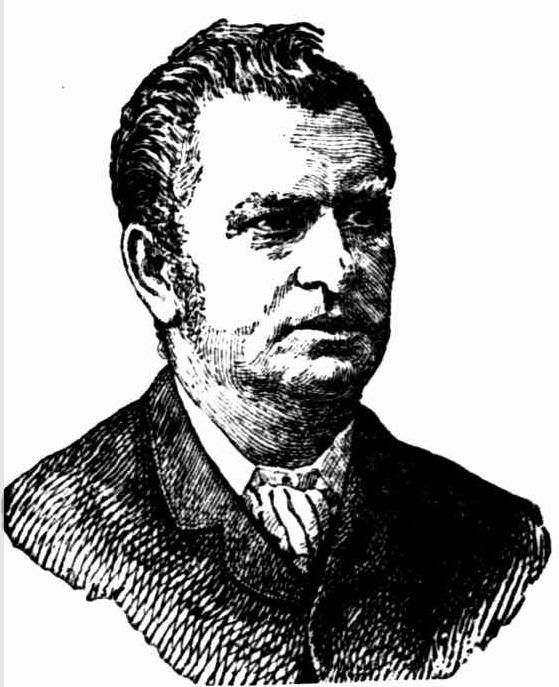
The Late Thomas Playfair.
Death of Alderman Playfair. SKETCH (1893, November 15). Evening News (Sydney, NSW : 1869 - 1931), p. 4. Retrieved from http://nla.gov.au/nla.news-article112936680
Alderman Playfair's Will.
Probate duty was paid to-day on the will of Mr. Thomas Playfair, who died at his residence, Darlinghurst-road, on November 15. The testator appoints John Baptist Bassetti, of Sydney, hotel-keeper, and his son, Thomas Arnold Playfair, trustees and executors. The amount was sworn at £32,515. To his son, Thomas Arnold Playfair, he leaves absolutely all the following: A dwelling house and premises known as Chelmsford, 61 Darlinghurst-road; two houses and premises, situated in Ridge-street, North Shore, known as Nos. 1 and 2 Earlscolne Terrace; a house and premises, situated in George-street north, known as 121 ; an allotment of land and premises, in Osborne-road, Manly; an allotment of land and premises in Playfair-street ; the horse, buggy, and harness used by testator, and silver stand presented to deceased when Mayor of Sydney in 1885. To his son Edmund John Bailey Playfair, testator leaves the house, butcher's shop, and premises, No. 103 George-street; two houses and premises in Ridge-street, North Sydney, a house and premises in Cove-street, Watson's Bay; two allotments of land in Playfair- street ; an allotment of land in Osborne-street, Manly. The goodwill of the butchering business and stock-in-trade is also left to Edmund John Bailey Playfair. To his daughter Jessie Playfair he leaves, free from interference, the house and premises known as No. 125 George-street north; a house in Ridge-street, North Shore, known as No. 5 Earlscolne Terrace; a house and premises in West-street, North Shore, known as Colchester; two houses and premises known as Nos. 1 and 2 Atherton-street, Sydney; the house and premises in Playfair-street; and the allotment of land and premises in Woods-street, Manly. To Alfred Donald Playfair, another son, is left the house and premises comprising 123 George-street North; a house and premises situated in Ridge-street, North Shore; premises situated in West-street, known as Chelmsford; two houses known as Nos. 3 and 4 Atherton-street, Sydney; the house and premises in Playfair-street; an allotment of land in Woods-street, Manly, known as No. 8, section 2, Cavendish Park Estate; and the allotment of land and premises situated at the corner of Ridge and West streets, North Shore. Alfred Donald Playfair also receives all deceased's jewellery. The rest of estate real and personal, is to be divided equally between the four children. Alderman Playfair's Will. (1893, December 18). Evening News(Sydney, NSW : 1869 - 1931), p. 5. Retrieved from http://nla.gov.au/nla.news-article112931831
Thomas Alfred Playfair, a member of the Legislative Council, of Gladwood Gardens, Double Bay, and chairman of directors of the Fresh Food and Ice Coy., in his affidavit, after referring to the 'Torch' article, said he was not !and never had been a member of the board of the Randwick Military Hospital. To his knowledge the hospital was controlled by the Repatriation Department, but with that department he had no connection whatever. The applicant Coy. did not supply milk to the hospital at, 1/10 per gallon, but was supplying at 1/4 a gallon under contract accepted by the department about five weeks before the making of the affidavit.
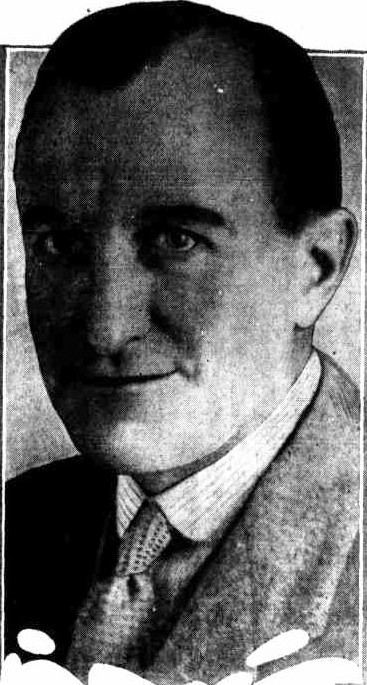
Thomas Alfred Playfair, Chairman of Directors of the Fresh Food and Ice Co., whose affidavit was read.
Fresh Food and Ice Company Limited. (1935, August 25). Truth(Sydney, NSW : 1894 - 1954), p. 17. Retrieved from http://nla.gov.au/nla.news-article169341915
References And Extras
- TROVE - National Library of Australia
- Shelagh Champion OAM and George Champion OAM, in their Profiles of the Pioneers in Manly, Warringah and Pittwater (1996 - revised 2013)
- Roads In Pittwater: The Barrenjoey Road
- Ingleside Powder Works
- Elanora - A Beautiful View From Which To Catch The Sea Breeze - Some Early Notes And Pictures
- The Macphersons Of Wharriewood: The William Joseph Macpherson Albums
- Leon Houreux
- Pittwater Restaurants You Could Stay At The Rock Lily Hotel – Mona Vale
- St Cloud Jersey Stud: Elanora Heights
- Waratah Farm: Ingleside - The Narrabeen Plum
Also Available:
- Pittwater Roads II: Where the Streets Have Your name - Scotland Island
- Pittwater Roads II: Where the Streets Have Your Name - Newport Beach
- Pittwater Roads II: Where the Streets Have Your Name - Clareville
- Pittwater Roads II: Where the Streets Have Your Name - Avalon Beach
- Pittwater Roads II: Where the Streets Have Your Name - Warriewood
- Roads In Pittwater: The Bay View Road
- Motor Car Tours To And In Pittwater Show Us The Way This Place Once Was
- Roads To Pittwater: The Wakehurst Parkway Along Old Oxford Falls Track
- Roads To Pittwater: The Pittwater Road
- Roads To Pittwater: The Sandspit Punt and Spit Bridge
- Roads To Pittwater: The Mona Vale Road
- My Holiday by Charles de Boos – 1861
1911 Real Property Act Applications - coincides with Tram Line extension and most on stretch between Narrabeen bridge and Collaroy Beach, the former Mount Ramsay Estate
No. 16,239. APPLICANT Maria Emily Mitchell, Narrabeen. LAND: —County Cumberland, parish Manly Cove, shire Warringah, 1 acre 1 rood .. perches and 2 roods 8 perches, in Victoria, Ocean, and Narrabeen streets—lots 1, 2, 15, and 16, section 33, and lot 2, section 34, Mount Ramsay Estate, and lots 1 and 6, section 33, Fuller's subdivision part Mount Ramsay Estate, and part 410 acres (portion 1,217 of parish) granted to John Ramsay; adjoining properties of Dr. Pope, O. J. Carr, and Mrs. Thompson or Mrs. McDonald. NOTICE UNDER REAL PROPERTY ACT. (1911, April 5). Government Gazette of the State of New South Wales (Sydney, NSW : 1901 - 2001), p. 1932. Retrieved from http://nla.gov.au/nla.news-article221617932
No. 17,0.58. APPLICANT:—George Scales, Manly. LAND:—County Cumberland, parish Manly Cove, shire Warringah, 1 acre 3 roods 33 perches, in Ocean street, Narrabeen,—lots 2 to 7, section 24. Mount Ramsay Estate, and part 410 acres (portion 1,217 of parish) granted to John Ramsay; adjoining property of Mrs. M. Thompson. NOTICE UNDER REAL PROPERTY ACT. (1911, June 28). Government Gazette of the State of New South Wales (Sydney, NSW : 1901 - 2001), p. 3480. Retrieved from http://nla.gov.au/nla.news-article226774250
No. 17,140. APPLICANTS:—Edith Mary Loder, Paddington, Edward Thomas West, Chatswood, and Ada Blanche Ellis, Chatswood. LAND:—County Cumberland, parish Manly Cove, shire Warringah, 13 acres I rood 1 1/2 perches, and 42 acres 2 roods 30 perches in Clarke, Mactier, Park, and Wetherill streets and on Narrabeen Lagoon,—lots 9 to 14, lot 14b, lots 15 to 20 and part lot 14a, section 20, lots 5 to 14, lots 14a and 1 in, and lots 15 to 28, section 20a, and blocks 1 and 2, Mount Ramsay Estate, and part of 410 acres (portion 1,217 of parish) granted to John Ramsay; adjoining properties of E. F. C. M. Sivyer, N.S.W. Realty Co., J. Wheeler, and N. Cooper. NOTICE UNDER REAL PROPERTY ACT. (1911, July 26). Government Gazette of the State of New South Wales (Sydney, NSW : 1901 - 2001), p. 3981. Retrieved from http://nla.gov.au/nla.news-article230684495
No. 17,120. APPLICANT:—Roland James Pope, Manly. LAND:—County Cumberland, parish Manly Cove, shire Warringah, 2 roods 214 perches, and 1 acre 1 rood 34 1/2 perches, Victoria, King, and Ocean streets,—lots 7 to 10 inclusive, section 33, and lots 7 and 8, section 34, Mount Ramsay Estate, and lots 9 and 10, section 33 of Narrabeen Lakes subdivision of part Mount Ramsay Estate, and part 410 acres (portion 1,217 of parish) granted to John Ramsay; adjoining properties of Dr. R. J. Pope, and M. Mitchell. NOTICE UNDER REAL PROPERTY ACT. (1911, August 9). Government Gazette of the State of New South Wales (Sydney, NSW : 1901 - 2001), p. 4342. Retrieved from http://nla.gov.au/nla.news-article230685054
No. 16,973. APPLICANT James Wheeler, Narrabeen. LAND : County Cumberland, parish Manly Cove, shire Warringah, 1 acre 1 rood 31 1/2 perches, 3 roods 18 perches, 1 acre 3 roods 1 perch, 3 acres 11 perches, 1 acre 3 roods 3 perch, 34 1/2 perches, 1 rood 30 perches, 35 perches, 2 roods 21 1/2 perches, 1 rood 30 1/2 perches, 2 roods 20 perches, and 2 acres 3 roods 11 perches, in Jenkins, Frazer, Ramsay, Stuart, Wetherill, Clarke, Mactier, Goodwin, Devitt, Lagoon, Wellington, and Park streets, and on Narrabeen Lagoon,—lots 22 to 28. section 8; lots 9, 16, 17, 18, section 11: lots 10 to 14 and 17. 18, 19, scction 12; lots 13 to 26, section 16; lots 12 to 15 and 18 to 21, section 19: part lot 14a, section 20: lots 3, 4, 7, 11, 12, 13, section 21: lots 12, 13. section 22: lots 5, 7, 8, section 26: part lot 2: and lots 3 to 8, section 42, Mount Ramsay Estate: and part 410 acres (portion 1,217 of parish) granted to John Ramsay: adjoining properties of J. Wheeler, R. Pfoeffer, C. A. S. Hayden, E. A. Powell, C. M. E. West, H. S. Haynes, E J. West, Mrs. E. M. Loader, A. E. Ellis, C. A. de Kantzow, D. McLean, A. O. West, H. H. Gordon, W. Pollard, W. S. Beale, W. A. Lipscombe, W. L. McFarlane, estate J. Langley, J. F. C. Goodridge, A. E. Dowling, W. Nicholls, T. H. Page, and G. L. Pring. NOTICE UNDER REAL PROPERTY ACT. (1911, August 30). Government Gazette of the State of New South Wales (Sydney, NSW : 1901 - 2001), p. 4711. Retrieved from http://nla.gov.au/nla.news-article230685900
No. 16.930. APPLICANT:—Herbert Edgar Mcintosh, Sydney. LAND:—County Cumberland, parish Manly Cove, shire Warringah, 4 acres 3 roods 36 perches, in Emerald, Lagoon, and Malcolm streets, and on Narrabeen Lagoon, whole section 60, Mount Ramsay Estate. and part 410 acres (portion 1,217 of parish) granted to John Ramsay. NOTICE UNDER REAL PROPERTY ACT. (1911, September 13). Government Gazette of the State of New South Wales (Sydney, NSW : 1901 - 2001), p. 4937. Retrieved from http://nla.gov.au/nla.news-article227592326
SHIRE OF WARRINGAH—SALE OF LAND FOR OVERDUE RATES
Form 9a (Ordinance No. 5)—Local Government Act, 1919
NOTICE IS HEREBY GIVEN to the persons named hereunder that the Council of the Shire of Warringah has resolved in pursuance of section 602 of the Local Government Act, 1919, to sell the land described hereunder of which the persons named appear to be the owners, or in which they appear to have an interest, and on which the amount of rates stated in each case is overdue for more than five years.
Owners or Persons having an Interest in the Land
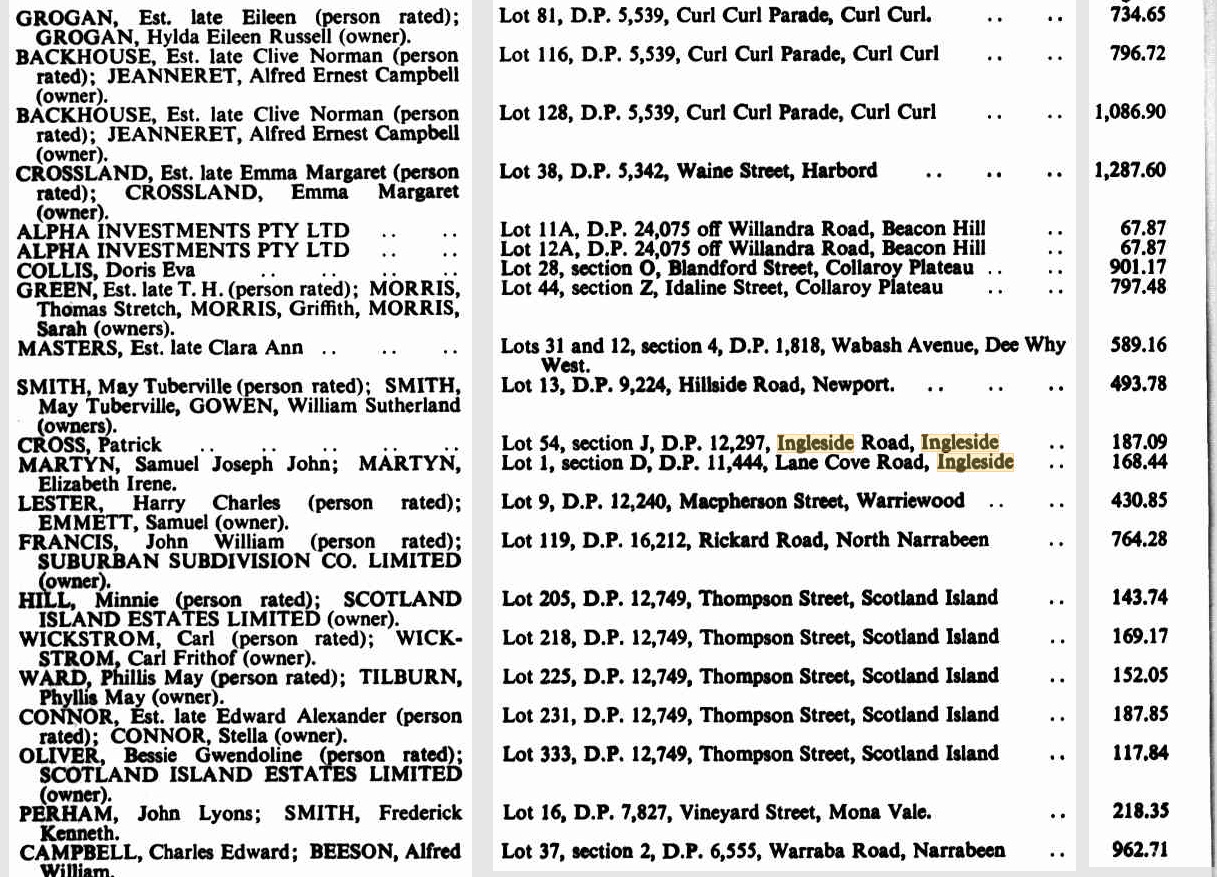
In default of prior payment to the Council of the rates due and in arrear the said land will be offered for sale by public auction by Weight & Co. Pty Ltd and L. J. Hooker Ltd at the Porta-Villa premises, 631 Pittwater Road, Dee Why, on Saturday, 9th November, 1968, at 10.30 a.m.
Shire Hall, Brookvale. J. MORGAN, Shire Clerk. 29th July, 1968. 8844—$35SHIRE OF WARRINGAH—SALE OF LAND FOR OVERDUE RATES (1968, August 2). Government Gazette of the State of New South Wales (Sydney, NSW : 1901 - 2001), p. 3160. Retrieved from http://nla.gov.au/nla.news-article220030632
The Great Railway Schemes
A subject that has been discussed even today is a rail connection to Pittwater, or Narrabeen or Dee Why to Chatswood along the thoroughfare that will lead past the new Northern Beaches Hospital.
Such notions have been around for a while - caused speculators to bu land in Pittwater at even the hint of a tram running to Narrabeen and unfortunately for one gentleman, Mr. Brock, meant the loss of a grand estate in 'The Oaks' at Mona Vale.
Some earlier schemes lend insights into the paths to and from Pittwater, in a round about way:
Camp Life at Field of Mars, Ryde.
The scenery of Ryde and its neighbourhood is of the most picturesque character, offering glimpses and peeps of diversified views, with variations of light and shade, charming in the extreme. Ryde parish church is an elegant structure, reminding us of the old English village style, and its graveyard contains many handsome tombs, placed by loving mourners to the memory of the departed. Ryde itself, is the nucleus of what will one day be a large and flourishing town.
The Field of Mars, portions of which our illustrations represent, is distant from Ryde some-thing less than three miles.
The " Government Party " Camp, Field of Mars, near Sydney, New South Wales.
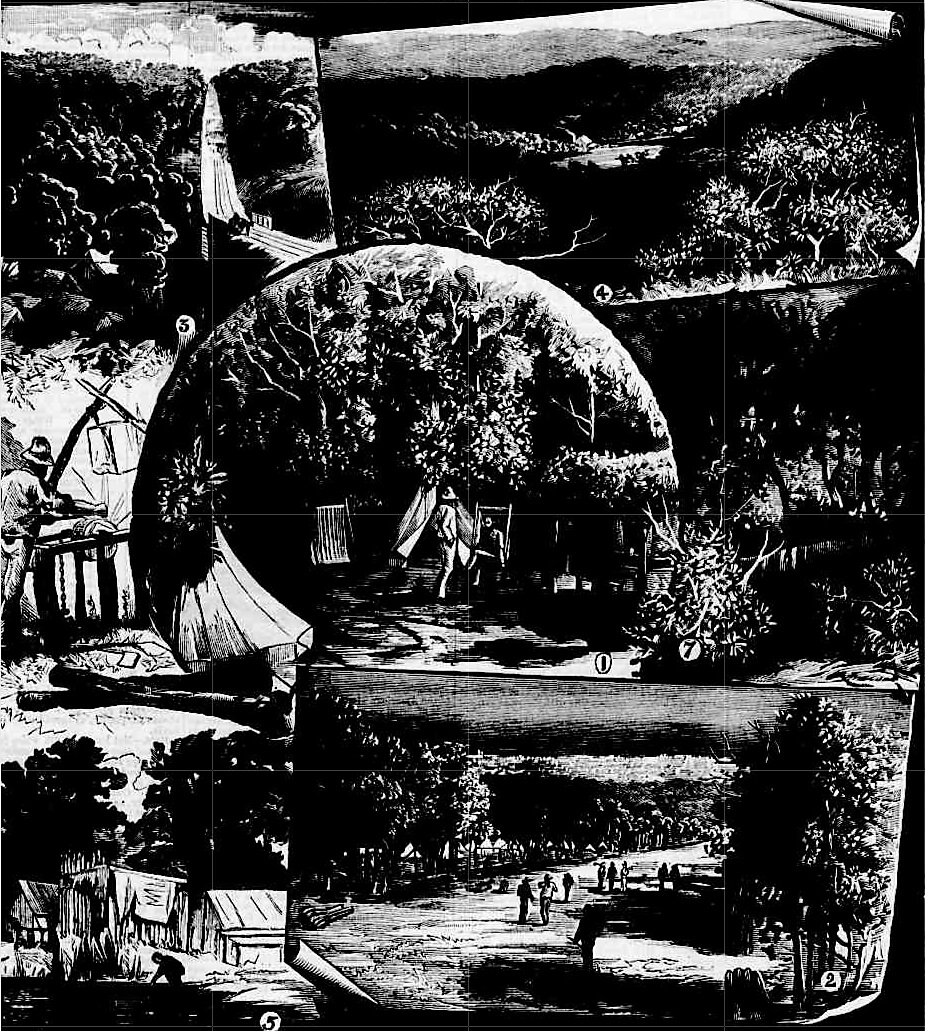
1. Overseer's' Camp. 2. Main Camp. 3. Pittwater-road (Tram Route to Parramatta). 4. Lane Cove River (seen from the Estate). 5. Camp on Kitty's Creek. 6. Grinding Axes. 7. Sylvan, Scene on the Kitty's Creek.
The Colonial Secretary, it may be remembered, at a critical period in the depth of winter, and owing to the disorganization of the labour market, through the late disastrous drought, which so severely affected the whole colony, felt himself called upon to give employment to some hundreds of " unemployed '' who thronged the streets of Sydney, and were reduced to great straits. The common of the Field of Mars has been cleared by some of these men, and is now surveyed and laid out in roads, streets, and allotments, the acreage" of the latter and the width of the former being defined and accurately shown on the maps. We have been informed that this splendid tract of land will be thrown into the market very shortly for sale by auction, as villa sites,and the situation of some of the sections, overlooking the Lane Cove River, are exceedingly fine. The wildness of rugged crags in shapeless grandeur and primeval form, offering a singular contrast to the soft foliage of the far away bush, dotted here and there with a solitary homestead, nestling in, and gleaming white against the dark background, and the placid river flowing at our feet.
The common is to be approached by a tramway which is to run through Balmain and Gladesville, crossing Stranger's Creek, where an elegant bridge is to be erected, the material for which is now on the ground. This tramway will traverse the common on its eastern side, then proceed in a northerly direction along a main road to Pittwater, and form a loop of a line to be taken from Ryde to Pittwater. The common of the Field of Mars is also comparatively of easy access from the Figtree Wharf on the Lane Cove River, and also by the Parramatta River from Ryde or Gladesville, from each of which it is about equi-distant. The acquisition of land here for villa sites, of an exceptionally pleasing and attractive nature, will doubtless have consideration from those in search of a retired and select location, and it is said the idea is to make this quarter very select-a second Potts Point in fact. On the ridges the soil is of good quality, fit for orchards and vineyards ; the timber is chiefly young mahogany, bloodwood, and gum. Other portions possess soil of the richest description, and for speculators will, no doubt, when offered for sale, be provocative of keen competition. There is a cemetery 27 acres in extent which has been thoroughly cleared, and is apportioned for the various sects and denominations, and will be shortley dedicated and handed over to trustees. From its centre may be obtained one of the prettiest views of the village of Ryde and its church.
Where it rises above the graves on the hill, Silent and sad, and sombre and still.
If the idea of the aristocratic officials to develop a fashionable suburb be accomplished, the piece of country -which has been cleared by the men who sought employment from the Govern-ment offers special advantages, easy of access, a salubrious climate, a rich and fertile soil, and exquisitely beautiful scenery. The roads are all open to excursionists, whether on horseback or by conveyance. Camp Life at Field of Mars, Ryde. (1884, December 13). Australian Town and Country Journal (Sydney, NSW : 1870 - 1907), p. 26. Retrieved from http://nla.gov.au/nla.news-article71021325
THE PROPOSED ST. LEONARDS TRAMWAY.
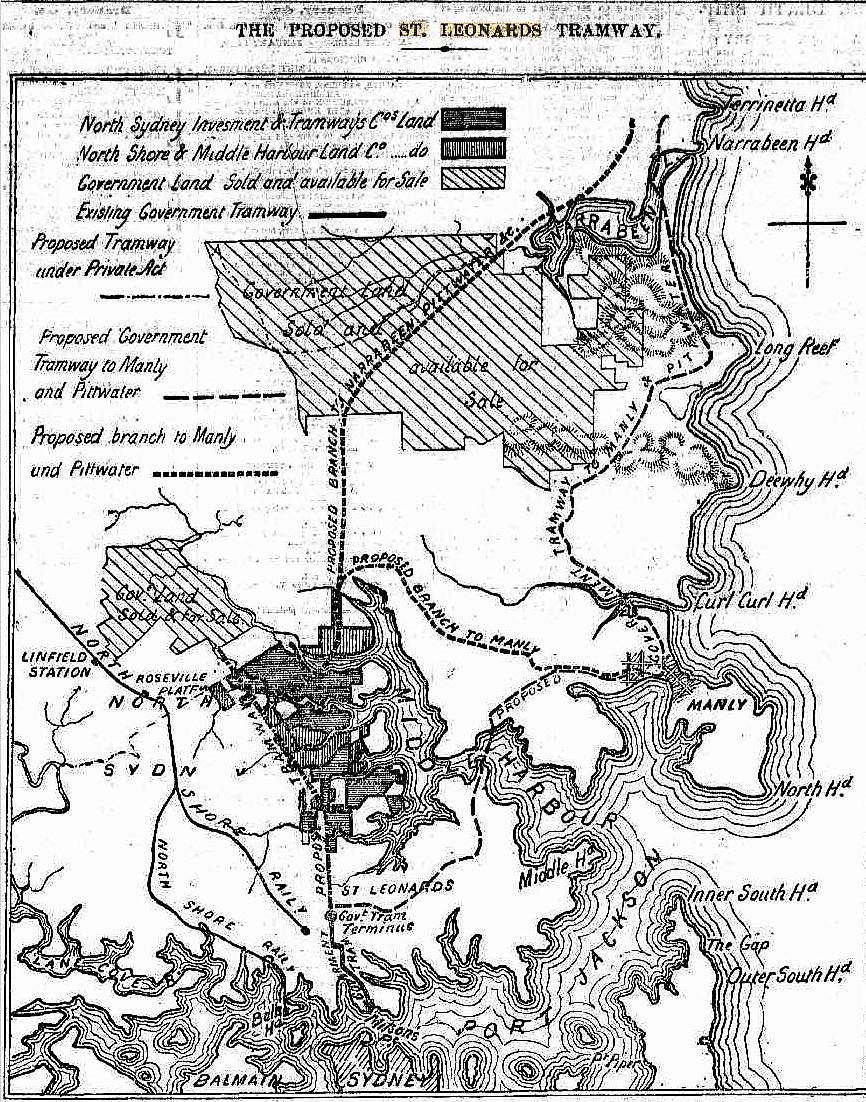
Though within easy distance of Sydney, very little is known of the magnificent charnpaign country lying contiguous to the many bays which are to be found in Middle Harbor, certainly the most beautiful portion of our beautiful harbor." The many who take the trip round the harbor, going up its glorious waters up to Green Cape, seen on either side steep, rock -guarded uplands, with a rich mass of verdure clothing them with perennial green ; but few have explored these uplands from the land side, or have any conception not only of the goodness of the land but of the magnificence of the views to be obtained from almost every point. Here, extending north of Si. Leonards, is a grand sanatorium— a large extent of country in its native state, consisting of undulating land covered with heather and thick undergrowth, running eastward towards the waters of Middle Harbor. Some time since this attractive area, which hitherto had lain idle, being cut into allotments mainly owned by one man, attracted the attention of two gentlemen who saw that bore was an opportunity of bringing these magnificent sites for suburban residences within easy access of Sydney, opening out country with the finest uplands, breezy and health-encouraging, running on towards the waters of Middle Harbor, and at the same time forming a straight route on to Pittwater and Narrabeen, two place which in the near future must become of increased importance, not only us holiday resorts but also as settled centres of industry. The idea was that a tramway line carried from the present terminus of the North Shore cable tramline at the corner of St. Leonards Park, straight along Miller-street, on through the municipality of North Willoughby to a point near the head waters of Middle Harbor would not only be a good speculation but would also be the means of bringing into existence a new' suburb, which in point of picturesque beauty of scene would outrival many of the beautiful outskirts of the city. A thousand acres of ground shown' in the annexed plan marked with horizontal and perpendicular lines were acquired by purchase by Mr. Andrew Armstrong and Mr. James Alexander Brown, each owning 600a., and after much consultation and many and varied calculations it was decided to get permission, if possible, from Parliament to construct a tramway to the extremity of the property so acquired. After some trouble the matter was brought before Parliament, and on July 18, 1887, an Act was assented to authorising Messrs. Armstrong and J. A. Brown to construct and maintain a tramway along the proposed route.
The description of the tramway in the Act is from the terminal point of construction of the St. Leonards cable tramway, along Miller-street, Palmer-street and Bellevue-street, in the town and municipality of St. Leonards, and through certain private land, across French's-road, Mowbray-road, M'Lellan-street, -Victoria-avenue and along Murano-road, in the municipality of North Willoughby. It was specified in the Act that the tramline should not occupy in any part of a road or street a greater space in breadth than 22ft. including the support and foundations ; that it should be constructed and brought into use within three years from the passing of the Act and constructed In a workmanlike manner that nothing should impair the lawful authority of the municipalities of St. Leonards and North Willoughby or of any other corporation to construct, maintain and preserve gasworks, water works, sewerage works and other works lawfully constructed under ground ; that the gauge of the tramway should be 4ft. 8 ½ in. that it should be laid with rails subject to the approval of the Commissioner for Railways; "that the promoter should maintain in perfect order the tramway and the pavement of the streets between the rails and for the space of 1ft. Oin. on each side of the rails, and should erect all necessary causeways ; that they should emptor electricity, locomotive engines, stationary engines with cable connection, horses, or other moving power ; that they should be responsible for all injuries caused through negligence or improper construction ; that regulations should be framed, but none or' them should authorise the closing of the tramway between sunrise and sunset, except at any time when In consequence of any of the works being out of repair it should be necessary to close the line or any part of it ; and finally, that the Government should have power at any time to purchase the line at its then assessed value.
After this the land, which had been purchased by Messrs. Armstrong and Brown, who were the real fathers of the scheme, attracted the attention of a number of capitalists, and two companies were formed, who in December, 1887, and January, 1888, acquired the whole of the land. The first of these was styled the North Sydney Investment and Tramway Company, with a nominal capital of a million sterling, and the land owned by them is shown on the map marked with horizontal lines. The second company the North Shore and Middle Harbor Land Company, with a nominal capital of £1500,000, has its property distinguished by perpendicular lines, and as will be seen, this company own two pieces of land away from the proposed tramline, the one to the left an area known as the Royal Park Estate, and the other an allotment 270a, in extent on the opposite side of Middle Harbor, near where there is a further proposal to erect abridge for a road or train extending from the proposed line. This area of ground which has been bought with a view to further, development has a water frontage on the main waters of Middle Harbor, commencing at a point situated just above a small cove, where the steamers plying usually turn and close to an exquisite spot — a crag bound little peninsular extending to the water, covered with a beautifully green carpet of turf surrounded by rich and variegated, woodland foliage. This spot was a favorite resort of Sir Hercules Robinson when Governor of New South Vales, and he and his family and friends were wont to come here picnicking. The whole of this property, owned by two companies, is well adapted for residential purposes. The total length of the proposed line is about three miles and a half, the distance from the present cable tram terminus to the bridge at Long Bay being one mile, and it is stated that will present but few engineering difficulties.
THE LAND PASSED THROUGH.
Hitherto the whole of the large area of country situated within the boundaries of the borough of North Willoughby, and extending back to the parish of Gordon, has been to a great extent cut oft' from communication with Sydney in consequence of the rugged gorge formed by the waters of Long Bay, the southernmost arm of Middle Harbor, the waters of .which extend a long distance westward, terminating in what in summertime is a Huge canon with steep sides, mid at whose bottom lie huge boulder, through which the course of g . creek 'is discernible, its existence being marked only by. here and there a limpid pool of water and its sides, rough, uneven land, which might be utilised without trouble, and on the slopes of which arc dotted here and there a number of residences of all kind, some of them of the most primitive type. The design of the proposed tramline, which is to be at once proceeded with, is to bridge this chasm and to open out in the first instance the areas running on the one side out through the territories included in the borough of North Willoughby comprising the lauds through which the railway to Crow's Nest runs, and on to the unimproved and at present, owing to the unwillingness of the proprietor to sol unimprovable, estate owned by Mr. David Berry, the whole of the original grant known as .Wolstoncrofte, and on the other the areas running eastward to though shores of Middle Harbor and its numerous offshoots. This latter is comprised in four distinct ridges ; the first and the largest of the four in point of area, bounded on the south by Long Bay and on the north by Mowbray Bray : the second between Sailor's Bay and Sugar Loaf Bar ; the third a beautifully-situated promontory on either side of what is known as Sugar Loaf Bay ; and the fourth washed on either side by the main waters of Middle Harbor up to beyond its navigable waters. This is in effect the design, of the first portion of the scheme shown on the plan, but its extension is contemplated on to Pittwater with a detour to the west to Manly.
Taking the tramline as proposed, the first portion will run from the present terminus of the cable tramway, (by the Government) at the south-western corner of St. Leonards Park along Miller-street for a -distance of a little over a mile to the waters of Long Bay, and will bring into direct and near communication with Sydney the whole of the northern portion of the borough of .St. Leonards, as on either side of the. line there is a large population, with spacious well-formed streets. The whole of the land to the left of the line is portioned off into streets up to the boundaries of the Berry Estate, a small portion of which has been alienated. And on this stand numerous residences and places of business, besides several public buildings, including the pretty cottage hospital—a credit to the borough, which was formally opened by Sir Henry Parkes less than a year ago. To the right of the line is the St. Leonards Park — a well laid out public reserve —which is yearly being Improved; while beyond, a little, further to the westward, below Ernest-street, is situated Cammeray Park, a triangular piece of ground through which passes a road leading to Cammeray Point, whilst in a once sequestered nook, which has been of late invaded by a tramline leading to Borne quarries at the extremity of a little harbor is situated Folly Point, approached by a road formed by the St. Leonards corporation, a favorite boating and fishing resort, but which is not. used as it might be owing to the difficulty of access from Milson's Point. The gorge at Long Bay is to be crossed by a handsome suspension bridge, and after crossing this the line enters upon the territory of the borough of North Willoughby.
At present the only means by which this borough can be reached from Milson's Point direct is by the Sydney-road, a well-formed thoroughfare, whilst the bay as it is still called, though it really is a creek, dry in summer but a roaring torrent after heavy or even moderate rains, has been spanned through the energy of the North Willoughby Council by a massive stone bridge, which cost somewhere about £5000. Near here, perched on the heights, are the residences of Mr. Thomas Datton, M.P., and Mr. Douds, M.L.C. Passing over the bridge the road ascends, and though the land is pleasant and the scenery delightful there is not much settlement until what is known as the Central Township is reached, a beautifully laid out little village, where there are numerous pretty residences and a large tannery, the most extensive to be found around Sydney, owned by the Messrs. Forsyth, who have taste-full villa residences in the vicinity. The whole of the rest of the country to the westward of the land, including Mowbray Park, the township of North Sydney, Alleyne Park, the Artarmon Estate and numerous other allotments — some merely fenced in, others lying waste, and others again built and settled upon— is a rich country, where gradually people are finding their way, and which only wants an impetus such as a tramline should impart to make it one of the gardens of New South Wales. As an instance of progress, it may be stated that out in this now distant and but little-known suburb, at a spot whore there is but a straggling population, Mr. Museton is meeting a line hall to be called the Centennial.
But after all in connection with the tramway, it is the land situated to the eastward, with some seven miles of frontage to Middle Harbor and extending from Long Bay to the topmost arm of the harbor, which will give it Its chiefest charm and value. No finer views are to he obtained near Sydney, and the combination of water and wood and tree and fern, upland and valley and clear heathland and rocky defiles, clothed with all the rich flora and ferns of New South Wales, are all beautiful. The whole of this country is owned by the two companies who hare taken in hand the task of constructing and carrying on the tramway, with the exception of a few stray allotments which are shown in our plan, and several valuable reserves which have been retained, but never up to the present time used by the Government. The first ridge through the extremity, of of which the tramway will pass is bounded on the south by Long Bay, with a curious inlet known as Saltpan Creek, which many years ago was looked upon us a natural dock, and which it was intended should be used for Government purposes. This is included in a large reserve designed partly for a site for harbor defences and partly for a training school for boys from the ship Vernon, but up to the present it remains wild and unimproved. The whole of the land on this peninsula has been partially cleared and a fine roadway formed, whilst from a lofty dome-shaped hill which rises abruptly from the surrounding plateau an attractive view of the harbor and its tributaries is to be had. Below, abutting sharply on the water is Figtree Point, a well-known resort by persons voyaging into these waters, and at the northernmost extremity of the promontory a piece of laud known ns Albert Town, with a park reserve adjoining, to which the rood, which has been formed partly by the company and partly by the borough council, descends. Opposite is the curious point known as Quaker's Hat and a rich flat, which some time or another must become valuable. All the land on this area is well adapted for residential sites. The ridge beyond this is intersected by Mowbray-road, and the character of the land is similar, though in parts more rugged, while the scenery as we advance northward assumes a bolder and more mountainous character, softened always by the glorious stretch of water which spreads itself in all directions, terminated by lovely bays and rich campaign areas. The most northerly of the ridges, and by far the most beautiful, is at present approached by the Teralba-road leading from Alleyne Park and descending to the bond of Sugarloaf Bay, where there is a considerable settlement. A creek runs in to the bead of the buy, and along its banks are two tanneries and a number of pretty residences, all surrounded by gardens and orchards; in fact, everywhere in this fertile region fruit trees seem to flourish to an astonishing extent, and wherever the hand of man has been at work luxurious gardens are to be found. On the heights to the southward of Sugarloaf Bay, near Mount Wilson, there is a large Chinese garden of some 21 ha., owned by a man who in years past was a celebrity amongst his countrymen, one Chenateak, and here a large vegetable trade is done. At the back of the garden there is a joss house which is used by the numerous Chinese gardeners, who have made for themselves a home in various likely spots throughout the borough of North Willoughby— In fact, wherever water was to be found.
The proposed tramway terminates on a crested hill, known as Echo Farm, after crossing a rock-embrasured creek which just below the tramline passes through a series of rocky' basin, and then tumbles over a precipice, forming n waterfall some 70ft. or 80ft., the sides of this narrow gorge, only about 10ft. in width, being covered with ferns and every species of flora and shrub. As opening out this magnificent country and thus bringing within easy reach a land but little known either to the tourist or the resident of Sydney the tramline proposed, apart from any profit it must bring to the companies who have obtained permission to construct It, must be regarded as a public benefit." Its extension, as contemplated, on to Manly and further afield to Narrabeen and Pittwater, in lieu of the line proposed through St. Leonards and across the Spit by means of a bridge, is a matter only of time. THE PROPOSED ST. LEONARDS TRAMWAY. (1889, January 19). The Daily Telegraph (Sydney, NSW : 1883 - 1930), p. 9. Retrieved from http://nla.gov.au/nla.news-article235866189
The bridge referred to above was originally called the North Sydney Bridge. The depression of 1892 saw both companies go into liquidation and at that point the name Northbridge began to appear. This downturn was caused by a number of factors including a severe drought, the sinking of wool, wheat and metal prices, and most of all, the withdrawal of British investment in NSW on a major scale.
The plan for a train to Pittwater persists:
TURNED DOWN. A SUGGESTED RAILWAY. GORDON TO PITTWATER.
In ten years time you might have a chance: to-day you have none. This in effect was the reply made yesterday by the Minister for Works to a deputation which waited upon him with a request that he would favourably entertain the building of a railway from the North Shore line in the neighbourhood of Gordon or Pymble across to Pittwater with Broken Bay as the final objective. The deputation lacked nothing in numbers. There was a strong representation of the Kuringai and Warringah Shire Councils, of the Kuringai Ratepayers' Association, and of the Pittwater Progress Association It was introduced by Mr. Wade who with Dr Arthur emphasised the advantages to be derived from the construction of the proposed line. Dr Arthur enlarged on the advantages of throwing open for settlement country that from the standpoint of hygiene lacked nothing. It would be an ideal district he said for testing the Government scheme for erecting workmen’s homes. The land lay from 600 to 700 feet above sea level the surroundings were most picturesque and it lent itself well to drainage and sanitation. Since Sydney was increasing at such an enormous rate people would be driven more and more Into the Suburbs and he thought It would be a pity to compel them to seek homes along the low lying parts served by the Western line or along the shores of Botany Bay when such elevated and beautiful country as that lying between the North Shore line, and the ocean could be made accessible.
The Rev. Paul Clipsham president of the Kuringai Shire Council said the country lying between Gordon-Pymble on the one side and Narrabeen-Mona Vale on the other rivaled In its beauty anything to be seen on the Blue Mountains. He had not the slightest doubt that if the line were constructed it would develop an enormous passenger traffic. A line 17 miles long would open up the district well and seeing that there are no engineering difficulties to be overcome, he did not think It would be an expensive line to build. Apart from that it would greatly enhance the use of Crown lands through which the railway would pass. In all probability it would pay almost from the start. It would run through St Ives one of the most thriving fruit growing districts in the state. It would carry heavy consignments of fruit to Sydney and doubtless when communication with Broken Bay was opened up much of the fish supply of Sydney would be carried by It.
Messrs Ralston (president of the Warringah Shire Council) Griffiths, T. W. Taylor, Jones (secretary Pittwater Association) and R D Brown also addressed the Minister In Support of the railway project.
It was pointed out that Broken Bay would play an important part in any scheme of defence and that under these circumstances the Defence Department of the Commonwealth might be prepared to contribute to the cost of the maintenance of the line.
The Minister for Works said one of the stock arguments used by advocates of railway projects was the bearing the line would have upon defence. His business was to build lines not for defence purposes but for the development of the country. If however, there was anything in the suggestion that the Defence Department would pay part of the cost of a line to Broken Bay he would of course go carefully into the matter. He did not need to be told anything about the beauties of the country through which the proposed line would pass. He knew the country and it was the most beautiful country he had ever seen. It was to Australia what the Riviera was to Southern Europe. But he could not give the deputation a very encouraging reply. In time the railway would he made but he could not see his way to regard it as one of pressing necessity. Apart from that it would be enormously costly. The North Shore line cost £55 300 per mile and on that basis it would cost over a million to build the 20 miles to Broken Bay or if the line stopped at Mona Vale the cost would run to three quarters of a million. That was an enormous sum to spend to open up even so beautiful a district as the one in question. It would be a very fine thing for the landowners of the district whose property would be enormously increased in value. The State would get little out of it seeing that barely 1 ½ miles of the line would pass through Crown land. If the railway were justified on other grounds he would not object to making the fortunes of the landowners of the district.
But it was not Justified seeing the larger areas of unoccupied land to which the North Shore line gave access. Within 1 ½ miles of Wahroonga station alone there were hundreds of acres of primeval bush and the same thing applied to other stations along the line. The land was being held by owners, waiting for fancy prices. That land must be settled before the line to Pittwater could be considered. It was the policy of the government to spend what money it could get in building railway to open up wheat and agricultural country.
That was obviously more urgent work than building a railway into residential country which already had a railway on one side and would have an electrical tramway on though other side. It was proposed to have the electric tram service extended to Mona Vale. The line would be built off the road and In order to secure a speedy service the stopping place would be at Intervals of quarter or half mile. For quite a number of years that is all the residents could expect to get. The railway would come some day. Perhaps if the deputation waited upon the Minister 10 years from now they would probably get a more encouraging answer than he was able to give. TURNED DOWN. (1911, November 21).The Sydney Morning Herald (NSW : 1842 - 1954), p. 7. Retrieved from http://nla.gov.au/nla.news-article15290696
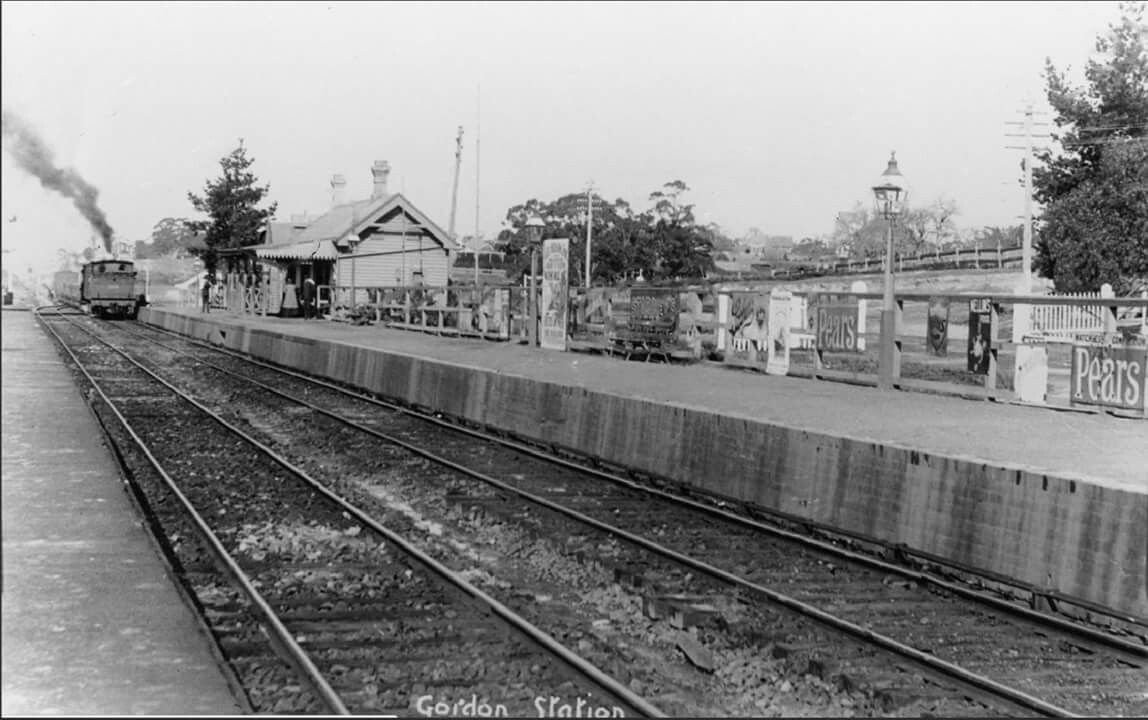
Photo: Gordon Railway Station, in the Upper North Shore of Sydney in 1907, courtesy State Library of NSW

Photo: sections from 1905 Parish Map of Narrabeen showing railway dotted line - that was rejected - and 'The Sugarloaf - this section at Terrey Hills part of map also shows 'James Terrey & Philip Spies' owning section of 640 acres previously held by Obadiah Terrey
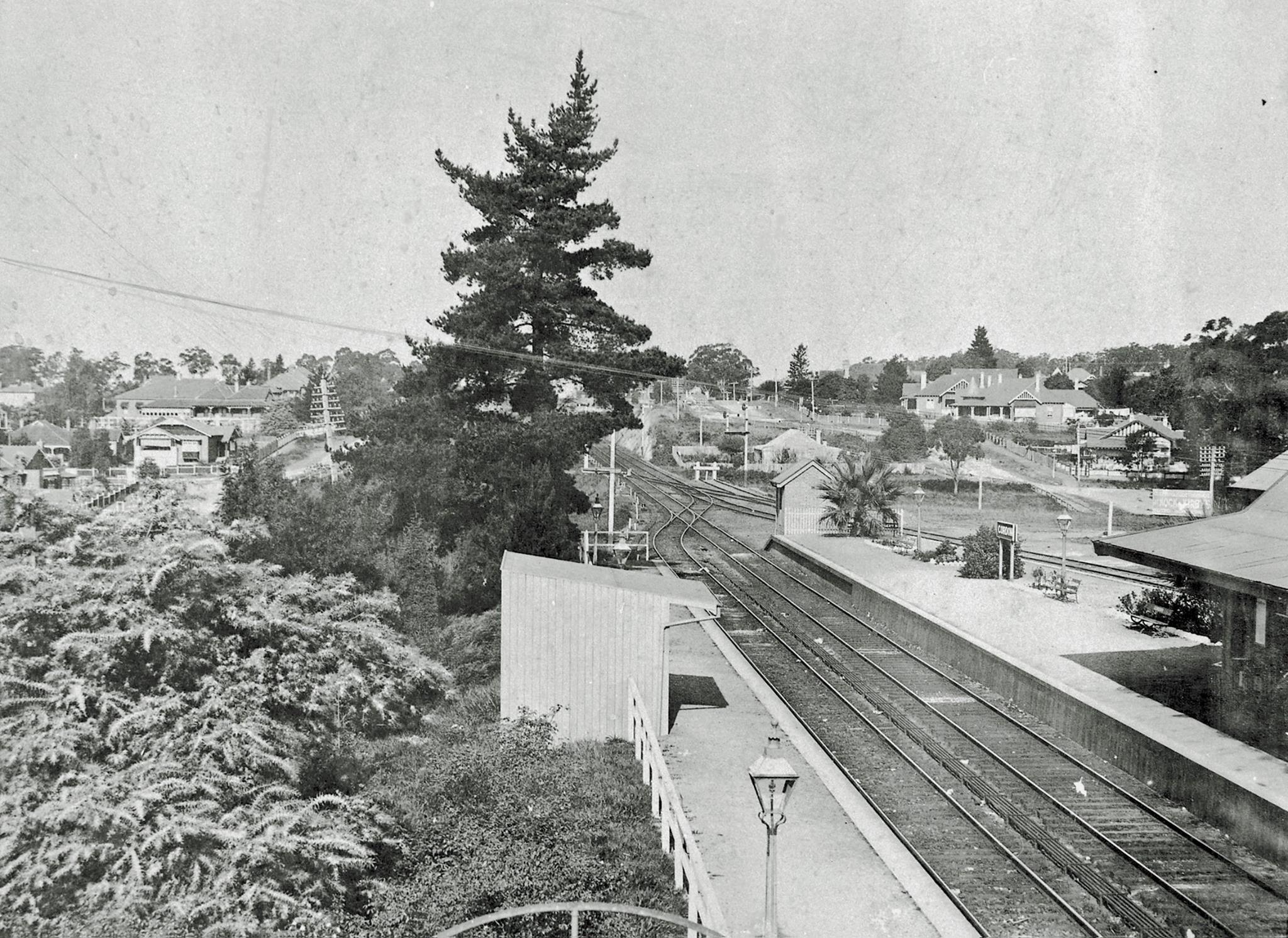
Gordon Railway Station ca.1917. Shows a view of Gordon Railway Station looking towards Killara. The Station platforms, waiting shed, gardens and gas lamps can be seen. Gordon Station was opened on January 1, 1890 when the North Shore Line began operating from St Leonards to Hornsby.

The Baha’i Temple
In 1955, 2.83 hectares at Ingleside just west of Waratah Farm was purchased by the Baha’i community. This site was purchased specifically because of its high elevation and visibility. Today the Baha’i Temple dominates the horizon of the Northern Beaches and can be seen as far away as the Central Coast.
The Baha’i faith, established in Persia in 1863, was brought to Australia in 1920; but the Ingleside site provided the faith’s first house of worship in Australia. The building’s initial concepts came from Charles Mason Remey, but the design and the construction supervision of the Ingleside temple was by the Sydney architect John R Brogan. The temple was constructed between 1957 and 1961.
The structure has nine sides and nine entrances symbolising the gathering together of all mankind irrespective of race, religion, nation or class, according to the beliefs of the Baha’i faith. The importance of the number nine relates to it being the largest single digit number which symbolises comprehensiveness, oneness and unity. The nine sides of the temple with its nine entrances also are symbolic of providing access to the nine religions of the world. The scale of the temple is suggestive of a monument to be ‘viewed from afar’ with there being an exaggeration of certain elements; for example, the windows at the base of the dome measure 22 x 13 feet (approximately 6 x 4 metres), almost two-thirds the height of the surmounting dome.
Shoghi Effendi, known as the Guardian of the Baha’i faith, considered that the domes of three buildings—the Baha’i Temple in Haifa, the Shrine of the Bab (also located in Haifa) and St Peter’s in Rome—were beautifully proportion and suitable for his new temples. He personally supervised the design of the Sydney building with all plans sent to him for approval. Domes also represented the ‘Dome of Heaven’, and an invocation to God in Arabic script (translated as ‘O Glory of the All-Glorious’) lies within the apex of the dome in the Ingleside temple.
Brogan worked closely with his engineer, Peter Docker (of Docker and Smith) on finishes, structural concerns and the sequencing and methods of construction. As much of the construction of this building was experimental in nature, many architectural details were drawn up on site and, as such, besides the initial sketch plan, the engineer’s drawings remain the only representation of the Temple ‘as built’.
One of the innovative features involved in the construction of the temple was the method used to obtain an exterior surface finish of white quartz (in the form of a panel, pre-cast on site and fully integrated with the structure). This method, known as the ‘concrete aggregate transfer method’, had never been used in Australia before on such an expansive area.
Following the construction of the concrete dome which reached almost 40 metres above the foundations, a lantern made of heavy gauge aluminium needed to be placed at the apex of the dome. This culminated in the historic placement by helicopter of the lantern on 27 April 1960. This was the first structure in Australia to have a building component positioned by an airborne machine.
The site had no water supply and so part of the design of the structure incorporates as 1.2 square cavity within the circumference of the dome which acts as a water storage tank with a capacity of several thousand litres.
The construction of the temple attracted the attention of the media, the building industry and university students. Local and Sydney papers printed articles on its progress and on August 1 1960, TCN9 showed three minutes of coverage on its local news broadcast.
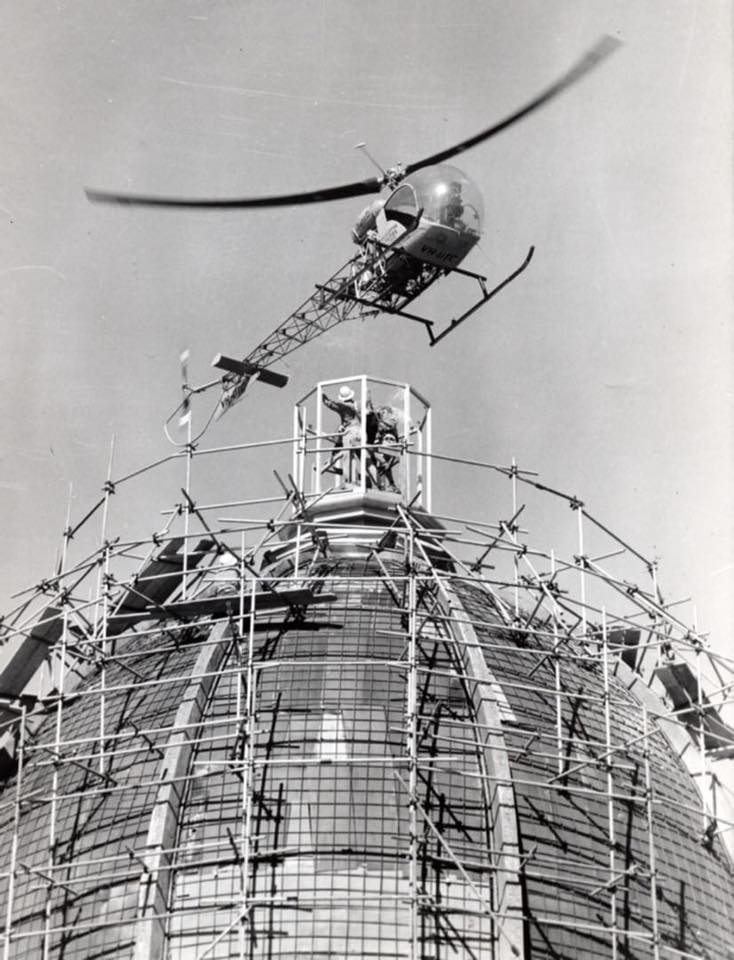
This great photo is from Kim Harrington. This is a photo of her dad when they lifted the Baha’i Temple lantern structure in place on top of the dome by helicopter back in 1961. It was the first time a helicopter had been used in building construction in Australia and attracted a lot of attention and a great deal of publicity at the time.
The Sydney Baha’i Temple was the third Baha’i Temple built worldwide, the first being in Wilmette, Illinois in 1953; and the second in Kampala, Uganda in January 1961. There had been an earlier temple built in Turkestan in the early 1900s, but this temple was expropriated by Soviet authorities. These early temples were all based on similar design principles. The Sydney temple has most similarities with the temple constructed in Wilmette, Illinois.
John R Brogan (1904–1987)
John Brogan was educated at Fort Street Boys High School in Sydney and at the age of 16 was indentured to an architectural firm, attending lecturers at Sydney Technical College in Architecture and Building.60 He graduated in 1927 and entered the large practice of Ross and Rowe, working initially on the Commonwealth Savings Bank in Martin Place. In 1928 he won the ‘Ideal Home Competition’ and following this received many commissions for new homes. During the Depression he designed many retail stores and associated buildings for Burns Philp and Co in Fiji, Samoa and New Guinea. Brogan commenced in a private practice in 1934 which was substantially domestic in character; and published the book ‘101 Homes’ consisting of pencil and ink drawings which he had previously contributed to Building Magazine. During this period he also designed several flat buildings, factories, and warehouses.
In 1958 Brogan made his first and only foray into religious buildings when he was asked by a friend and Baha’i member, Stanley Bolton, to become involved in the design and construction of the Baha’i Temple at Ingleside.
Mr. Brogan retired from practice in 1973 and his work was carried on by his two sons, one of which, John M Brogan, continued to be involved in the repair and upkeep of the Baha’i Temple in Ingleside.